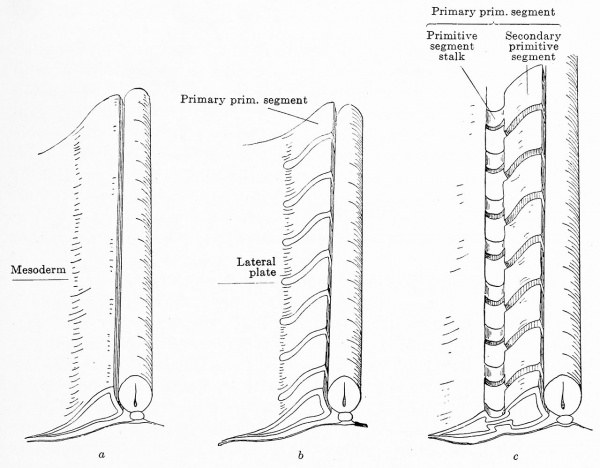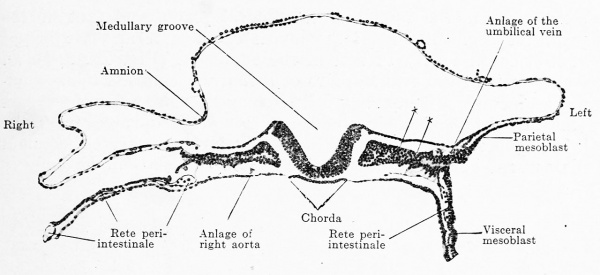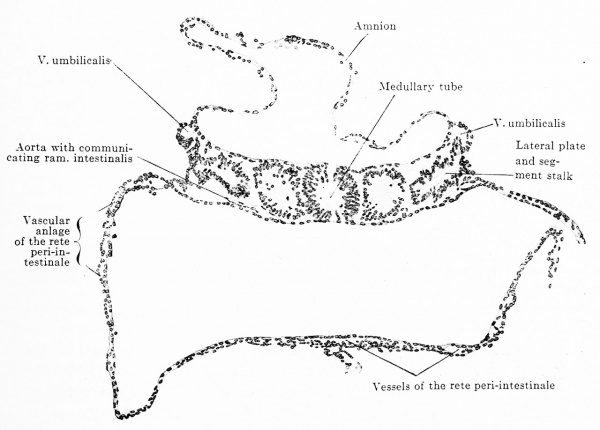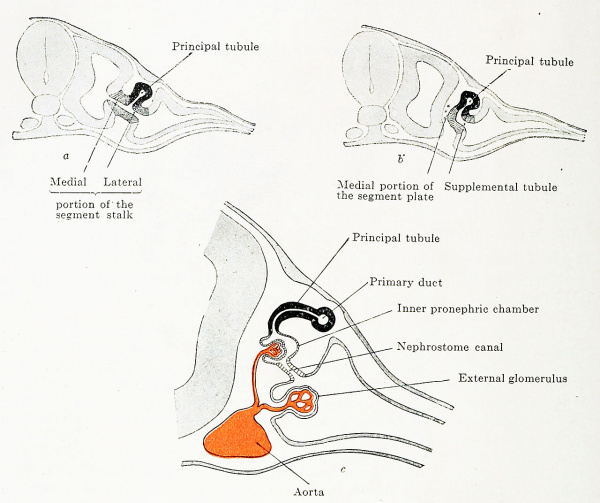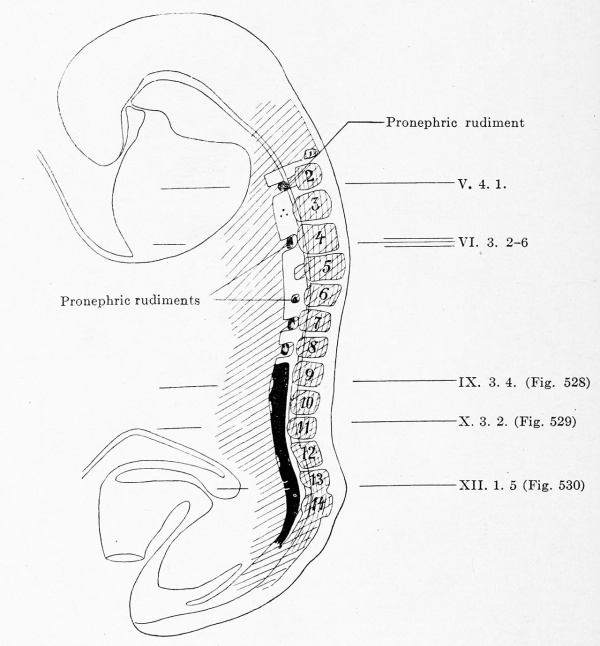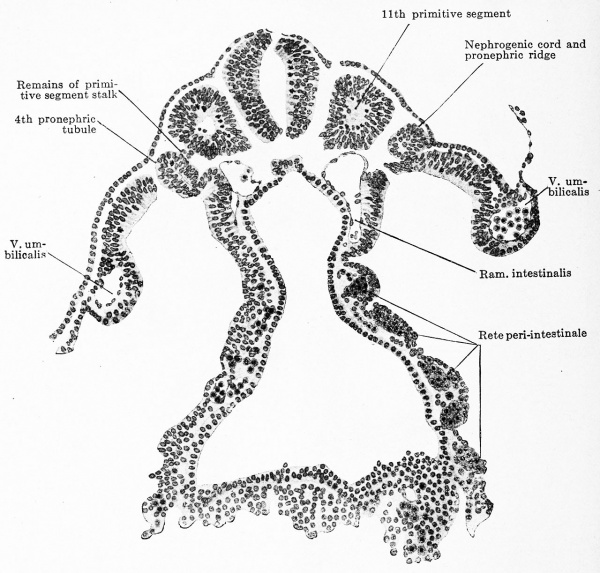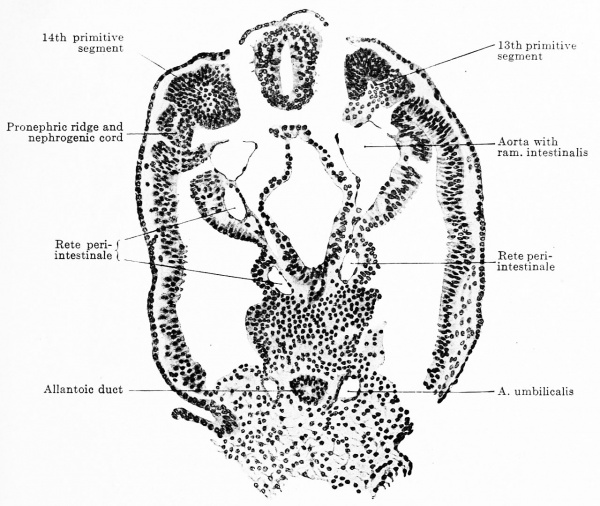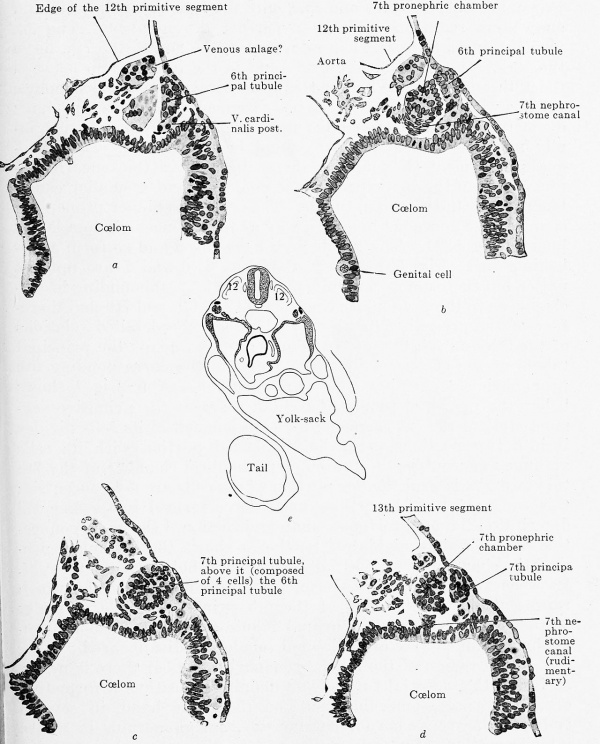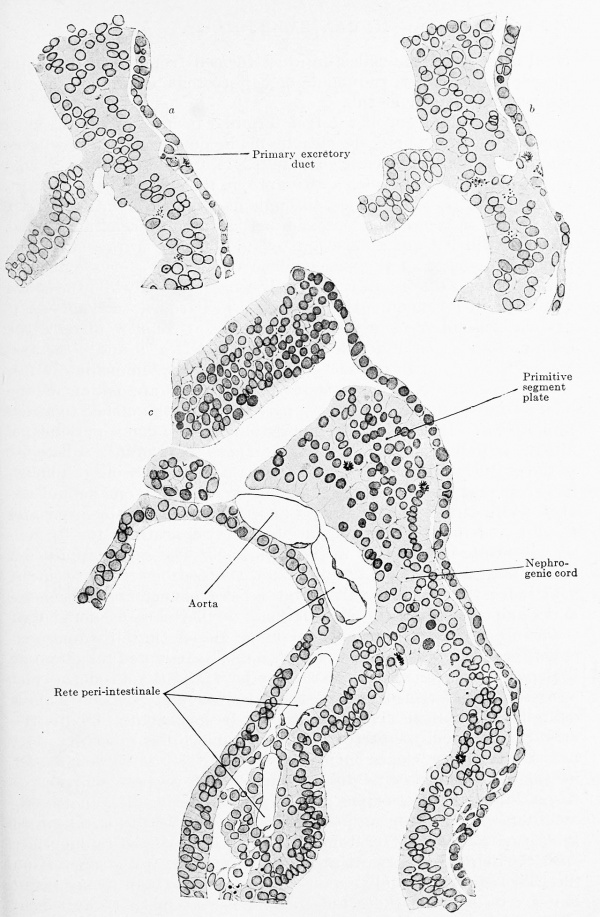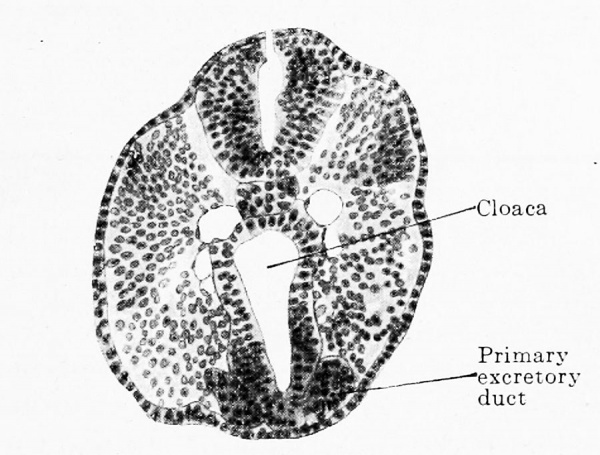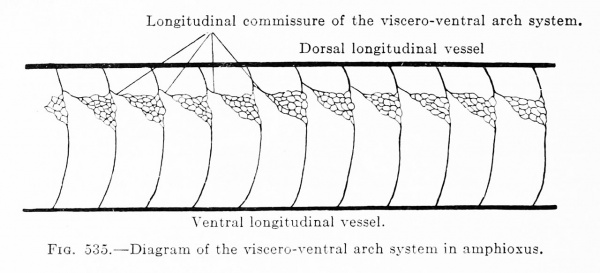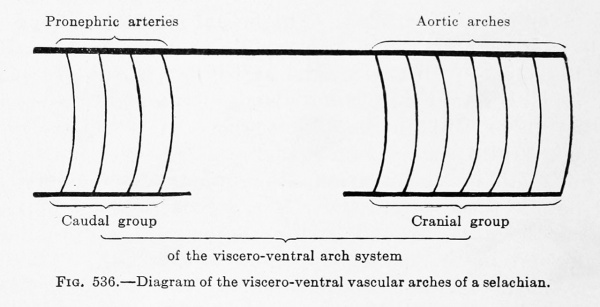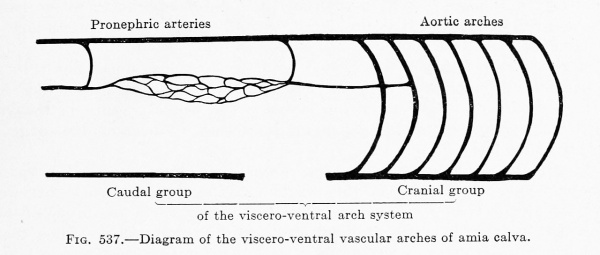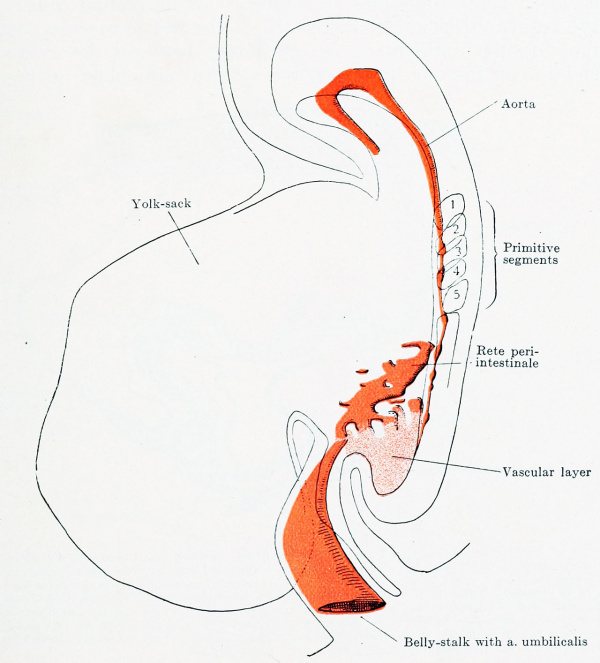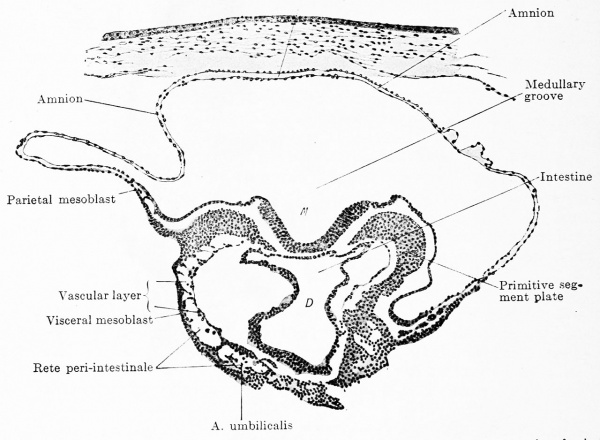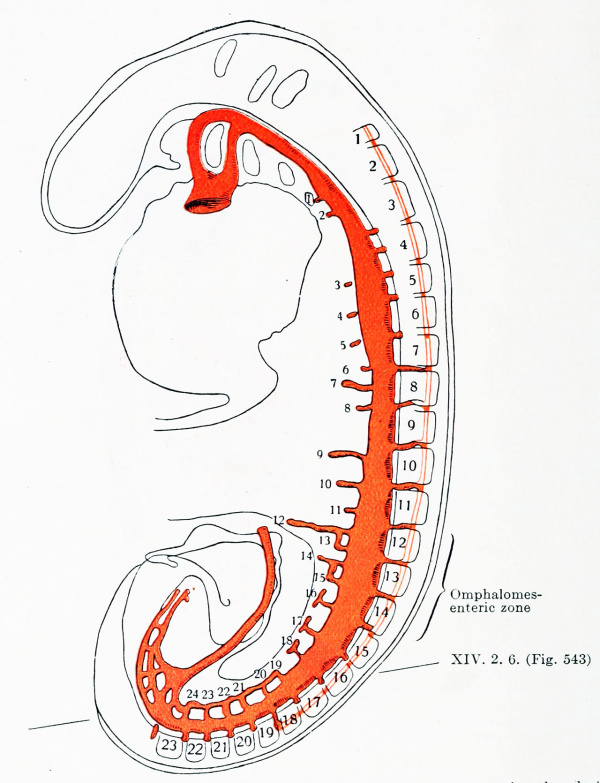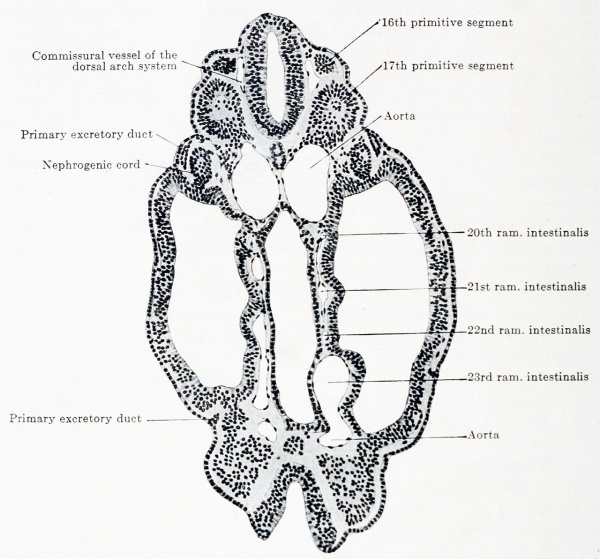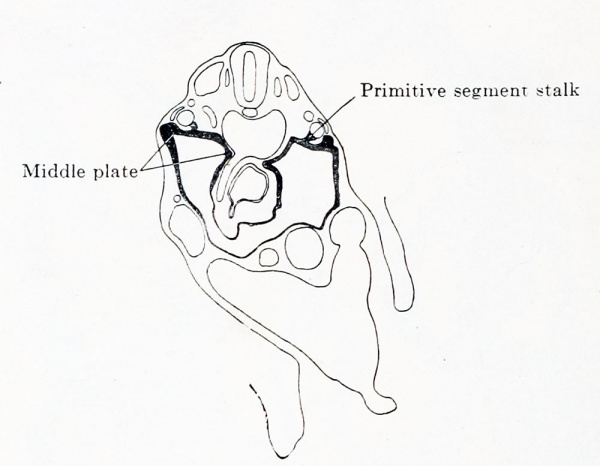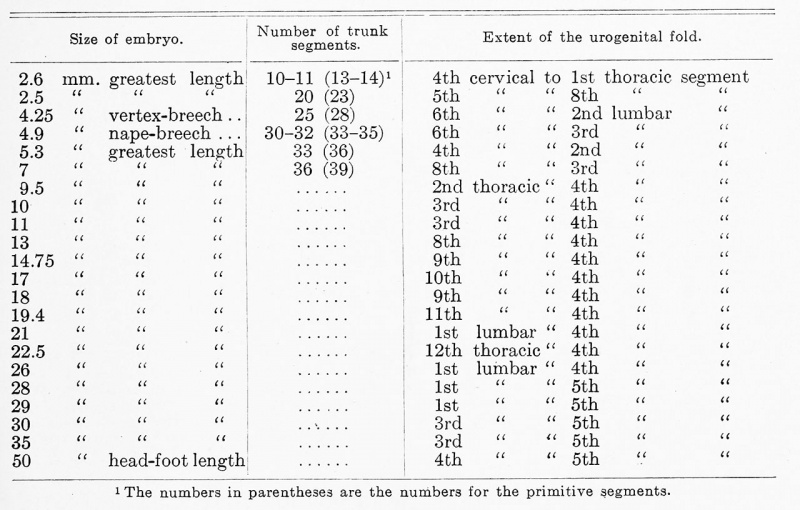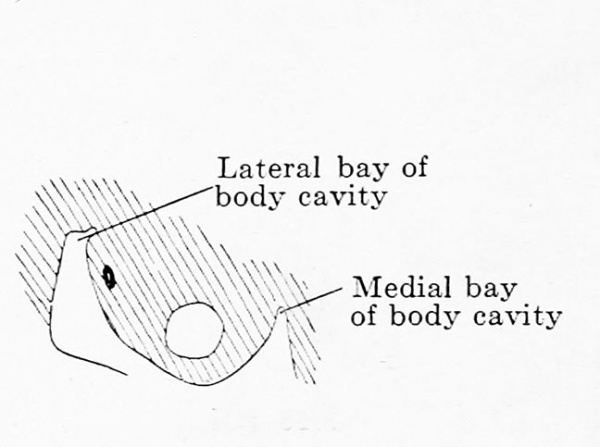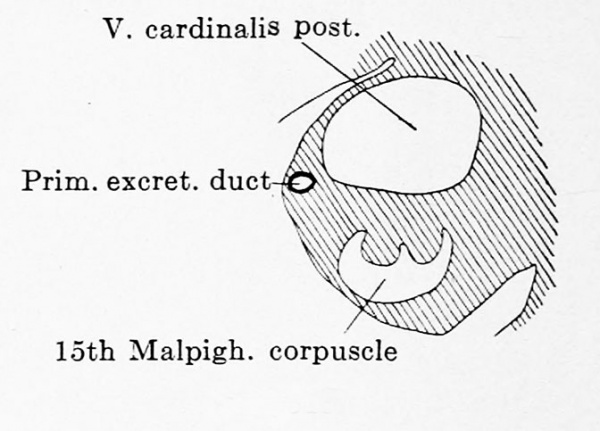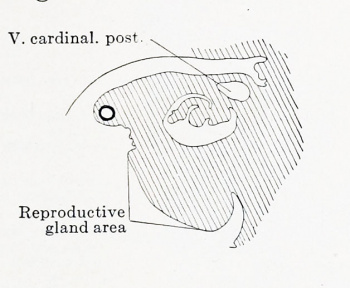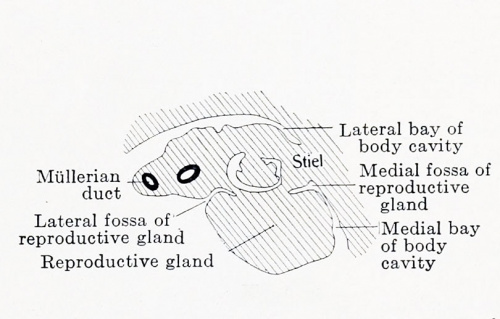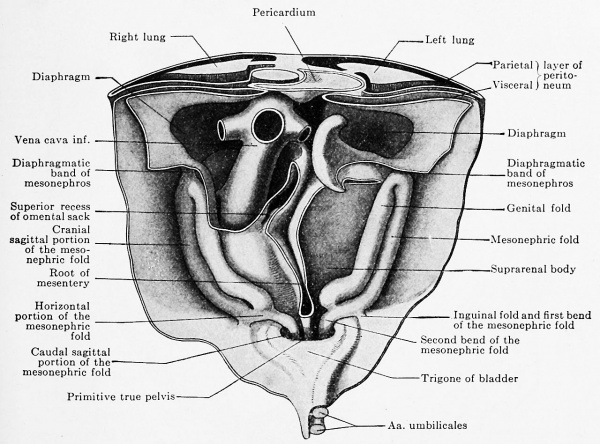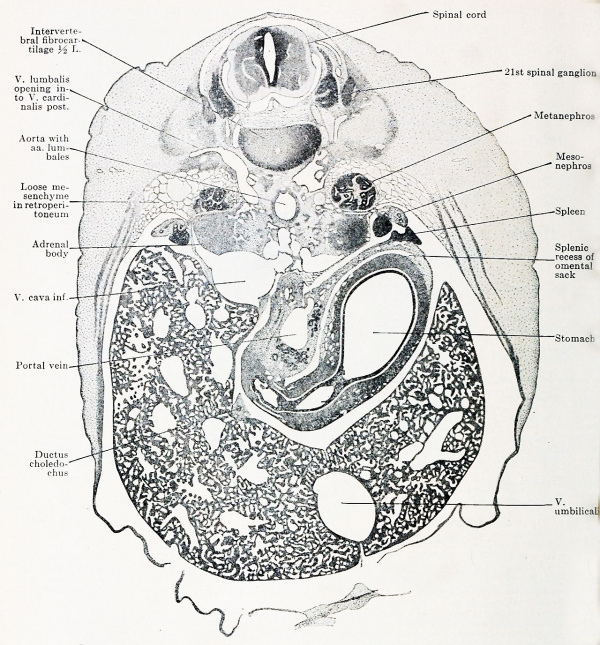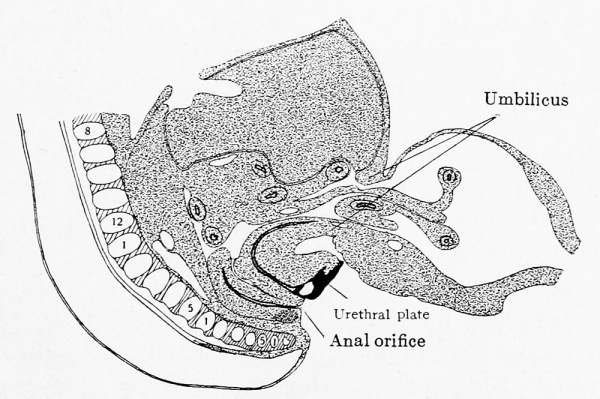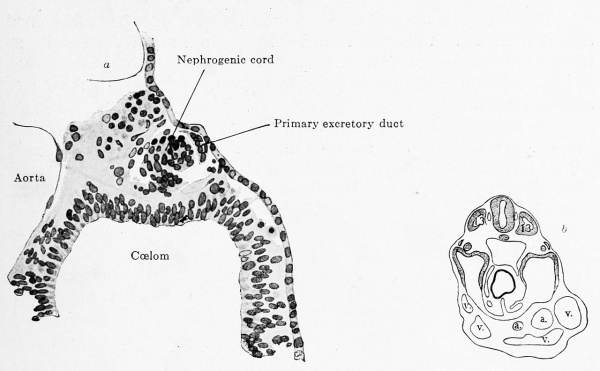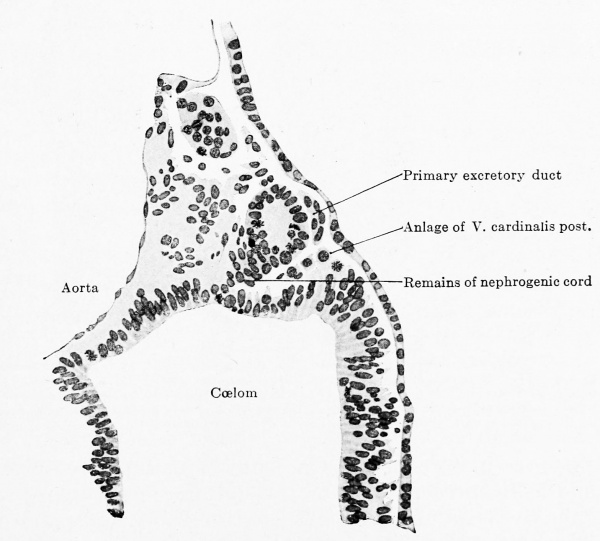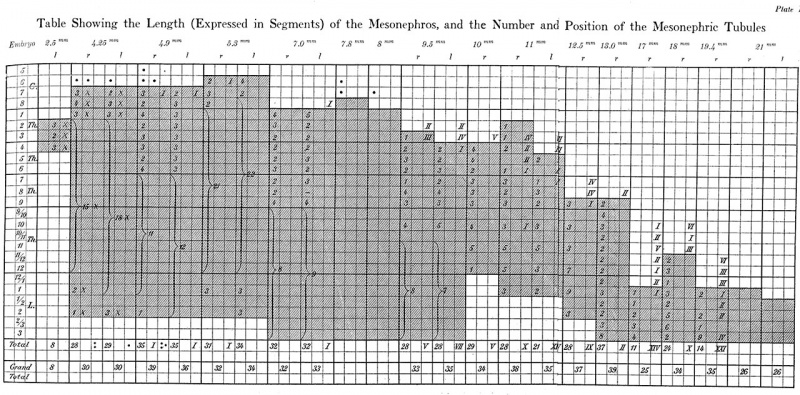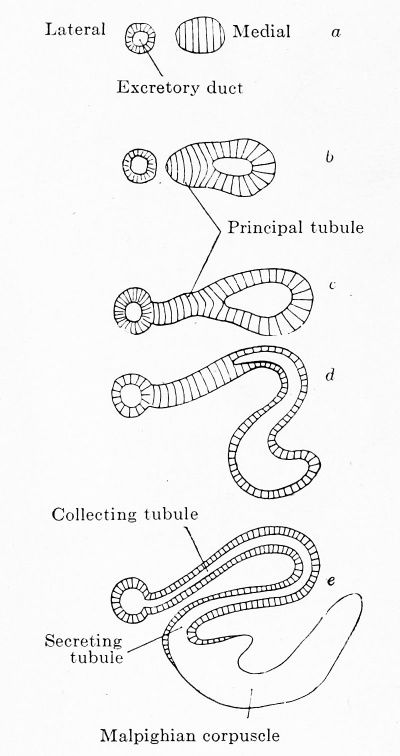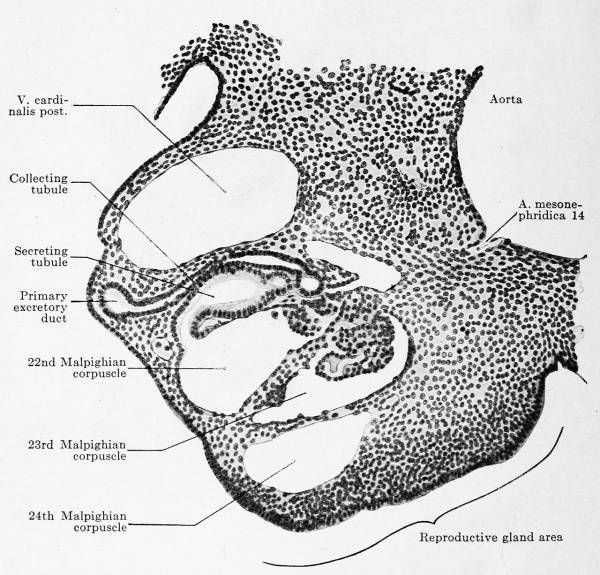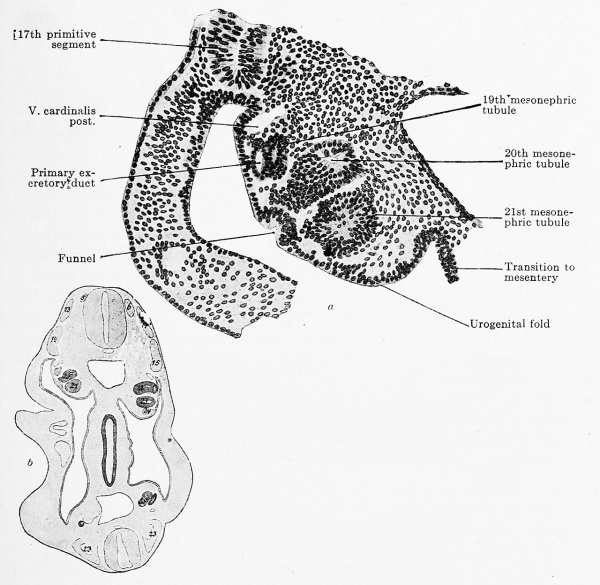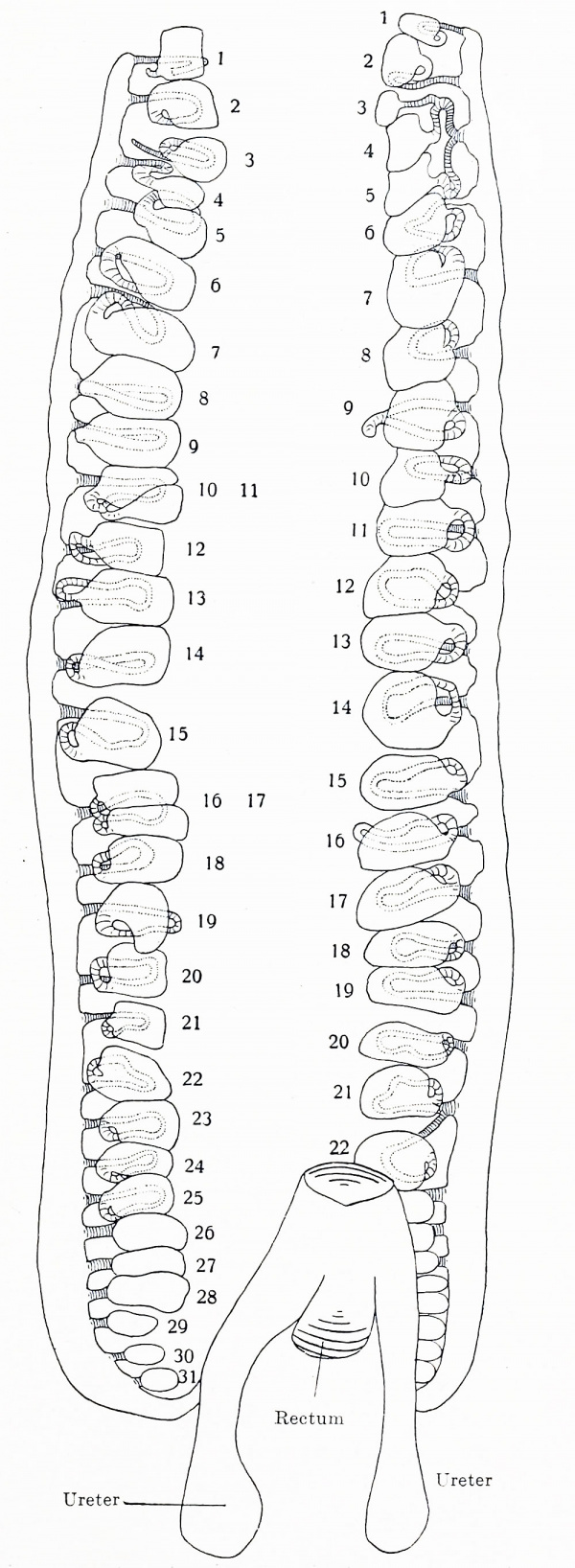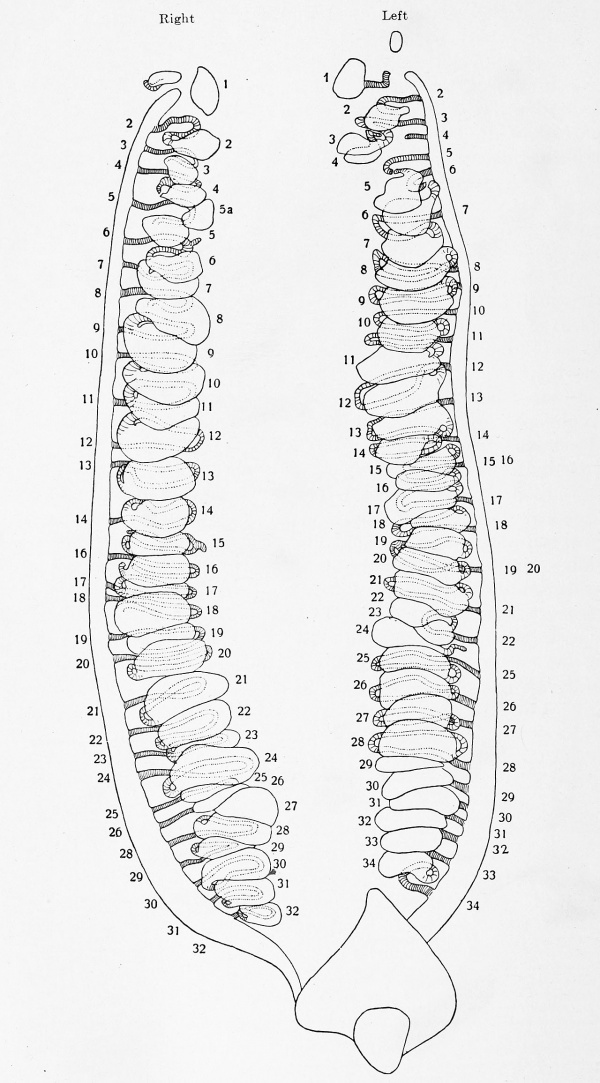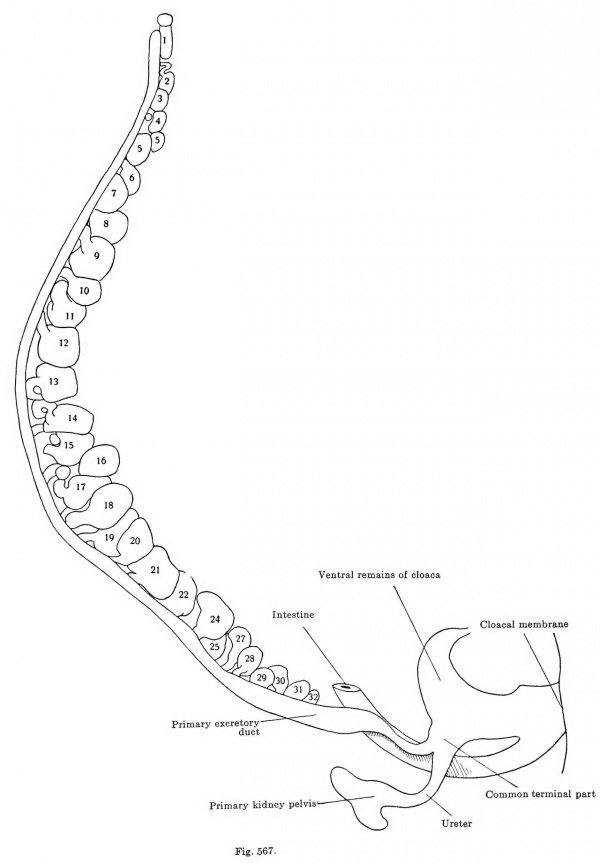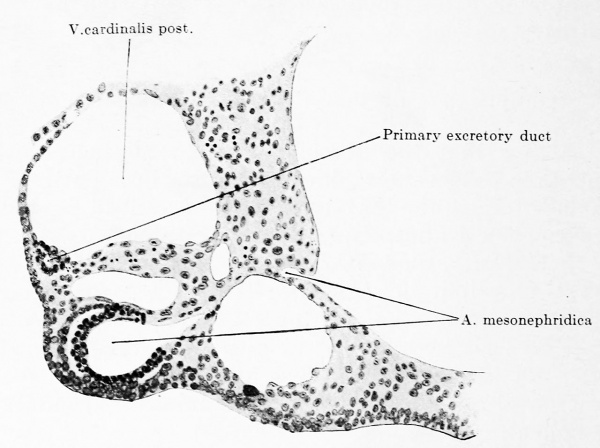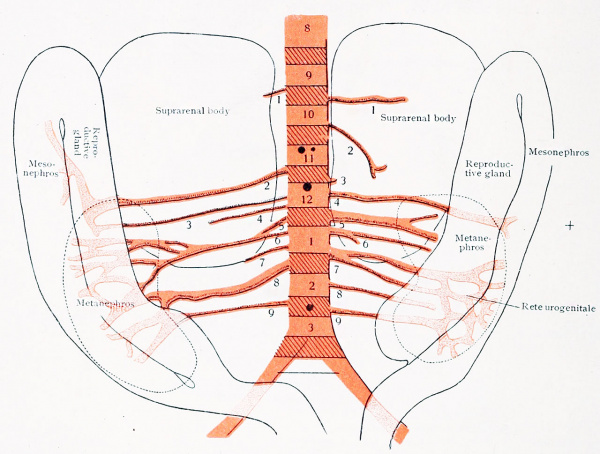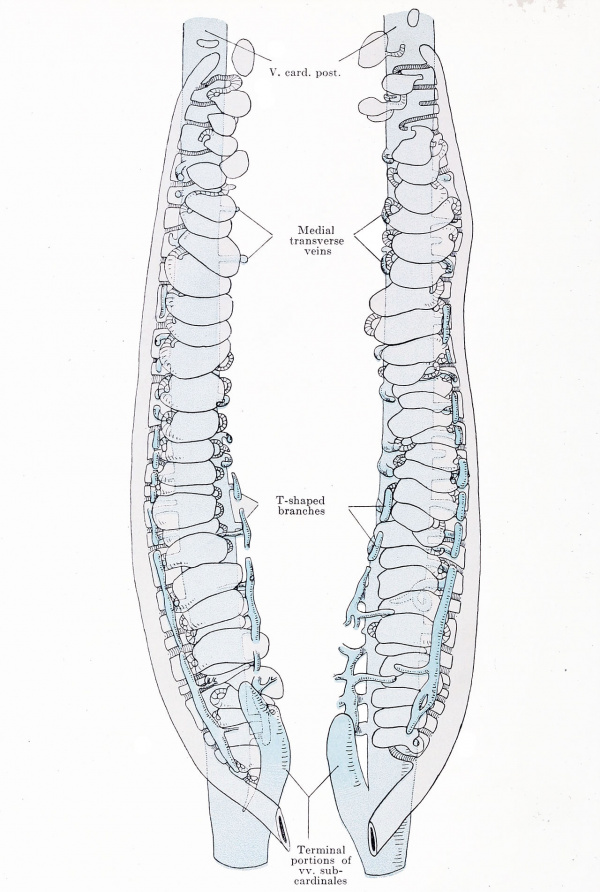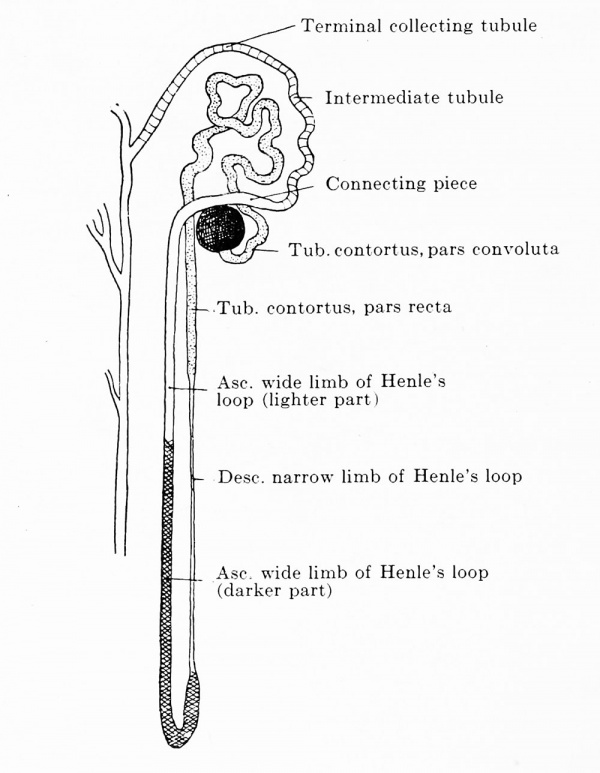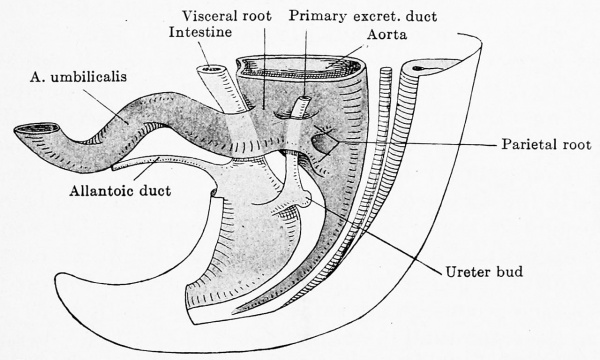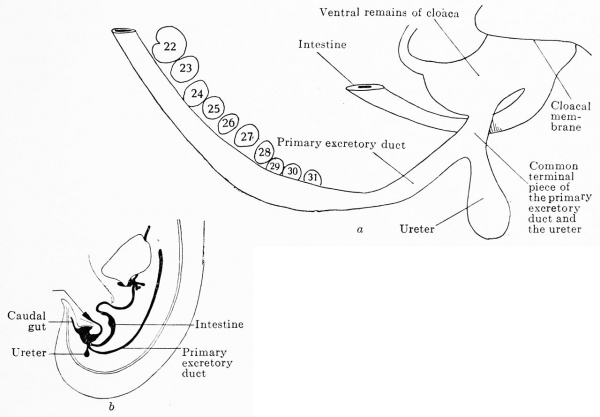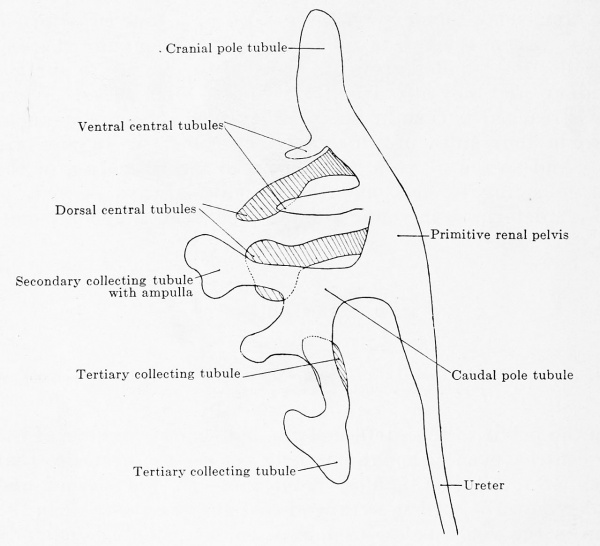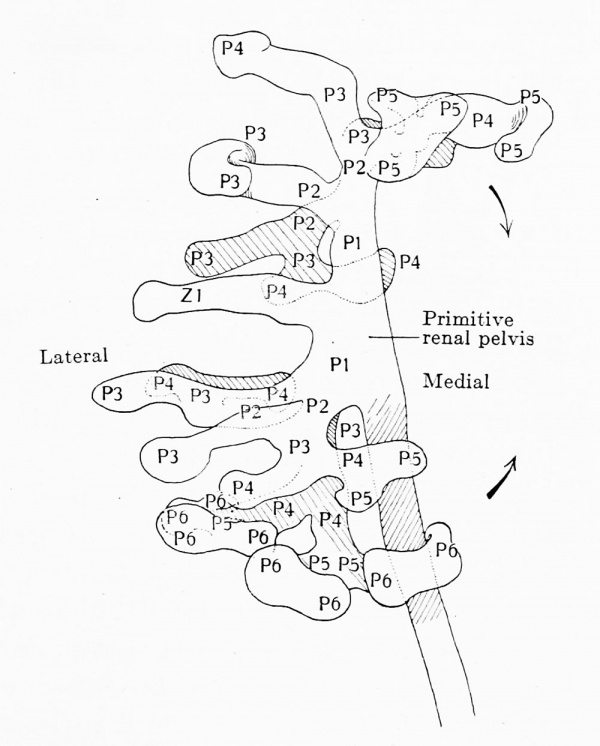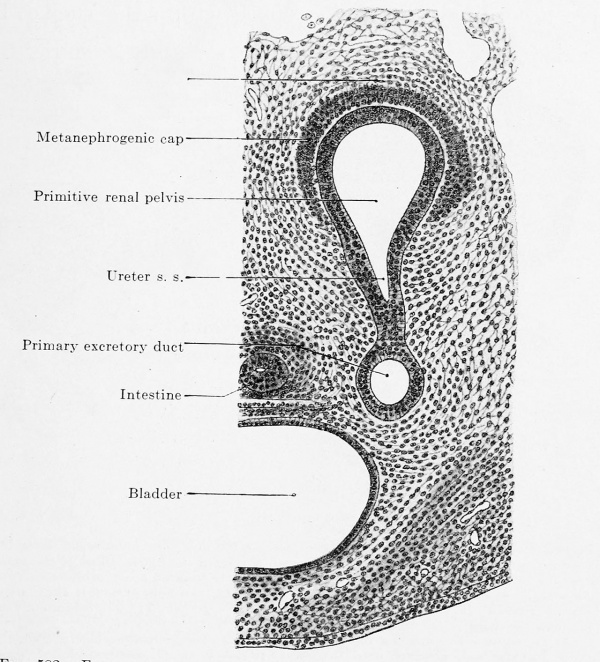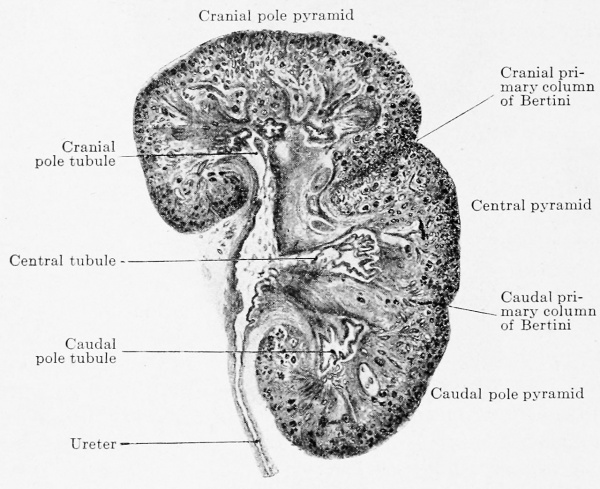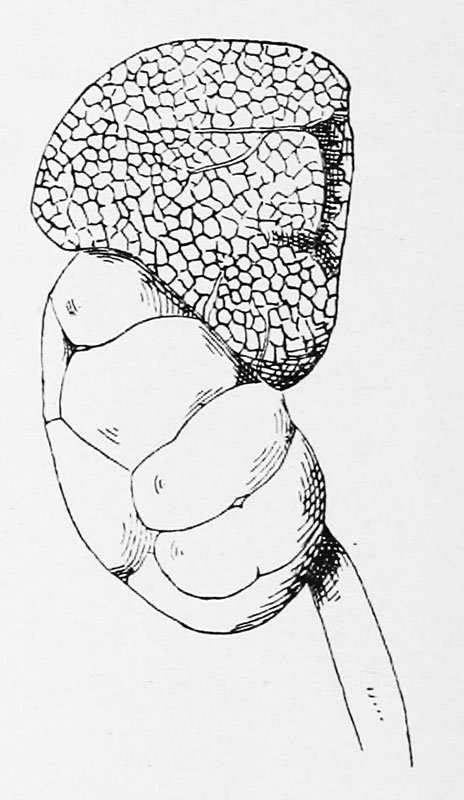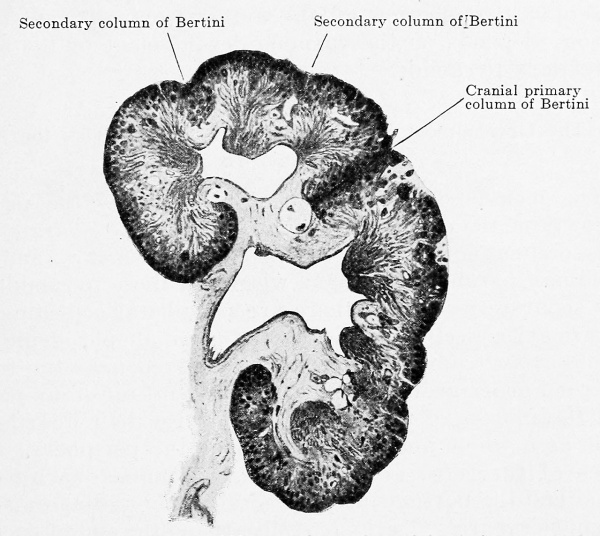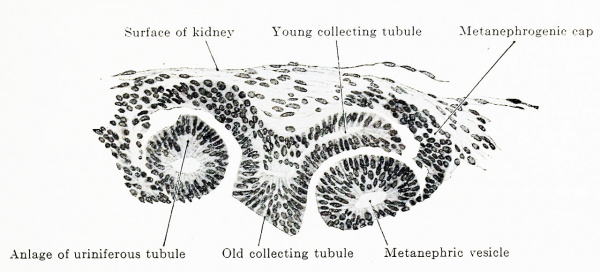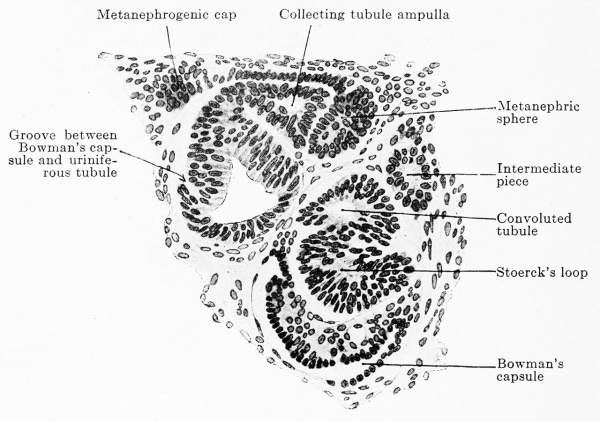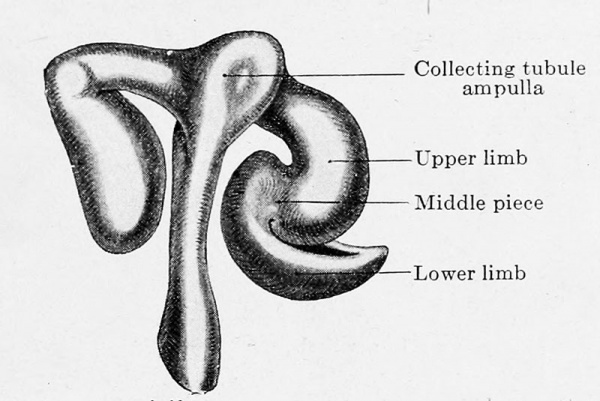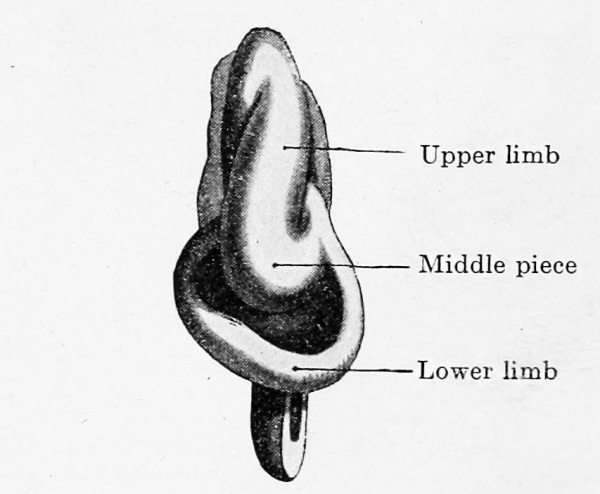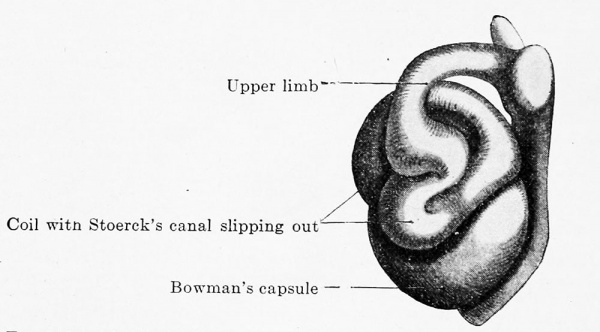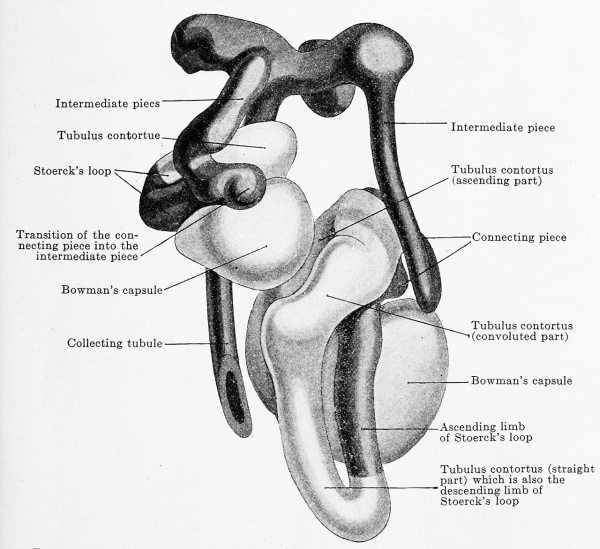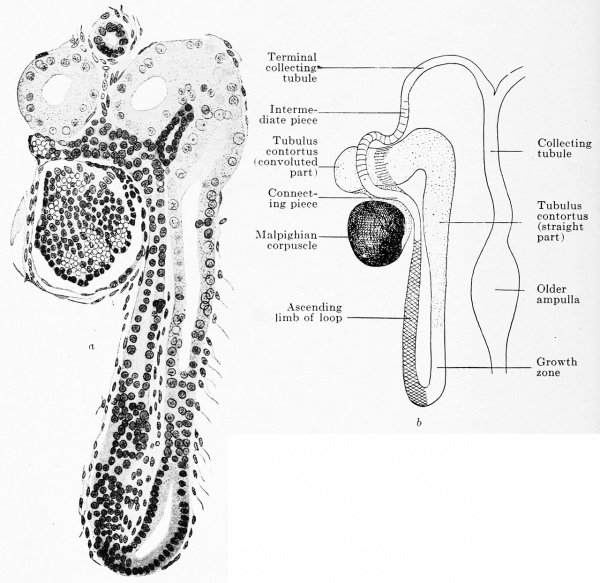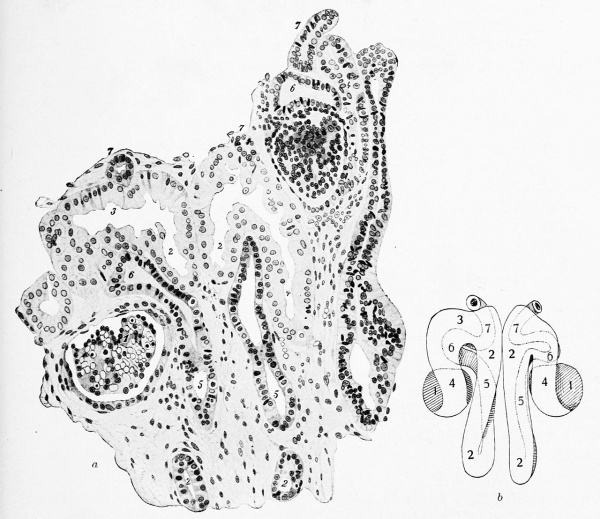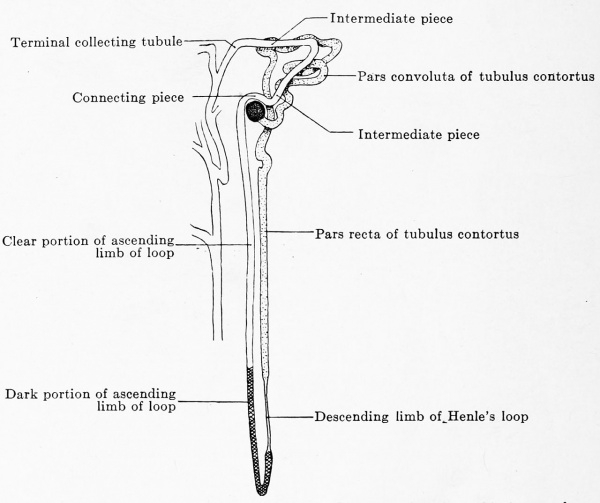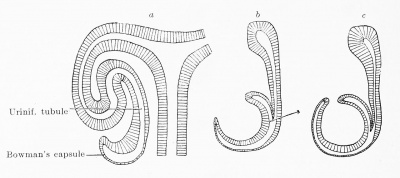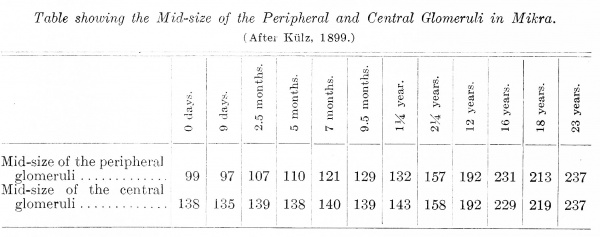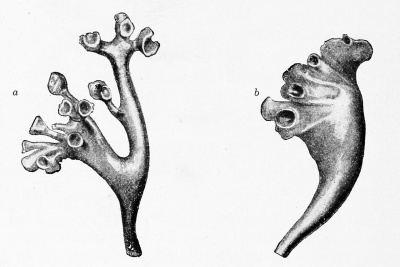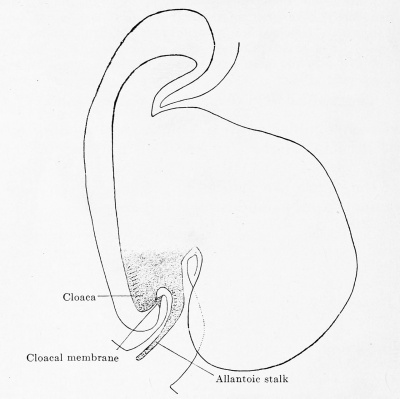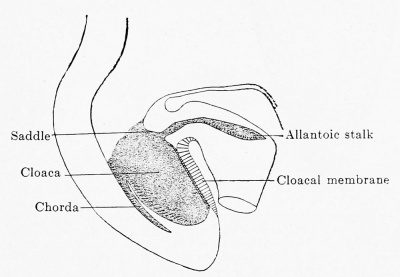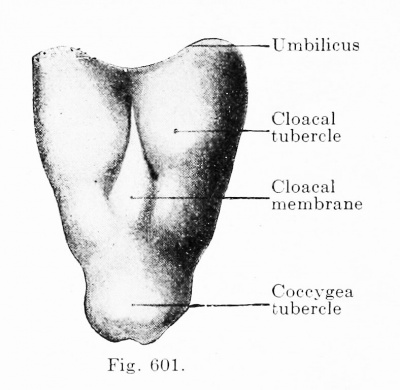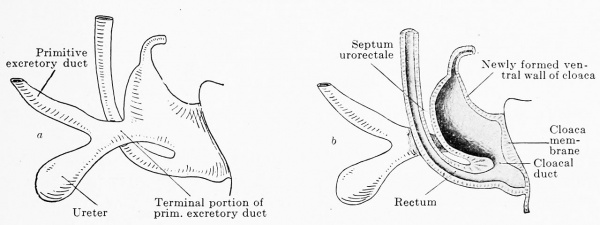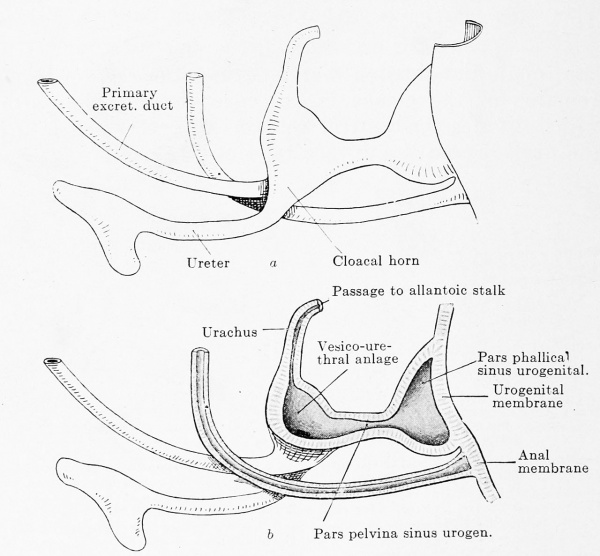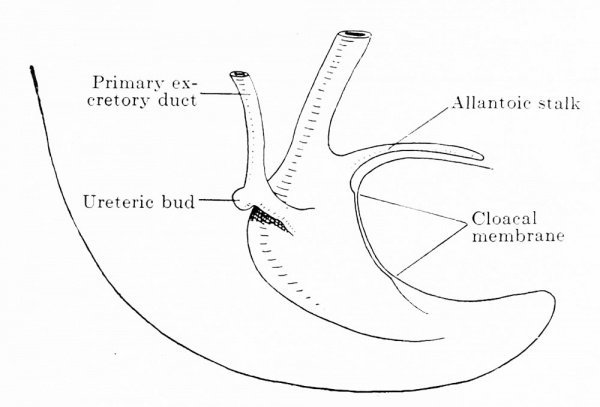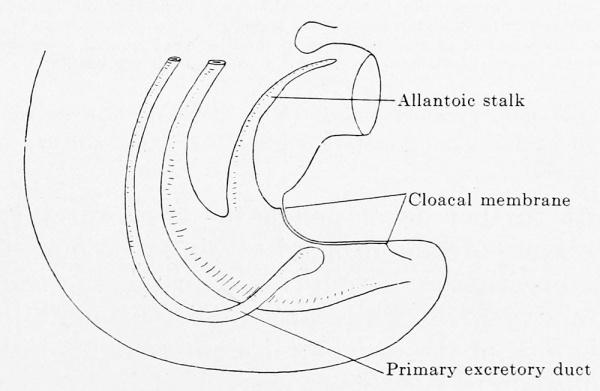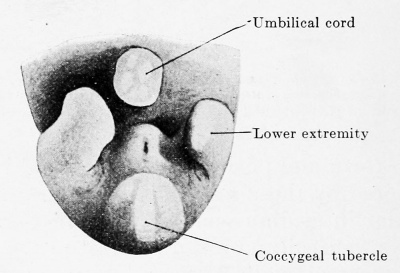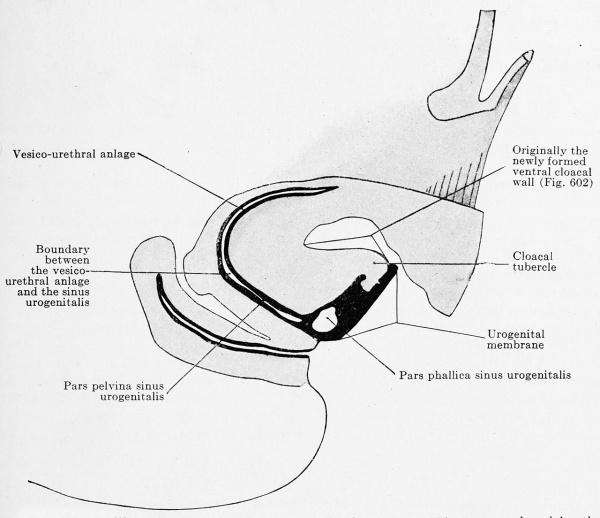Book - Manual of Human Embryology 19-1
| Embryology - 27 Apr 2024 |
|---|
| Google Translate - select your language from the list shown below (this will open a new external page) |
|
العربية | català | 中文 | 中國傳統的 | français | Deutsche | עִברִית | हिंदी | bahasa Indonesia | italiano | 日本語 | 한국어 | မြန်မာ | Pilipino | Polskie | português | ਪੰਜਾਬੀ ਦੇ | Română | русский | Español | Swahili | Svensk | ไทย | Türkçe | اردو | ייִדיש | Tiếng Việt These external translations are automated and may not be accurate. (More? About Translations) |
Felix W. The development of the urinogenital organs. In Keibel F. and Mall FP. Manual of Human Embryology II. (1912) J. B. Lippincott Company, Philadelphia. pp 752-979.
| Historic Disclaimer - information about historic embryology pages |
|---|
| Pages where the terms "Historic" (textbooks, papers, people, recommendations) appear on this site, and sections within pages where this disclaimer appears, indicate that the content and scientific understanding are specific to the time of publication. This means that while some scientific descriptions are still accurate, the terminology and interpretation of the developmental mechanisms reflect the understanding at the time of original publication and those of the preceding periods, these terms, interpretations and recommendations may not reflect our current scientific understanding. (More? Embryology History | Historic Embryology Papers) |
Cite this page: Hill, M.A. (2024, April 27) Embryology Book - Manual of Human Embryology 19-1. Retrieved from https://embryology.med.unsw.edu.au/embryology/index.php/Book_-_Manual_of_Human_Embryology_19-1
- © Dr Mark Hill 2024, UNSW Embryology ISBN: 978 0 7334 2609 4 - UNSW CRICOS Provider Code No. 00098G
I. The Development of the Excretory Glands and their Ducts
Introduction
In most vertebrates the development of the excretory system from its first formation until its completion occupies an interval which is long in comparison with that shown by other organs. In this interval its activity becomes modified in accordance with the growth of the entire organism, and this modification of the organ, still in the process of development, impresses upon the development of the kidney its distinctive feature. We have to deal not with the gradual development of a single organ, which is laid down and brought step by step to its definitive completion, but with a saltatory development; three organs (pronephros, mesonephros, and metanephros) are developed in succession, and each of these organs is apportioned and adapted to a definite period of one entire development. Each new excretory organ supplants its predecessor and the last to develop, the third, the metanephros, becomes the permanent kidney. The pronephros and lnesonephros are merely provisional kisdneys, whose activities become superfluous and are supplanted on the formation of a new excretory organ. But when a structure in the animal body becomes functionless it undergoes degeneration; consequently the entire pronephros and the greater portion of the mesonephros disappear. The lesser portion of the mesonephros enters the service of the reproductive apparatus and is permanently retained in this new connection.
The development of the excretory system presents practically the same beginning and the same course throughout the entire series of vertebrates. Only the final results are different; the higher the grade of organization of the individual vertebrate classes, the higher the grade of development of the excretory organ; the number of provisional excretory organs stands in direct relationship to the grade of organization of the animal. In amphioxus and the myxinoids only a single excretory organ (the pronephros) is formed, in the teleosts and ganoids, the selachians, the petromyzonts, dipnoans and amphibia there is one provisional organ, the pronephros, and one permanent organ, the mesonephros. In the amniotes there are two provisional organs, the pronephros and mesonephros, and, as a permanent organ, the metanephros. The succession pronephros, mesonephros, " metanephros, occurs not only in the ontogenetic development of the individual, but also has occurred in phylogenetic development of the kidney within the vertebrate group. The pronephros, which is a provisional organ in the classes mentioned above, corresponds in part to the persistent excretory organ of amphioxus and the myxinoids, just as the mesonephros of the amniotes corresponds to the permanent excretory organ of the teleosts, ganoids, selachians, etc.
A knowledge of the entire developmental history of the kidneys is very necessary in the consideration of human development, in which the pronephros and perhaps also the mesonephros no longer function as excretory organs, but represent only inherited stages of development.
Each excretory organ, whether it be provisional or permanent, represents a gland with its gland substance and duct. The gland substance is formed of individual urinary tubules, which in the primitive condition run transversely to the long axis of the body and may, therefore, in contrast with the longitudinal duct, be termed the transverse tubules. The duct, which is lacking only in amphioxus, opens into the cloaca. The transverse tubules open either directly or indirectly by means of a collecting canal into the duct. This opening into a common duct unites the separate urinary tubules to a single structure, the gland substance; when the duct is lacking each tubule stands by itself and represents an independent unit. The individual tubules are named according to the nature of the entire gland, prouephric, mesonephric, or metanephric tubules. The pronephric and mesonephrie tubules are recognized by their openings being into the original or primary duct, the metanephric tubules by their opening into a secondary duct (the ureter) specially developed for them.
Differentiation of the Mesoderm
General
The excretory system is of mesodermal origin. The story of the development of its parent tissue may begin with the fully formed but as yet undifferentiated mesoderm.
The account that I shall give will not be based on any definite example, but will rather represent a schema based upon the study of the development in the craniotes in general. The mesoderm forms a wedge-shaped plate on either side of the medullary tube (Fig. 520a), the base of the wedge being its medial surface directed toward the medullary tube and the notochord, its edge being the lateral border. Each mesoderm plate differentiates in two rapidly succeeding intervals into three portions: 1, the primitive segment in its narrower sense, 2, the primitive segment stalk, and 3, the lateral plate. In the first interval only the dorsal portions of the wedge and a narrow strip in its immediate proximity are divided into a series of successive and approximately equal portions, the primary primitive segments; the lateral, broader part of the mesoderm plate remains undivided and forms the lateral plate (Fig. 520 b). In the second interval the primary primitive segments become more sharply marked off from the lateral plates by their lateral portions being folded in from all sides and so converted into a stalk, which bears at its extremity the medial, unaltered portion of the primitive segment (Fig. 520 c) ; this medial, larger portion is termed the secondary primitive segment, the lateral, smaller one the primitive segment stalk (connecting cord, intermediate cell-mass, nephrotome, gononephrotome).
The primitive segment stalks furnish the material from which the tubules of all three excretory organs are developed, and it follows from this that the anlage of the excretory system cannot be a unit, but must be composed of as many parts as there are primitive segment stalks entering into its formation. Furthermore it follows that the tubules are formed outside the body cavity enclosed by the lateral plates, i.e., they are from the beginning retroperitoneal.
With the progress of development the secondary primitive segments and the stalks become separated, the opening in the wall of each at the point of separation closing at the same time.
The stalk presents quite different arrangements in the representatives of the various vertebrate classes. It may : 1. preserve the form of an epithelial canal and its connection with the lateral plate, and be directly transformed into a uriniferous tubule; 2, it may become separated from tbe lateral plate and form either an isolated vesicle or an isolated solid mass of cells, and in this form it may be directly transformed into a tubule; 3, it may be gradually taken up into the lateral plate by an extension of the coelomic cavity of the plate, and is then only distinguishable from the lateral plate by its further development; 4, it may be transformed into a solid mass of cells and fuse with the neighboring stalks, similarly transformed, to form a single cord, known as the nephrogenic cord, which may or may not retain its connection with the lateral plates; or it may finally be transformed into mesenchyme tissue by the separation of its cells, this tissue then fusing with the mesenchyme of the sclerotome to form a single mass in which the source of the constituent parts can no longer be determined. Several of these five modes of development may occur in the same embryo, and, since neighboring segment stalks develop similarly, groups of segment stalks may be distinguished. Each primitive segment stalk may develop several tubules in succession. Since it itself passes along a definite path of development, during which its form changes, an opportunity is afforded for differences between the earlier and later formed uriniferous tubules. Pronephrie and mesonephric tubules of the same animal need not therefore show a similar development, if, between their formations there occurs a distinct interval, during which their common source has acquired a new form. Similarly the pronephrie tubules of different animals show profound differences in their development, differences which find an explanation in the time relations of the formation of the tubules. The change of form which accompanies the progressive development of the common source of the organ suffices to explain the difference in the development of a pronephric, mesonephric, and inetanephric tubule.
Fig. 520 a, b, and c. Diagram illustrating the segmentation of the mesoderm, a shows the unsegmented mesoderm; b shows the first stage of segmentation, the separation of the primary primitive segment from the dorsal part of the mesoderm wedge; c shows the second stage of segmentation, the formation of the primitive segment stalk and the division of the primary primitive segment into the secondary primitive segment and the primitive segment stalk.
Each primitive segment stalk has theoretically the potentiality of producing all three kinds of tubules; a very complicated organ would be produced in this manner. Actually the arrangement is simpler, since the primitive segment stalks of the cranial zone produce only pronephric tubules, those of the middle zone only mesonephric {ubules, and those of the caudal zone only metanephric tubules, stalks, however, which produce two kinds of tubules, occurring in the intervals between the different zones.
The Segmentation of the Mesoderm in Man
In the human embryo the coelom first appears as the exocoelom and at an early period separates the mesoderm into intra- and extra-embryonic portions, the boundary between the two being indicated by the adjacent vena umbilicalis (Fig. 521). The intraembryonic mesoderm is at first absolutely solid, and while it is still in this condition its first segmentation takes place; the relations are accordingly as yet somewhat obscure. The formation of the primary primitive segments precedes the formation of a primitive segment plate, that is to say, the primary segments are separated from the lateral plates before they become separated from, each other, and in an embryo with 5 or 6 pairs of primitive segments the primitive segment plate therefore extends almost to the caudal extremity of the embryo. The grooves which delimit from the primitive segment plate the 5 or 6 cranial segments do not separate the primary primitive segments throughout their entire width, but penetrate only to the lateral border of the future secondary segment, the segment stalk therefore remaining at first unseparated. Fig. 521 is taken from an embryo with 5 or 6 primitive segments; on the right side (the left in the figure) the section passes through the sixth primitive segment, which is not yet separated caudally, and on the left side it passes through the primitive segment plate at a level corresponding to about the middle of the future seventh segment. The intra-embryonic mesoderm of either side is not yet cleft. While on the right the primary primitive segment is not delimited from the lateral plate, and there is no indication whatever by which to distinguish the segment stalk from the secondary segment, on the left the arrangement of the nuclei indicates the future triple division of the intraembryonic mesoderm into the secondary primitive segment, the segment stalk and the lateral plate ; two crosses in the figure indicate the limits of the three portions. During the segmentation the formation of the cavity in the intra-embryonic mesoderm occurs. The ccelom may form discontinuously both in the cranio-caudal and frontal directions; the clefts which succeed one another in the cranio-caudal direction do not show a segmental arrangement, but, on the other hand, those following in the frontal direction may correspond to the region of the lateral plates and that of the primitive segment stalks; the lumen of the lateral plate is not at first continuous with that of the exoccelom (Fig. 522). In an embryo with from 8 to 10 pairs of primitive segments the secondary segments are completely delimited and enclose a distinct lumen (the myoccel), but their stalks are not yet separated from the lateral plates (Fig. 522). The first distinctly separated segment plates are shown by the anterior 8 or 9 segments of an embryo with from 12 to 14 pairs of primitive segments; from the tenth segment onward all the stalks are united with the nephrogenic cord. In the same embryo the degeneration of the more anterior segment stalks has begun; they are becoming mesenchyme tissue. In an embryo with 23 pairs of segments isolated segment stalks are to be distinguished only indistinctly, but, on the other hand, a nephrogenic cord extends from the 13th segment to the unsegmented mesoderm.
Fig. 521. Transverse section of a human embryo of 1.35 mm. greatest length (as determined from the series) and with 5-6 pairs of primitive segments. (Embryo Pfannenstiel-Kromer, from the collection of Professor Pfannenstiel; slide 6, row 3, section 7.) 120. The section passes on the right through the 6th segment and on the left through the primitive segment plate at the level of the future 7th segment. The section shows the ccelom relations. Only the exoccelomis present. On the right there is no apparent differentiation of the intra-embryonic mesoderm; on the left a beginning differentiation of the secondary segment, the segment stalk and the lateral plate is visible and is indicated by two crosses (x). The periintestinal rete and the anlagen of the aorta can be seen. An injury to the embryo accounts for the peculiar bending downward of the endoderm and visceral mesoblast in the left side.
Fig. 522. Transverse section of a human embryo with 9-10 pairs of primitive segments and 1.73 mm in length (determined from the series). (Embryo R. Meyer No. 335, from the collection of Professor R. Meyer, Berlin; slide 7, row 2, section 2.) x 135. The embryo is torn in the region of the medullary tube; there is a medullary tube and not a medullary groove. The yolk-sack is greatly folded, so that it appears as if divided into two portions; hence the peculiar appendage on the right side of the figure, which ia the connection with the second portion of the yolk-sack, not represented. The section passes through about the middle of the 7th primitive segment. The lateral plate contains a single wide ccelomic cavity, which is not, however, in communication with the exoccelom. The segment stalk is not distinguishable from the lateral plate. The visceral mesoblast of the yolk-sack is giving rise to the rete peri-intestinale.
Fig. 523 a and b. Diagram of the development of the pronephros, a. The principal tubules 5, 6, 7, and 8 develop by evagination from the parietal mesoblast of the primitive segment stalk. They grow caudally 3 and 4) and reach and overlap the succeeding tubules passing laterally to them (2). The principal tubules, which are thus brought into apposition, fuse, and a collecting duct (1) is formed. b. The collecting duct remains in connection with the various segment stalks by means of the principal tubules.
The human embryo forms, therefore, both secondary primitive segments and segment stalks. The latter retain their individuality only in the anterior 8-9 segments, and from the tenth segment outwards they fuse to form a nephrogenic cord or are separated from the unsegmented mesoderm as such a cord. The connection between the nephrogenic cord and the lateral plate is sometimes retained and sometimes lost; but the connecting bridges, when present, show no segmental arrangement.
The Development of the Pronephros
General
The pronephros in man no longer functions as an excretory organ and its development has therefore become abbreviated, incomplete, and in consequence obscure. And a further difficulty is introduced by the fact that its appearance and formation occur in very early stages of development, for the study of which good material is only sparingly available ; consequently the account of the development of the human pronephros must be incomplete. I shall therefore present a review of the development of the pronephros within the vertebrate stem and what is known as to its development in man may be readily included in this review.
The first anlage of the pronephros consists in the development of the pronephrie tubules. The parietal layer of each primitive segment stalk forms an evagination directed toward the ectoderm, the principal tubule (Fig. 523 a, tubules 7 and 8). Each principal tubules extends caudally beneath the ectoderm, without, however, uniting with it (Fig. 523 a, tubules 6, 5, 4, and 3). The tubule reaches the next succeeding one, grows backward along its lateral surface (Fig. 523 a, tubule 2), and fuses with it (Fig. 523 a, tubule 1) ; by the fusion of all the principal tubules a longitudinal canal, the collecting duct, is formed and this is connected with each primitive segment stalk by a principal tubule (Fig. 523 b). The principal tubules of the various segments do not appear simultaneously, but are formed in successive groups, cranial ones first and then caudal ones. Once the collecting duct and the principal tubules are formed a differentiation of the primitive segment stalk begins (Fig. 524 a, b, and c). In Fig. 524 a a transverse section through the segment stalk and the pronephric tubule is represented, the segment stalk being hatched and the tubule black. In Fig. 524 b the secondary primitive segment has separated from the segment stalk, the stalk which has thus become free separates the elements of its medial portion to form mesenchyme tissue, indicated in the figure by the three dots, and the lateral portion of the stalk closes the opening thus formed and now appears as a connecting canal between the principal tubule and the lateral plate; we shall term it the supplemental tubule. In Fig. 524 c the principal tubule (black) and the supplemental tubule (hatched) have elongated; the supplemental tubule, by the broadening of the portion immediately adjacent to the principal tubule, has become divided into two parts, a broad medial one, which is invaginated by a vascular glomerulus, and a narrow lateral one, which establishes the connection with the lateral plate. The broad part may be termed the inner pronephric chamber, the narrow one the nephrostome canal. A vascular glomerulus similar to that which invaginates the medial wall of the pronephric chamber, pouches out the visceral layer of the lateral plate close to the opening of the nephrostome canal into the body cavity (Fig. 524 c). Both glomeruli are supplied by branches from the aorta; they may be termed the internal and external glomeruli. The internal one is a portion of the pronephric canal, the external one is an independent structure and is related to the pronephric tubule only by its neighboring position. The portion of the body cavity that contains the external glomerulus may separate from the rest of the coelom and thus constitute an outer pronephric chamber. These are all the constituent parts of a pronephric tubule, and together they form a pronephric segment; this in its fully developed condition consists of the principal tubule, the pronephric chamber, the nephrostome canal, the internal and external glomeruli and, in some cases, the outer pronephric chamber.
Fig. 524 a, b and c. Diagram of the development of a pronephric segment. The segment stalk is hatched, the principal tubule is black, a. The principal tubule arises as an evagination of the parietal layer of the primitive segment stalk, its lumen being continuous with that of the segment stalk and through this with that of the lateral plate, b. The segment stalk has lost its connection with the secondary primitive segment, its medial portion has become converted into mesenchyme tissue and its lateral part has united with the principal tubule. The lateral part of the stalk thus becomes a tubule supplemental to the principal tubule, c. The supplemental tubule (hatched) becomes divided into the inner pronephric chamber and the nephrostome canal. A glomerulus, forming the internal glomerulus and supplied by the aorta, invaginates into the inner pronephrie chamber, the external glomerulus projects into the general body cavity (ccelom of the lateral plate). The pronephric segment is now complete in all its parts; starting from the collecting duct we have the principal tubule, the pronephric chamber with the internal glomerulus, the nephrostome canal and the external glomerulus.
Originally each primitive segment stalk throughout the entire length of the body cavity produced a pronephric tubule. By the union of these tubules an excretory duct, the collecting duct, was formed, extending throughout the entire length of the body cavity, and this, or the last tubule, opened into the cloaca. This arrangement still persists in the myxinoids and the telosts, probably also in the ganoids, petromyzonts, amphibia and dipnoans. In the remaining classes, the selachians, gymnophiones and amniotes, there is an abbreviation of the pronephric anlage, so that pronephrie tubules are formed only in a varying number of the cranial segments. But since the excretion must still be conveyed to the cloaca, one of the most caudal tubules elongates on its own account and becomes the excretory duct. It grows caudally between the ectoderm and mesoderm and thus reaches the cloaca. During its elongation it lies in close apposition to the ectoderm, but probably is not in connection with it. In such a pronephrie excretory duct, which we will term a primary excretory duct, two portions may be distinguished: one, the collecting duct portion, formed by the fusion of the principal tubules, and another, the free terminal portion, produced by the independent backward elongation of a pronephric tubule. If the pronephros of the selachians, gymnophiones and amniotes is an organ which has undergone retrogression, if its excretory duct has been formed under ccenogenetic conditions, the results of their ontogeny must be received with caution. At all events clear evidence as to the relation between pronephros and mesonephros cannot be obtained from these forms.
The Pronephros in Man
The human pronephros is a quite rudimentary organ and its development is accordingly abbreviated and incomplete. The abbreviation reveals itself in the transitoriness of its occurrence, the incompleteness in the imperfection of the individual pronephric segments and in the small number of primitive segment stalks that form pronephrie tubules. The abbreviation of the entire anlage necessitates — according to the general description (p. 753 and p. 759) — the division of its development into two portions: first, the development of the glandular portion — the pronephric tubules and the collecting duct — and, second, the development of the free terminal portion of the primary excretory canal.
The first anlage of the pronephric glandular portion occurs in an embryo with from 9 to 10 pairs of primitive segments and a greatest length (determined from the series) of 1.73 mm. A stage of greatest development cannot exist, since the cranial canals have already dissolved into mesenchyme tissue while the caudal ones are developing; the complete formation of these last is almost reached in an embryo of 2.5 mm. greatest length, with 23 pairs of primary segments. The degeneration of the pronephros is already well advanced in an embryo of 4.25 mm. vertex-breech length with from 27 to 28 pairs of primitive segments and, accordingly, takes place between the stages with 23 and 28 pairs of segments. The time of disappearance of the pronephros cannot be determined definitely, since it extends into the territory of the mesonephros, and the cranial tubules of this also degenerate immediately after their formation; it is consequently impossible to determine the significance of the remains of a tubule occurring in the pronephric region; it may represent a pronephric tubule, it may be a mesonephric tubule in process of degeneration, or, finally, it may be the remains of a primitive segment stalk or of the nephrogenic cord. As the approximate time for the complete disappearance of the pronephros a stage of 4.9 mm. vertex-breech length may be named. But it is to be remembered that one constituent of the pronephros, the external glomerulus, may, on account of its independence, persist far beyond this stage.
The pronephric anlage extends from the 7th to the 14th primitive segment. It is very probable, however, that it may extend further forwards, since an embryo of 2.6 mm. greatest length and with 12-14 pairs of primitive segments showed on one side pronephric rudiments in the 2nd, 4th and 6th segments. The conditions in the other amniotes are also in favor of the possibility of this arrangement. The anlagen probably appear successively in groups. In an embryo with 9-10 pairs of primitive segments the pronephros extended from the 7th to the as yet unseparated 11th segment, and in one with 12-14 pairs of segments it reached from the 7th to the 14th segment.
Fig. 525. Human embryo with 9-10 pairs of primitive segments and a length of 1.73 mm (determined from the series). (Embryo R. Meyer 335, in the collection of Professor R. Meyer, Berlin; slide 7, row 3, section 4.) x 135. The section passes on the right side through the cranial wall of the 8th primitive segment, on the left through the interstitium between the 7th and 8th segments (reversed in the figure). The coelom is continuous with the exocoelom, the original boundary between them being marked by the vena umbilicalis. The coelom is greatly enlarged, only the medial portion, corresponding to the primitive segment stalk, remaining narrow. On the left side of the figure the coelom of the primitive segment stalk and that of the lateral plate are separate, and the parietal layer of the segment stalk is outpouched to form the first pronephric principal tubule.
The pronephric tubules appear as ridge-like thickenings of the parietal layer of the individual primitive segment stalks, and the lumen of the stalk may usually be followed into the thickening. Fig. 525 shows the pronephric tubule of the 7th segment (which is also the first pronephric segment) of an embryo of 1.73 mm. greatest length (determined from the sections) and with 9-10 pairs of primitive segments. The anlage begins in the posterior half of the 7th segment and extends to the anterior half of the 8th segment. The next anlage begins in the posterior half of the 8th segment, the third at the anterior edge of the 9th segment.
Only the most anterior anlagen are independent and completely separated from one another, showing a certain metamerism.
Fig. 526. Reconstruction of the right pronephric anlage of an embryo of 2.6 mm greatest length, with 13-14 pairs of primitive segments. (Embryo Pfannenstiel III, from the collection of Professor Pfannenstiel.) The contours of the embryo, the medullary canal and the intestine are outlined, the mesoderm (secondary primitive segment, segment stalk and lateral plate) is shaded, the pronephric anlage is black. The anlage consists of five parts, a rudimentary tubule in the 7th segment, two well-developed tubules in the 8th and 9th segments, a pronephric ridge in the 10th, 11th and 12th segments and another ridge in the 13th and 14th segments. Luminain the principal tubule and in the primitive segment stalks are left white.
For the posterior ones one or two continuous longitudinal ridges are formed, which lie in a direct line with the isolated tubules; I shall call these the pronephric ridges to contrast them with the pronephric tubules. The ridges are in some places separated from their parent tissue, in others they remain in connection with it and at each of these connection regions they possess a lumen. In Figs. 526 and 527 I give a reconstruction of the pronephric anlage of an embryo of 2.6 mm. greatest length and with 12-14 pairs of primitive segments ; the pronephros here reaches its greatest extent. The arrangement is somewhat clearer on the right side (Fig. 526) than on the left. The secondary primitive segments, the segment stalks and the lateral plate are shaded and the pronephros is black; the supplemental canals and the connections of the pronephric ridges with the segment stalks or the nephrogenic cord, have been in the figures displaced laterally to the boundary line of the lateral plate, although in reality they lie beneath the nephrogenic cord. Finally, where a lumen occurs, it is represented as white. In the 7th segment there is a rudimentary anlage and the 8th and 9th each contains a completely developed one. There are therefore three separate pronephric tubules. The second and third tubules are united together and with the following pronephric ridge. In the stretch from the 10th to the 12th segment and again in that from the 13th to the 14th there follow two pronephric ridges ; the lumina in the anterior one show, though not strongly, a metameric arrangement. The left side of this embryo shows the rudimentary anlagen in the 2nd, 4th and 6th segments that were previously mentioned.
Fig. 527. Reconstruction of the left pronephric anlage of the embryo shown in Fig. 526. The pronephros consists of rudiments in the 2nd, 4th, 6th, 7th and 8th primitive segments and of a long pronephric ridge extending from the 9th to the 14th segment. The horizontal lines in both figures indicate the locality of the transverse sections.
This embryo with 12-14 pairs of primitive segments already shows progress in the development of the individual tubules. The anlagen of the 8th and 9th segments have separated from their parent tissue, have extended backwards to the next anlage and have fused with it to form the collecting duct. This further development corresponds in time with the establishment of continuity between the exo- and entoccelom and with the enlargement of the latter. In the entoccelom, however, only the ccelom of the lateral plate is enlarged, that of the segment stalk remains narrow so that the stalk looks like a tubule and gives the false impression of a direct origin of the pronephric anlage from the lateral plate. Fig. 528 passes on the right (left in the figure; the location of the section is shown in Fig. 527) through the cranial end of the third pronephric tubule, which here, notwithstanding its shortness, consists of a principal tubnle and the supplemental tubule formed from the primitive segment stalk. A comparison with the left side (right in the figure), where the section passes through the separated end of the third left pronephric tubule, shows that there the principal tubule and the segment stalk are distinctly separate. To show the arrangement in the pronephric ridge I give in Fig. 529 a second section through this embryo, which on the right (left in the figure) cuts the ridge just where it possesses a distinct lumen. Here the segment stalk together with its pronephric anlage is separated from. the lateral plate, although it lies in close apposition to it. The existence of the two components is to be made out only by comparison with the anterior tubules and from the further development. Finally the question as to the caudal end of the pronephric anlage is yet to be considered. In the embryo with 12-14 pairs of primitive segments, in which the pronephric anlage reaches its greatest caudal extension, it passes insensibly at its caudal end into the unsegmented mesoderm. The section shown in Fig. 530 passes through the 13th or 14th segment ; its location is shown in Figs. 526 and 527. On the left side of the figure there is merely a thickened primitive segment stalk, separated both from the primitive segment and the lateral plate ; it is termed in the figure the nephrogenic cord and pronephric ridge: on the right side the segment stalk is in connection with the lateral plate and the lumen of the latter is continued directly into the stalk. In Fig. 527 the leader ' ' Fig. 530 ' ' shows how far the lumen passes beyond the medial edge of the lateral plate. More caudally the right (left in the figure) thickened segment stalk also becomes connected with the lateral plate and then the thickening fades out so gradually that a definite limit for its extremity cannot be established. The pronephric anlage is, accordingly, as far as the 14th primitive segment purely mesodermal, any participation of the ectoderm in it is excluded.
Fig. 528. Embryo of 2.6 mm greatest length and with 13-14 pairs of primitive segments. (Embryo Pfannenstiel III, from the collection of Professor Pfannenstiel; slide 9, row 3, section 4.) X 182. The section passes on both sides through the caudal wall of the 9th primitive segment. On the left side the third, right pronephric segment, with the principal and supplemental canal, is cut. On the right side the section passes through the caudal end of the third, left pronephric principal canal and shows its relation to the primitive segment stalk. Between the ectoderm and the visceral mesoblast is the vascular layer, in which are young red blood-corpuscles, distinguished by the abundance of chromatin in their nuclei. The tears in the medullary canal and beside the pronepheric anlagen are artefacts.
Fig. 529. Human embryo of 2.6 mm greatest length and with 13-14 pairs of primitive segments. (Embryo Pfannenstiel III, from the collection of Professor Pfannenstiel; slide 10, row 3, section 2.) X 182. The section passes on both sides through the cranial half of the llth primitive segment. On the right Heft in the figure) the primitive segment stalk is cut and also the pronephric ridge and a lumen corresponding to the llth pronephric tubule. The pronephric ridge and the segment stalk are not delimited from each other. On the right side the same arrangement. Between the visceral mesoblast and the digestive canal are the cells of the vascular layer. On the right side a ramus intestinalis passes to the vascular layer.
Fig. 530. Human embryo of 2.6 mm greatest length and with 13-14 pairs of primitive segments. (Embryo Pfannenstiel III, from the collection of Professor Pfannenstiel; slide 12, row 1, section 5.) X 182. On the right side (left in the figure) the section passes through the forming cranial wall of the 14th primitive segment, on the left through the caudal wall of the 13th segment. On the right (left in the figure) it cuts the nephrogenic cord. A comparison with the right side of Fig. 528 shows at once that the primitive segment stalk is greatly enlarged, the enlargement being due to the pronephric anlage. The anlage and the primitive segment stalk together form the nephrogenic cord. On the left side (right in the figure) the section passes through a point where the nephrogenic cord, delimited otherwise as on the right side, is fused with the lateral plate and receives a cleft of the coelom. The rete peri-intestinale is well developed, since we are here in the region of the art. umbilicalis. Between the aorta and the rete there is on the right side of the figure another ramus intestinalis.
At this point there is a gap in the available material. The next oldest embryo is 2.5 mm in length and possesses 23 pairs of primitive segments. The pronephros in this is almost completely developed — so far at least as one may speak of its completion. It consists, as is shown in Fig. 531 a and b, of a number of tubules and the primary excretory duct. There are in all 7 tubules present, the most anterior of which is not united with the succeeding tubule, as was the case in the younger embryo. This fact, together with what was found in the embryo with 8-10 pairs of primitive segments, in which the most anterior anlage was in the 7th segment, and with what was found in the embryo with 12-14 pairs of segments, in which degenerating anlagen occurred in the 7th and 8th segments, confirms the conclusion that the cranial end of the pronephros degenerates and that only the tubules of the 10th and succeeding segments undergo a further development. The six pronephric segments that are developed, the 2nd to the 7th, lie in the 10th, 11th and 12th segments and in the interstitium between the 12th and 13th. Whether this concentration of six pronephric tubules within the limits of 3y 2 body segments indicates a primary dysmetamerism or has resulted from the approximation of originally more separated anlagen cannot be determined. Each pronephric segment (Fig. 531 b) shows distinctly a thickened beginning portion, the inner pronephric chamber, and a smaller canallike portion, the principal tubule. The cells in the. inner pronephric chamber are arranged in such a way as to be concentric to a latent lumen (Fig. 532). The tubules 2-5 have fused and so form a collecting duct (Fig. 531 b). The tubules 5, 6 and 7 are not yet united but their union is imminent (Fig. 531 b) ; this finding is conclusive as to the pronephric character of the 6th and 7th and therefore of the preceding tubules. In Fig. 532 the detailed relations of the 6th and 7th tubules are shown : section a cuts the principal tubule of the 6th pronephric segment and the corresponding 6th pronephric chamber is visible as a marginal section ; Fig. b shows below the principal tubule of the 6th segment the primitive segment stalk of the 7th segment ; the arrangement of its cells divides it into two portions, a medial thickened portion with its cells arranged concentrically, the inner pronephric chamber of the 7th tubule, and a lateral smaller portion whose cells are not concentric ; this can only be the portion that I have termed in the general description the nephrostome canal, and section d shows its connection with the lateral plate. Section c shows the 7th inner pronephric chamber with the 7th principal tubule arising from it. Between this and the ectoderm are four additional cells, which represent the pointed end of the 6th principal tubule. Finally section d shows the 7th principal tubule separated from its pronephric chamber ; the 6th principal tubule has disappeared.
Fig. 531 a and b. a. Reconstruction of the left pronephric and mesonephric anlagen of a human embryo of 2.5 mm greatest length and with 23 pairs of primitive segments. (Embryo R. Meyer 300, from the collection of Professor R. Meyer, Berlin.) The figures by Thompson were employed for the reconstruction. The pronephros consists of seven tubules; the most anterior in the 9th segment is in process of degeneration, the 2nd-5th have united to form the collecting duct, the 6th tubule is still free, but is about to unite with the 5th and 7th. The 7th is continued into the free terminal portion of the primary excretory duct and this extends to the unsegmented mesoderm. Beyond the 7th tubule is the beginning of the nephrogenic cord and in the region of the 13th-15th segments mesonephric vesicles are developed within this. b shows the pronephros under a higher magnification.
Fig. 532 a, b, c, and d. Four sections from a human embryo of 2.5 mm greatest length and with 23 pairs of primitive segments. (Embryo R. Meyer 300, from the collection of Professor R. Meyer, Berlin; slide 11, row 5, sections 4 and 6; slide 12, row 1, sections 5 and 7.) X 238. a. Section through the 6th pronephric segment; the caudal wall of the pronephric chamber is just touched, the principal tubule is fully cut. Ventral from the pronephric segment is the anlage of the v. cardinalis post. b. Section through the 7th pronephric chamber and the 6th principal tubule; in the visceral mesoblast a genital cell. c. 7th pronephric chamber and 7th principal canal continuous, d. 7th pronephric segment separated into pronephric chamber and principal canal; rudimentary 7th nephrostome canal. The sections are 5/x thick; if a be taken as the first, then b is the third, c the eighth, and d the tenth section.
In the region of the inner pronephric chamber there is never, so far as the material furnishes a definite indication, a formation of an internal glomerulus; but, on the other hand, in several embryos there was a rudimentary external glomerulus in whose interior sections of vessels could be seen. The external glomerulus first becomes formed when the pronephros is in full degeneration.
The human pronephros is by far the best developed within the group of the mammals. It shows its relations more clearly than it does in the birds and is at least as distinct as in the reptiles. With the exception of the internal glomerulus it possesses all the constituent parts that have been given in the general description as characteristic of a fully formed pronephric segment; the principal canals and the collecting duct formed from them, the inner pronephric chamber, rudiments of nephrostome canals and one or several external glomeruli.
Fig. 533 a, b and c. Three sections through the caudal end of the primary excretory duct. Human embryo of 2.5 mm greatest length and with 23 pairs of primitive segments. (Embryo R. Meyer 300, from the collection of Professor R. Meyer, Berlin; slide 13, row 4, sections 5, 6 and 7.) X ISO. a. The end of the primary excretory duct is still to be distinguished from the ectoderm, b. Between the end of the primary excretory duct, consisting of a single cell, and the ectoderm there is interposed a cell in the act of division; whether it belongs to the ectoderm or the duct is uncertain, c. Section immediately behind the end of the duct; the ectoderm does not show the slightest alteration. The rete peri-intestinale between the visceral mesoblast and the intestine.
The development of the free terminal portion of the primary excretorv duct cannot be clearly made out from the available material. While the embryo with 12-14 pairs of primitive segments did not possess such a structure, in the embryo with 23 pairs of segments it is developed throughout almost its entire length. It appears in this (Figs. 558 and 559) as a solid, semilunar mass of cells, which is in apposition by its concave surface with the nephrogenic cord or the mesonephric vesicles ; it shows extensive variations in calibre and remarkably rare mitoses, while these are abundant in the neighboring tissues. Towards its caudal end it gradually diminishes in size, until, finally, it consists of only 1-3 cells and ends at the ectoderm. In Figs. 533 a, b and c the two last sections through the secretory duct and that immediately following are shown. One sees in section a the apposition of the duct to the ectoderm, but the two may yet be distinguished to a certain extent. In Fig. b the distinction is no longer possible; a mitosis is to be seen, but it is impossible to say whether it belongs to the excretory duct or to the ectoderm, its spindle being so placed, however, that the daughter cells must lie sagittally one behind the other. Finally, in c every trace of the duct has disappeared and there is not the slightest indication that preparations for its formation are to be met with in the ectoderm. The entire apposition has at most an extent of 50 micra and the sections that precede it sometimes show a sharp delimitation of the duct from the ectoderm and sometimes do not. It may furthermore be noted that the emigration of cells from the parietal mesoderm to form mesenchyme is already taking place and that these emigrated cells become interposed between the parietal mesoderm and the ectoderm, just as is the end of the primary excretory duct, and frequently their delimitation from the ectoderm cannot be made out. This is the only series which, perfectly preserved, shows the excretory duct on its way to the cloaca. I can make out from it neither a connection of the duct with the ectoderm nor a preparation for the formation of the duct on the part of the ectoderm. I cannot settle definitely the question as to the participation of the ectoderm in the formation of the excretory duct, but I am inclined to deny any such participation. As regards the formation of the duct from the 13th segment caudally, where in the embryo with 23 segments it lies free between the ectoderm and mesoderm, a definite conclusion is not possible. It may be recalled that in the embryo with 12-14 pairs of primitive segments the pronephric anlage was in connection with the mesoderm to beyond the 14th segment and that in its anterior and middle portions it was divided into pronephric tubules and collecting duct. It is accordingly quite possible that the excretory duct had also been formed in the 13th and 14th segments by splitting from the pronephric anlage and the possibility that the same process is repeated in the more caudal segments must be given consideration. The variations in the caliber of the excretory duct and the lack of mitoses throughout its entire extent indicate a formation in loco.
The free terminal portion of the excretory duct has reached the cloaca in an embryo with 27-28 pairs of primitive segments and of 4.25 mm. vertex-breech length. It runs in a straight course, close to the ectoderm in the angle between the urogenital fold and the parietal inesoblast, to the level of the caudal surface of the 28th primitive segment, and there it bends ventrally and terminates in the angle between the cloaca and the ectoderm, close to the cloacal membrane (Fig. 534). The actual situation of its contact with the cloaca is caudal to the middle of the cloacal membrane and at the junction of the middle and lower thirds of the cloaca itself. The excretory duct is not evenly developed in this embryo ; from the 9th or 10th to the 14th segment its diameter is small, but from the 14th segment on it increases rapidly in size and remains large to its termination, its blind end being enlarged to almost double the original size. The lumen appears first at two points, at the anterior end in the region of the 10th and 11th segments and in the enlarged posterior extremity. Its further development takes place discontinuously for the most part and the various cavities show no regularity in their arrangement. Frequently the lumen of the cloaca evaginates into the blind end of the excretory duct.
Fig. 534. Human embryo of 4.25 mm vertex-breech length and with 27-28 pairs of primitive segments. (Embryo H. M. I., from the collection of the Anatomical Institute, Zurich; slide 399, J. 13,2, row 15, section 5.) X 150. The ends of the primary excretory ducts are on either side of the cloacal membrane.
The perforation of the cloaca by the duct is said to occur in embryos of 4.2 mm. greatest length (Keibel, 1896), but I have first found it in an embryo of 7 mm. greatest length.
In man the inner pronephric chamber, as it appears, is not invaginated by a vascular glomerulus and the external glomerulus is only a transitory formation; it contains a vessel it is true, but the relation of this to the rest of the vascular system has not been discovered. Where the actual pronephric vessels are to be looked for must first be learnt from comparative embryology.
In amphioxus the vessels pass in arches from a longitudinal vessel, situated ventral to the digestive tract, to a dorsal longitudinal vessel above the digestive Longitudinal commissure of the viscero-ventral arch system. Dorsal longitudinal vessel tract; these arches lie between the wall of the digestive tract and the visceral mesoblast (Fig. 535). To distinguish these arches from the dorsal arches which supply the dorsal musculature, the spinal ganglia and the spinal cord, I shall call them the ventral arches, and to further distinguish them from a second ventral arch system which supplies the ventral musculature and corresponds to the intercostal system of arteries, they may be called the viscero-ventral arches, the intercostal arteries being then termed the parieto-ventral arches.
Fig. 535. Diagram of the viscero-ventral arch system in amphioxus.
Fig. 536. Diagram of the viscero-ventral vascular arches of a selachian.
In the viscero-ventral arch system of amphioxus there are retia mirabilia which surrounded the excretory ducts and their solenocyte areas, and these are so arranged that they unite successive arches (Fig. 535) ; thus the paired longitudinal commissure of the viscero-ventral arch system is formed.
In the selachians only a greatly reduced viseero-ventral system occurs. It is no longer a continuous system, but is divided into two groups of arches, a cranial one, formed by the aortic arches, and a caudal one, formed by the pronephric arteries (Fig. 536). The pronephric arteries, which, in consequence of the rudimentary development of the selachian pronephros, do not form retia mirabilia, fuse later on the right side to form a simple and unpaired a. vitellina. The arteries on the left side, which from the beginning are merely rudiments, vanish completely. Later the a. vitellina gives off the a. mesenterica and becomes the a. omphalo-mesenteiica. The supply of the digestive tract is, accordingly, from a part of the left viscero-ventral arch system.
In the ganoids (Fig. 537) we have the same division into groups and a still greater limitation of the viscero-ventral system. A cranial group is formed, as in the selachians, by the aortic arches, a caudal one — its relations in early stages of development have not yet been studied — is formed by the roots of the pronephric vessels. This caudal group is, however, incomplete, since neither of the two arches present reaches the longitudinal vessel on the ventral side of the intestine (v. subintestinalis). The glomerulus itself forms a rete mirabile, which is spread out between the arches like a longitudinal commissure. The glomerulus is paired in its cranial portion and unpaired caudally, so that its rete mirabile has two poles cranially and one caudally. All three poles are in connection with longitudinal vessels; the two anterior ones run cranially along the dorsal surface of the intestine, reach the arches of the cranial group and unite with at least the sixth and fifth; the caudal longitudinal vessel passes backward as the a. mesenterica, supplying the entire intestine as far as its terminal portion.
Fig. 537. Diagram of the viscero-ventral vascular arches of amia calva.
Fig. 538. Diagram of the viscero-ventral vascular arches of a trout.
There are accordingly in the ganoids two paired commissural vessels, which, like the paired longitudinal commissures of amphioxus, unite the arches of each group and also the groups themselves. In the region of the caudal group the paired commissures unite to form the unpaired a. mesenterica. Consequently in the ganoids also the vessel which supplies the digestive tract arises from the viscero-ventral arch system.
In the teleosts (Fig. 53S) there is again the same grouping of the visceroventral arch system, the cranial group being formed by the aortic arches and the caudal group by the pronephric vessels. The caudal group is again incomplete, although not to the same extent as in the ganoids, for, in the first place, the number of its arches is greater and, secondly, one arch — and that on the right side — extends to the yolk-sack and so represents the a. vitellina. This fact justifies the assignment of the pronephric arteries of the ganoids and teleosts to the viscero-ventral arch system. Between the individual arches of the caudal group the glomerulus is again drawn out to form a longitudinal commissure. In its cranial half it is paired, in its caudal half it is unpaired, and therefore has three poles, as in the ganoids. It is prolonged, caudally only, into a longitudinal vessel that becomes the a. mesenterica. An important fact is still to be noted: the a. mesenterica in the embryo is connected with the aorta by arches not only in the region of the pronephric glomerulus, but also throughout its further course; the last arch occurs at the level of the cloaca. The caudal group of the visceroventral arch system accordingly extends in the teleosts "throughout the entire posterior half of the body.
Among the amphibia the urodeles possess numerous intestinal arteries, the anura only one. The course of this single vessel is, however, such that we may derive the arrangement in the anura from that occurring in the urodeles by supposing the existence of a longitudinal commissural vessel, which united the individual intestinal arteries of the urodeles and thereby furnished a possibility for their intestinal arteries, with one exception, to relinquish their connection with the aorta. The actual development of the arteries in the anura has not yet been studied. But in any case it may be supposed that the urodeles possess both groups of the viscero-ventral arches; the unpaired condition of the posterior group offers, as we have seen, no obstacle to this homology.
In the reptiles the region of the a. omphalo-mesenterica is originally supplied by a large number of aortic branches, which arise for the most part in pairs, but are partly unpaired. With the formation of a mesentery the paired vessels unite together, and one of these unpaired vessels becomes the a. omphalo-mesenterica, while the others degenerate (Hochstetter, 1898). The original paired intestinal arteries may be identified as the caudal group of the viscero-ventral arch system.
In birds and mammals, finally, there are in early stages of development numerous intestinal or vitelline arteries, arising from the as yet ununited aortse and passing over into a vascular network that surrounds the wall of the yolk-sack. There is not the slightest difficulty in the way of regarding these as the representatives of the caudal group of the viscero-ventral arch system.
From what has been said above we arrive at the following plan of development for the intestinal arteries. A viscero-ventral arch system unites a ventral and a dorsal longitudinal vessel ; the individual arches of the system may originally have been arranged metamerically. In each of the various arches a rete mirabile is interposed, surrounding the region of a uriniferous tubule and uniting two successive arches. From the totality of these retia mirabilia a longitudinal commissure is formed. The gills and uriniferous tubules, originally lying in the same segments, migrate into different regions of the body, and both become, reduced in number in the course of the phylogeny.' There thus comes about the separation of the viscero-ventral arches into a cranial and a caudal group. The anterior group enters the service of the branchial apparatus as the aortic arches, the posterior one is at first devoted to the supply of the pronephros and later, on the degeneration of this, enters the service of the digestive system. On the transformation of the caudal group of arches into the intestinal arteries they undergo such changes that their original arch character is completely lost; both the longitudinal commissural vessels play an important part in the transformation.
Fig. 539. Reconstruction of the arterial system of an embryo of 1.38 mm. greatest length and with 5-6 pairs of primitive segments. (Embryo Pfannenstiel-Kromer, from the collection of Professor Pfannenstiel.) The aorta is a continuous vessel with completely closed walls from the level of the second primitive segment forward, from there backwards it is in anlage. On the posterior part of the yolk-sack and on the end-gut is the anlage of the rete peri-intestinale. The a. umbilicalis arises from this rete.
Our task in connection with the investigation of the human pronephric vessels is now defined. We have to seek for the caudal group of the viscero-ventral arch system and its longitudinal commissure. The study of the development of the intestinal arteries and especially of the a. cceliaco-mesenterica must at some point lead to the viscero-ventral arch system.
The intestinal arteries in man develop from a vascular network which surrounds the intestine and yolk-sack. Fig. 539 shows the reconstruction of the vessels of an embryo with 5-6 pairs of primitive segments. The aorta as far as the second primitive segment is developed as a tube with completely closed walls; from there on it is still in anlage, appearing in section sometimes as a closed ring, sometimes as composed of individual cells. From the future 7th segment to the tip of the tail a vascular network, the rete peri-intestinale, is interposed between the yolk-sac or end-gut on the one hand and the visceral mesoblast on the other (Figs. 521 and 540). In the region of the mid-gut the meshes of this network are already provided with distinct walls (dark red in Fig. 539), but in the end-gut region there are no meshes whatever, but only a simple vascular layer (Fig. 540), which has separated by delamination from the visceral mesoblast and has not yet developed separate vessels (pale red in Fig. 539) ; the aorta becomes lost in this. From this vascular layer, accordingly, the rete periintestinale and the aorta develop. The umbilicalis stands in connection with this vascular network and determines its early formation; a connection between the a. umbilicalis and the aorta does not yet exist on the left side, but is present on the right.
Fig. 540. Transverse section of an embryo of 1.38 mm. greatest length and with 5-6 pairs of primitive segments, at the level of the cloaca. (Embryo Pfannenstiel-Kromer, from the collection of Professor Pfannenstiel; slide 7, row 3, section 3.) x 120. In consequence of a shrinkage the entoderm has separated from the mesoderm, and the formation of vessels, which takes place from the entire visceral mesoblast, is distinctly seen. It occurs by the separation of an entire cell layer from the visceral mesoblast, with which it remains in connection by cell prolongations or cell groups. A distinction between rete peri-intestinale and aorta caunot be made; it is rather a question of the formation of an intestinal blood-sinus, such as we know from the invertebrates (Lang, 1903).
Fig. 541 shows a reconstruction of the vessels of an embryo with 12-14 pairs of primitive segments. The aorta is fully formed up to the region of the end-gut ; a vascular layer is spread out over the entire mid-gut (compare also Figs. 528 and 530) and is bounded dorsally by a sharp line ; it is represented in Fig. 541 by the pale pink tint. In this vascular layer two independent networks have developed, a cranial and a caudal one. The cranial network is in connection with the v. omphalo-mesenterica and need not here concern us further. The caudal one shows an indistinct cranial and a well-developed caudal region. The cause of the different development of the two regions lies in the union with the a. umbilicalis, which, making use of this network wanders gradually caudalwards and only brings to complete development and preserves for a time those portions of the network which directly place it in connection with the aorta. Between the vascular layer and the ventral periphery of the aorta there are stretched partly hollow (dark red in Fig. 541), partly solid (pale red) connecting vessels, the rami intestinales (Fig. 529, left side; Fig. 541). In the entire embryo there are developed 15 such arteries on the left side and 14 on the right side ; on the left they lie in the regions of the 6th to the future 17th segment, that is to say in 12 segments, on the right in the regions of the 6th to the future 18th segment, that is to say in 13 segments ; a comparison of these figures shows the non-metameric arrangement of the arteries. The rami intestinales are almost equally developed on both sides of the embryo, but they are not arranged in a perfectly paired manner ; their difference in number depends on the variability shown by all organs in process of degeneration. The solid rami intestinales lie in the zone in front of the pronephros, in the 6th to the 9th primitive segments; the hollow ones lie in the pronephric zone, in the 9th to the 14th segments. Where the rami must effect the connection between the aorta and the a. umbilicalis they are especially large and at this point a longitudinal commissure between the rami begins to develop.
Fig. 541. Reconstruction of the trunk arteries of a human embryo of 2.6 mm greatest length and with 13-14 pairs of primary segments. (Embryo Pfannenstiel III, from the collection of Professor Pfannenstiel.) The rete peri-intestinale is developed over the entire mid-gut and end-gut and is connected with the dorsal aorta by rami intestinales. The rete peri-intestinale and the rami intestinales are strongly developed at the point where the A. umbilicalis arises from them.
Fig. 542. Reconstruction of the trunk arteries of a human embryo of 2.5 mm greatest length and with 23 pairs of primitive segments. (Embryo R. Meyer 300, from the collection of Professor R. Meyer, Berlin . The dorsal aorta is completely developed and from it there arise the viscero-ventral and the dorsal systems of arches. Between the arches of each of the two systems a longitudinal commissure is developed; the A. umbilicalis arises from the commissural vessel of the ventral arch system.
In Fig. 542 the development of the vessels shows a great progress. The aorta is developed as far as the tip of the tail and shows a commencing enlargement in the region of the pronephros (10th to 13th segments). In addition to the viscero-ventral arch system the dorsal one is also developed and from this the parietoventral one is beginning to form. With the formation of the yolk stalk the rete peri-intestinale is carried far from the embryo and is no longer shown in the figure. The number of rami intestinales present is 29, and they show no metamerism. The rami in the neighborhood of the 10th to the 12th segments are the best developed, and next those that connect the aorta and the umbilicalis, the latter having in the meantime wandered further caudally. In the 10th to the 12th segments is the pronephros (compare Figs. 531 and 542) and a relation between it and the development of the rami intestinales is therefore possible. Finally, it may be noted, that in this series a distinct longitudinal commissure is formed, extending as a continuous vessel from the tip of the tail to the 19th ramus intestinalis and as a discontinuous one to the 12th ramus. In Fig. 543 I have reproduced a section that has cut a portion of this longitudinal commissure lengthwise; the vessel is naturally developed on both sides. Just as in the reptiles, birds and other mammals, the paired rami intestinales become unpaired, as do also the paired commissural vessels. The development of the intestinal arteries from the unpaired rami intestinales and the unpaired commissural vessel does not fall within the scope of this chapter.
The description of the pronephric vessels may be summed up by stating that in the human embryo also a viscero-ventral arch system is developed, which separates into two groups, a cranial group of aortic arches and a caudal group of originally pronephric arteries. Just as in Amphioxus, the Ganoids and the Teleosts, a longitudinal commissural vessel develops between the arches of the caudal group, the relation of this vessel to the pronephros no longer appearing in the development; it is possible, however, that the vessel of the external glomerulus may be derived from it. Of the veins in the neighborhood of the pronephros, the v. cardinalis posterior, in the act of developing, is shown in Fig. 532 a-d; it arises in loco from elements which wander out from the middle plate of the mesoderm. A relation between the venous system and the pronephros cannot be made out in the limited material.
Fig. 543. Transverse section of a human embryo of 2.5 mm greatest length and with 23 pairs of primitive segments. (Embryo R. Meyer 300, from the collection of Professor R. Meyer, Berlin; slide 14, row 2, section 6.) x 120. The section passes through the tail bend and cuts, above, the 16th and 17th primitive segments, below, the primitive segment plate. The aorta is cut twice and between the two aortse are sections of four rami intestinales, which are united by the longitudinal commissural vessel. Above is the nephrogenic tissue and the free terminal portion of the primary excretory duct, below and on the left is the end of the primary excretory duct at the ectoderm.
Degeneration of the Pronephros
The pronephros undergoes complete degeneration, but for a time remains of the pronephric tubules and of the collecting duct may be preserved. They are to be found in the retro-peritoneum as completely closed vesicles of a spherical or cylindrical form. Their independence of the mesonephros and the ccelomic epithelium permits their displacement either dorsally behind the aorta and the v. cardinalis posterior or towards the ccelom ; in the latter case they may be situated in fungiform folds projecting into the coelom. Similar displacements can also take place in the degenerating tubules of the cranial portion of the mesonephros, so that they constitute no specific characteristic of the pronephric remains.
The Urogenital Fold
The mesonephros is formed along the posterior wall of the body cavity. Only at the very beginning of its development does it find sufficient space in the retroperitoneum ; as soon as it begins to expand it needs more room and this it finds in the direction of the body cavity, invaginating the coelom wall as a fold into the cavity. This fold later contains also the Mullerian duct and the reproductive gland, in addition to the mesonephros, and is therefore termed the urogenital fold. It constitutes a region within which a series of very important processes occur, and its origin and fate may, therefore, properly receive attention at this point. At first a posterior body wall does not really exist. The parietal and visceral mesoblast of an embryo of 2.6 mm. greatest length do not meet to form a surface but come together in an angle (Fig. 544) ; to this angle the primitive stalk is attached. Then the two layers of the lateral plate form folds one after the other, first the visceral mesoblast along the dorsal boundary of the entoderm, towards the chorda, and then the parietal mesoblast towards the ectoderm ; at the same time the body cavity, hitherto quite narrow, enlarges. The result of these two processes, a posterior body wall, is shown by an embryo of 2.5 mm. greatest length and with 23 pairs of primitive segments (Fig. 546) ; the point of origin of the primitive segment stalk marks as before the original angle of the body cavity. This posterior body wall throughout its entire breadth and almost throughout its entire length is invaginated into the body cavity by the developing mesonephros and thus forms a portion of the urogenital fold (Fig. 547) ; of the contents of the fold the figure shows only the primary excretory duct (black) and the Malpighian corpuscles (white circles). Both are landmarks which afford the possibility for a detailed description of the further processes. The summit of the urogenital fold lies immediately below the Malpighian corpuscle and the excretory duct is not far from its lateral surface. The first changes in the form of the fold are brought about, first, by the entrance into it of the v. cardinalis posterior and, secondly, by the extension of the body cavity between the lateral body wall and the base of the fold. By the entrance of the vein, which at this time is still very large, the fold increases in size and appears almost quadrangular in section (Fig. 548). Two of the angles are formed by its base, a third represents the original summit, just beneath the Malpighian corpuscles, and the fourth is a newly-formed summit lateral to the primary excretory duct. A comparison of Figs. 547 and 548 shows clearly the extension of the ccelom on the lateral surface of the fold, an extension that leads to the narrowing and modification of its base. The fold, accordingly, is partly invaginated into the body cavity and partly carved out of the dorsal body wall. The position of the primary excretory duct and that of the Malpighian corpuscles with reference to each other and to the surface have not undergone any important modifications.
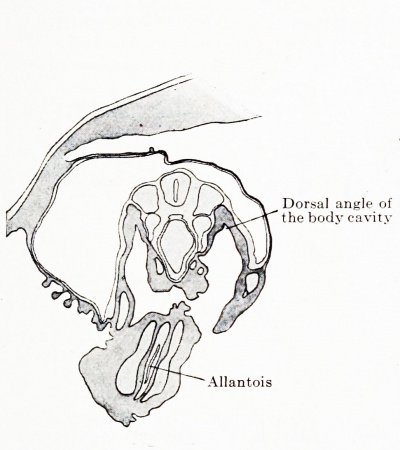
|
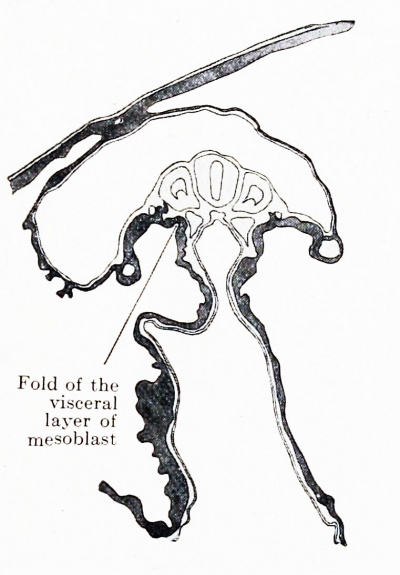
|
| Fig. 544. Transverse section of a human embryo of 2.6 mm greatest length and with 13-14 pairs of primitive segments, at the level of the 13th segment. (Embryo Pfannenstiel III, from the collection of Professor Pfannenstiel; slide 11, row 3, section 5.) X 50. The parietal and visceral mesoblasts of the lateral plate meet to form an acute angle; there is only a dorsal body angle and no body wall. The aorta on either side with a ramus intestinalis. | Fig. 545. Transverse section of a human embryo of 2.6 mm greatest length and with 13-14 pairs of primitive segments, at the level of the 9th segment. (Embryo Template:Pfannensteil III, from the collection of Professor Pfannenstiel; slide 9, row 2, section 5.) X 50. Near the dorsal body cavity angle the visceral mesoblast is forming a fold towards the dorsal surface of the intestine. The situation of the dorsal body cavity angle is marked by the attachment of the primitive segment stalk. The aorta on either side with a ramus intestinalis. |
Fig. 546. Transverse section of a human embryo of 2.5 mm. greatest length and with 23 pairs of primitive segments, at the level of the 12th segment. (Embryo R. Meyer 300, from the collection of Professor R. Meyer, Berlin; slide 12, row 1, section 4.) X 50. A fold similar to that of the visceral mesoblast (Fig. 545) has also been formed by the parietal mesoblast. The dorsal body wall, middle plate, is formed by the two folds. The former angle is again marked by the attachment of the primitive segment stalk. A strong ramus intestinalis from the aorta on the left side of the figure (right side of the embryo).
The formation of the urogenital fold begins in the fourth cervical segment ; it is limited at first to the cranial portion of the body cavity and later extends gradually and continuously towards the caudal end of the body cavity to about the 4th lumbar segment. A stage of maximum extent from the 4th cervical to the 4th lumbar segment does not occur, since a degeneration at the cranial end accompanies the caudally directed growth ; actual figures showing the caudal growth and the cranial degeneration are given in the following table:
From this table it may be seen:
- That even in an embryo of 9.5 mm. the caudal growth of the urogenital fold is completed ;
- that the degeneration of its cranial portion is complete in embryos of 2.6 mm. greatest length ; in these the fold is limited to the lumbar region. In older embryos the descent of the cranial limit shows a still greater progress, but this is no longer a result of the abbreviation of the fold, but is due to its rate of growth lagging behind that of the vertebra?.
In the course of its development the urogenital fold undergoes a series of important changes. In the first place, it becomes divided throughout its whole length, with the exception of the cranial and caudal ends, into a genital and a mesonephric fold (Figs. 550 and 552). The anlage of the reproductive gland naturally precedes this division, and although the gland is not represented in Fig. 550, its presence is nevertheless indicated by the displacement of the Malpighian corpuscle (compare Figs. 548 550) ; the space that is formed between this and the surface of the fold is occupied by the genital anlage. The reproductive gland does not, consequently, grow out into the body cavity, but into the urogenital fold. Its growth is made possible only by the displacement of the mesonephric tubules and this displacement again only by the diminishment of the v. cardinalis posterior. Once the reproductive gland is formed it becomes surrounded by a fosse, deep grooves cutting into it laterally and medially. Fig. 549 shows the lateral groove at its first formation ; in Fig. 550 both the lateral and the medial grooves are already considerably developed. During the division of the urogenital fold it becomes still more cut off from the dorsal body wall on its lateral and, as Fig. 550 shows, also on its medial side. Thus the urogenital fold, which at its first formation has a broad base, becomes stalked (Fig. 548) and, at the same time, the stalk becomes twisted; the fold, therefore, no longer lies sagittally (Figs. 547 and 548), but frontally. The formation of a fosse around the genital fold begins somewhat below the cranial pole of the reproductive gland and thence proceeds in a caudal direction. Fig. 552 shows the model of a dividing urogenital fold; the division is here completed to both the cranial and caudal poles.
Fig. 547. Transverse section of the middle plate of a human embryo of 4.9 mm. nape length, at the level of the 17th primitive segment. (Embryo 139, G. 31, from the collection of the 2nd Anatominal Institute, Berlin [Professor O. Hertwig]. x 50. The middle plate is evaginated into the body cavity by the development of the mesonephros; it forms the urogenital fold. The fold separates a medial and a lateral bay of the body cavity. In this and the succeeding figures the excretory ducts are black and the Malpighian corpuscles white. These latter lie just below the summit of the urogenital fold, the excretory duct at the ateral surface of its base.
Fig. 548. Transverse section of the urogenital fold of a human embryo of 7 mm. greatest length at a level between the 13th and 14th trunk segments. (Embryo Chr. l. from the collection of Professor Hochstetter, Vienna; slide 8, row 6, section 7.) x 50. By the ingrowth of the v. cardinalis posterior the urogenital fold is enlarged at the expense of the retroperitoneum, the lateral bay of the body cavity (Fig. 547) penetrates deeply into the latter, and the modification of the base of the fold is thus begun. Compare the depths of the lateral bay of the body cavity in Figs. 547 and 54S. The Malpighian corpuscle determines, as in the preceding figure, the position of the summit of the fold. A new summit has formed near the excretory duct.
The two grooves that form the fossae around the reproductive gland anlage never meet, a portion of the urogenital fold persisting between them and giving rise to the stalk of the genital gland and to the mesogenitale (mesovarium, mesorchium) (Fig. 551). The breadth of the stalk varies ; at the cranial pole it is considerable, immediately below this it diminishes so much that the mesogenitale becomes thread-like, and it remains in this condition as far as the caudal pole of the reproductive gland, where it again increases in size so long as the gland is not completely developed in this region. Fig. 553 may serve to show the size of the urogenital fold as compared with the transverse section of the entire embryo and also to make clear its topographic relations ; the fold is here divided into the mesonephric and genital folds, both of which seem very small as compared with the anlagen of the suprarenal body, the enormously developed liver and the large stomach. In the second place the mesonephric fold, separated from the urogenital fold, becomes further subdivided in correspondence with its contents. Proceeding medially from the lateral surface one meets in it (Fig. 551) : the Mullerian duct, the excretory duct and the convolutions of the mesonephric tubules. The fold forms first a portion for the Mullerian duct, the tubar portion, then a common portion for the excretory duct and the mesonephric tubules, the gland portion, and, finally, the thread-like connection with the posterior abdominal wall, the mesentery portion. The tubar and gland portions regularly become separated by a slight furrow that projects in from the lateral surface; the gland portion passes over gradually into the mesentery portion. In the contents of these three portions a sexual difference becomes evident to the extent that while in female embryos the tubar portion contains only the Mullerian duct, in males it contains both the Mullerian and the
The formation of the various portions begins at the cranial pole and proceeds caudally, and the lateral portions are formed earlier than the medial ones. Consequently one sees at first only the tubar portion and this' only in the cranial region of the fold. The separation of the' tubar portion begins in embryos of 13 mm. greatest length. It is the most freely movable portion of the mesonephric fold and this mobility serves to explain the peculiar wandering of the ostium abdominale which occurs later on.
Fig. 551. Transverse section of the right urogenital fold of a human embryo of 5 cm head-foot length. (Embryo R. Meyer 272, from the collection of Professor R. Meyer, Berlin; slide 2, row 1, section 2.) The mesonephric fold is incompletely divided into three portions by a groove in its dorso-lateral surface and by the narrowing of its base; the tube portion with the transverse section of the Miillerian duct, the gland portion with the transverse section of the excretory duct and the mesonephric tubules, and the mesentery portion. The mesonephric fold is beginning to grow around the reproductive gland portion.
A third change is in the course of the urogenital folds. Originally both folds lie parallel to the vertebral column, as may be seen from the parallel course of both mesonephroi in an embryo of 9 mm. greatest length (Fig. 565) ; but as soon as new organs appear between them in the middle line, they become displaced. Already the influence of the suprarenal bodies may be seen in an embryo of 9.5 mm. greatest length, the two folds, which originally lay close together, becoming forced apart. What is begun by the suprarenal bodies is continued by the metanephroi ; they displace the two mesonephric folds still more laterally. We have seen above that at first the whole posterior body wall was invaginated into the body cavity as the urogenital folds. The folds can only be displaced laterally by a broadening of the posterior body wall and an increase in the frontal diameter of the body cavity. The increase occurs apparently in the middle line, since the topographic relations between the urogenital fold and the lateral body wall do not alter, as is shown in Figs. 547-551. Caudal to the metanephros the enlarging force ceases, and in this region the frontal diameter does enlarge and the urogenital fold is not displaced. The occurrence of a displacement above and its absence below necessarily produces a bend of the fold. This is a double bend, and the fold acquires by it a bayonet form; there may be distinguished an upper sagittal, a middle transverse and a lower sagittal portion (Fig. 552). The more the suprarenal bodies and the metanephroi grow later on, the more they cause the upper sagittal portion of the fold to assume an oblique position. The mesentery of the genital fold is fully formed only in the region of the upper sagittal portion and this alone obtains from it a great mobility and consequently alone can yield to the pressure of the neighboring organs. The liver, which grows but does not undergo displacement, does not exert the slightest influence on the urogenital fold, but, on the other hand, both the stomach and intestine alter their position and both must therefore influence the position of the urogenital fold. The stomach, and with it the spleen, becomes displaced to the left side and is rotated; the large coil which becomes the large intestine tends for the most part to the left, and, consequently, both it and the stomach will affect the left urogenital fold, the descending colon coming to lie on its medial side, while the ascending colon runs from the beginning on the lateral side of the right fold. The left urogenital fold yields to the pressure of the stomach and intestine and is displaced by it further in the same direction as it was forced by the suprarenal body and metanephros. This displacement may be carried to such an extent that the upper sagittal portion of the left fold comes to lie horizontally and, therefore, can no longer be distinguished from the horizontal portion. This displacement I observed first in an embryo of 29 mm. greatest length ; from that stage onward it was usually to be made out in embryos of both sexes.
Fig. 552. Model of the posterior abdominal wall of a human embryo of 19.4 mm greatest length. (Embryo Ma. 2, from the collection of Professor Hochstetter, Berlin. The model was prepared by my students Massard and Chome.) The visceral layer of peritoneum is shown cut and one sees the superior recess of the omental sack. The urogenital fold is divided as far as its upper and lower ends into the mesonephric and genital folds. The mesonephric fold is bayonet-shaped and an upper sagittal, a horizontal and a lower sagittal portion, and a first and second bend may be distinguished. At the first bend the mesonephric fold is connected with the anterior abdominal wall by the inguinal fold. Between the aa. umbilicales, which still run horizontally, is the bladder plate.
Fig. 553. Transverse section of a human embryo of 19.4 mm greatest length, at the level of the 21st spinal ganglion. (Embryo Ma. 2; slide 5S, row 2, section 1. From the collection of Professor Hochstetter, Vienna.) The section is intended to show the topographic relations of the abdominal viscera. The stomach has begun to twist to the left and, with the spleen, is in contact with the left urogenital fold. The two urogenital folds are still symmetrically placed; they are divided into the mesonephric and the genital folds. Between the two urogenital folds are the adrenal bodies; behind these lie the metanephroi, surrounded by a very loose tissue.
The influence of the intestinal tract in displacement may, of course, be stronger and may therefore produce anomalies of development. It will be seen in the following paragraph that the lower sagittal portions of the two urogenital folds unite throughout their whole length in the median line; the extent of the union may be lessened or quite prevented by an abnormal influence on the part of the intestine. This gives a possibility for the explanation of double formations of the uterus. In the same way the pressure of the stomach and intestine may give the reproductive gland a position in which it cannot effect the connections made in normal development; I refer, principally, to the connection of the testis with the inguinal fold, whose failure results in a failure of the testis to enter the inguinal canal.
A fourth change affects the caudal sagittal portion of the urogenital fold. In this region the two folds come together and fuse, and by this fusion a frontal partition is formed, which divides the primitive pelvis into a ventral and a dorsal half; this frontal partition is termed the genital cord (tr actus genitalis) ; it fuses with the floor of the body cavity and the partition is thus a complete one. In Fig. 554 a, b and c three sections through the lower portions of both urogenital folds are shown ; the mesonephric and reproductive folds are separated, merely a thread-like mesogenitale uniting them; the tubar portion and the lateral part of the gland portion are thrown into an angle directed towards the medial part of the gland portion and bend around the ventral surface of the reproductive gland; they are, however, still far from the median line. In section b the mesonephric folds are hearer together and in c their union has occurred. The formation of the genital cord takes place in embryos between 19.4 and 21 mm. greatest length ; the upper edge of the genital cord lies at the level of the lower border of the third lumbar vertebra (embryos of 36 mm. greatest length), but later a passive displacement to the lower border of the fourth or even the fifth lumbar vertebra mav occur.
| Fig. 554 a, b, and c. Three transverse sections through a human embryo of 30 mm. trunk length. (Embryo R. Meyer 273, from the collection of Professor Meyer, Berlin; slide 11, row 4, section 2; slide 13, row 5, section 2; slide 14, row 5, section 2.) The three sections show the formation of the genital cord. The legends have been arranged so that different structures are indicated in each section and the reader should first study the legends in all three figures. | ||
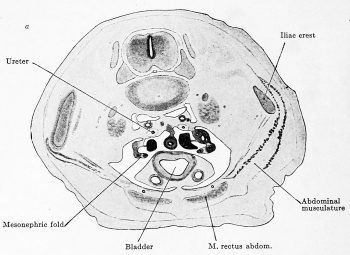
|
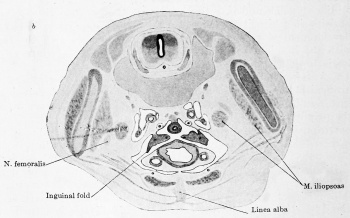
|
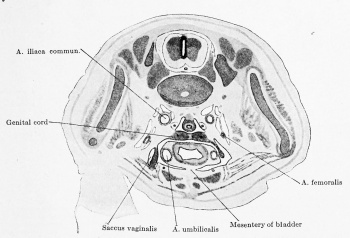
|
| a. The mesonephric fold bends between the tubar and gland portions at a right angle and is growing around the reproductive gland, so that the left and right mesonephros come to lie in the same frontal plane. The excretory duct and the tube are shown in the mesonephric fold. The originally lateral tube comes to lie medially, as a result of the bending of the fold. | b. An evagination (the inguinal fold) extends from the mesonephric fold between the bladder and the lateral wall of the body to unite with the posterior surface of the anterior abdominal wall (in Fig. c it is cut throughout its entire length). The right and left mesonephric folds have come nearer together. | c. The two mesonephric folds have united in the middle line to form the genital cord. By this and the two inguinal folds the body cavity is divided into four parts, — the excavatio recto-uterina between the posterior body wall and the genital cord; a space between the genital cord, the posterior wall of the bladder and the inguinal folds, from which the excavatio vesico-uterina and the medial part of the saccus vaginalis (see section on descensus) are formed; and two lateral spaces between the plica inguinalis and the lateral abdominal wall, which become the lateral part of the saccus vaginalis. |
The genital cord seems to be formed at once throughout its entire length, since the upper boundary is found at the same place in all embryos of this period.
Sexual differences appear with the formation of the genital cord. Fig. 554 c is taken from a female embryo and in it one sees a distinct excavatio vesico-uterina between the genital cord and the bladder; in male embryos the mesonephric folds, approaching one another in the median line, at once unite with the wall of the bladder and they, therefore, do not possess a vesicouterine pouch (Fig. 555).
A fifth and last change in the urogenital fold is brought about by its connection with the lateral, later the anterior, abdominal wall. Already in an embryo of 13 mm greatest length a knobshaped growth, the inguinal fold, forms at the first bend (Fig. 552). In sections it resembles the anlage of the reproductive gland, which lies on the medial side of the urogenital fold, except that it is a true growth and is not, like the reproductive gland, grooved out of the fold. The growing inguinal fold very soon reaches the lateral abdominal wall in its dorsal half and then unites with a ridge of the wall which I shall call the inguinal crest (Fig. 556 a and b). By this union the horizontal portion of the urogenital fold becomes dependent from the lateral abdominal wall; as a result changes in the position of the urogenital folds must ensue.
The anterior abdominal wall is now almost horizontal ; immediately at the oral slope of the genital tubercle the ectoderm of the surface of the body passes directly over into the wall of the umbilical cord. In Fig. 557 a median section of an embryo of 24 mm. vertex-breech length is shown; the outer contour of the body extends from the tip of the tail over the anal and urogenital orifices to the phallus, and at the cranial surface of this it bends around and passes over into the caudal surface of the umbilical cord. Later, on the closure of the wide umbilicus, the anterior abdominal wall is bent upward and becomes horizontal. That is one of the changes. The other is best seen by comparing the position of the m. rectus abdominis in embryos of different ages; as soon as muscle fibres are to be made out, the muscle lies in the middle of the lateral wall of the body, so that to acquire its definitive position it must be pushed along the abdominal wall to the median plane. It may, in brief, be said that the anterior abdominal wall is pushed in two directions, on the one hand cranially and on the other medially. The pushing takes place during the division of the urogenital fold into the reproductive and mesonephric folds and during the development of the different parts of the latter. The inguinal fold thereby arises finally from the tubar portion of the mesonephric fold (Fig. 554 b and c). The wanderings of the anterior abdominal wall will affect the tubar portion and the adjacent part of the gLand portion, and we may theoretically assume a wandering of the tubar portion, such as actually takes place in the formation of the genital cord. If the formation of the anterior abdominal wall is disturbed or delayed an effect upon the formation of the genital cord is possible, and herein is a second possibility for double formations of the uterus.
Fig. 555. Median section of a human embryo of 50 mm head-foot length. (Embryo R. Meyer 257, from the collection of Professor R. Meyer, Berlin; slide 16, row 3, section 1.) X 8. On the development of the genital cord the first indication of a sexual difference appears. In the male the two mesonephric folds fuse with the posterior wall of the bladder before they unite to form the genital cord, and this fusion persists also after the union. The urogenital sinus is cut lengthwise; the anterior border of its external orifice reaches already the coronary sulcus of the glans. Between the external orifice of the sinus and the anus the aboral periphery of the phallus and the perineum are beginning to form.
Fig. 556 a and b. Transverse section through the urogenital fold at the level of the inguinal fold in a human embryo of 22.5 mm greatest length. (Embryo R. Meyer 303, from the collection of Professor R. Meyer, Berlin; slide 34, row 2, slide 1 and row 4, section 1.) a. Passes through the inguinal crest and the intermuscular part of the chorda gubernaculi. Bl., bladder, b. Shows the union of the inguinal fold with the inguinal crest, by which the urogenital fold becomes united with the lateral abdominal wall.
Fig. 557. Median section of the lower half of the body of an embryo of 24 mm vertex-breech length. (Embryo Hal. I, from the collection of the I Anatomical Institute, Vienna [Professor Zuckerkandl]; slide 44, row 1, section 2.) The urethral plate is reconstructed from four sections. An anterior body wall does not yet exist; the umbilicus begins immediately at the oral slope of the phallus.
The Mesonephros
General
The mesonephric tubules develop after the pronephric. They are formed from the same parent tissue, the stalks of the primitive segments, in almost the same segments, and they make use of the same efferent canal, the primary excretory duct. Comparative embryology teaches that the mesonephric tubule, like the pronephric one, is a composite structure. A mesonephric segment consists of a principal and a supplemental tubule, the former being an evagination of the parietal layer of the primitive segment stalk, while the latter is the lateral portion of the segment stalk itself. From the supplemental tubule there are formed the mesonephric chamber, in this case termed Bowman's capsule, and the nephrostome canal, the distinction between the two resulting from the enlargement of the medial portion of the supplemental canal to form Bowman's capsule. This is invaginated by a vascular glomerulus, whose efferent stem arises directly from the aorta. A comparison of this account of the development of the mesonephric tubule with that given on p. 759 for the pronephric tubule will show a complete correspondence. The development of the mesonephric tubule might have been illustrated by printing for a second time the plan of the pronephric segment, modification being necessary only in two particulars, the formation of the collecting duct and the external glomerulus. If then the correspondence between the two sets of tubules is so close, how are they distinguished? In three ways : 1, by their appearance before or after the excretory duct ; 2, by the presence or absence of an external glomerulus, and 3, by the point of origin of the principal tubule from the stalk of the primitive segment.
Let us first consider the last point. The principal tubules of the mesonephros arise more medially than do those of the pronephros. This difference does not, however, suffice in all cases for a differential diagnosis of the two kinds of tubules. If a pronephric and a mesonephric tubule are formed in the same segment and if, furthermore, the anlage of the mesonephric tubule appears while the pronephric tubule is still present, then it is possible to distinguish the two by their position, the pronephric tubule lying lateral, nearer to the lateral plate, the mesonephric one medial, nearer to the primitive segment. But whoever has studied the development of the two provisional excretory organs in the vertebrate series must admit that these two conditions are very rarely fulfilled. If in a given segment only one excretory tubule is formed, or if the pronephric tubule is completely degenerated before the mesonephric one appears, then the position of the principal tubule under consideration, with reference to the primitive segment stalk can give no conclusive evidence as to its character, and this for the following reasons : The supplemental tubule, which, according to the account given above, is the same structure in both the pronephric and mesonephric tubules, may with advancing development be partly taken up into the lateral plate or into the body cavity derived from it. If this shortening of the supplemental tubule occurs before the mesonephric tubule is formed, the origin of the principal tubule of the latter may apparently lie at the very spot where that of the pronephric tubule should occur, namely quite laterally and close to the wall of the body cavity, in some cases, indeed, at the wall. As to the second distinction between the two tubules the following may be said : The occurrence of external glomeruli is distinctive for the pronephros; their absence, however, is no evidence that a tubule must be a mesonephric one, since the glomerulus may also be wanting to a pronephric tubule. I have expressly stated above that the external glomerulus is characteristic of the pronephros and not of a pronephric tubule ; it is quite independent of its tubule and is merely invaginated into the body cavity beside it. This independence of the external glomerulus is shown by the fact that it degenerates independently of the other constituents of the pronephric segment; it always degenerates, but frequently only when the pronephric tubule has already vanished and the mesonephric tubule has developed. An external glomerulus may therefore occur beside a mesonephric tubule as well as beside a pronephric one, and its presence is no decisive evidence as to the character of the tubule occurring in the same segment with it. It tells that in a given animal a pronephros was present, but it does not say that the tubule occurring beside it is a pronephric tubule.
There thus remains as a distinctive indication of whether a tubule is mesonephric or pronephric only the first point, its relation to the excretory duct. Whatever tubules are developed before or simultaneously with the excretory duct are pronephric, those formed after it are mesonephric, This difference can only be determined embryologically, it is of no avail in the case of developed tubules. It is not possible, therefore, on the first study of a fully formed organ to determine whether it is pronephric or mesonephric ; but if by earlier studies the limits of the two organs have been determined and we know how far caudally the pronephros and how far cranially the mesonephros extends, then, without any further evidence, we may speak of pronephric or mesonephric tubules in the case of segments in which only one kind occurs; in all other segments the determination must rest upon a study of the development.
In those vertebrates in which the pronephros extends the entire length of the body cavity, it is at once evident that the pronephric tubules form a first and the mesonephric a second generation of excretory tubules. The mesonephric tubules are, accordingly, something new, distinguishable from the pronephric tubules; it will occur to no one to regard the fruit of one year as of the same generation as that of a preceding year. In the vertebrates in which the pronephros is shortened, the matter is not so clear; indeed, it may be so obscure that one is led so far astray as to regard the pronephric and mesonephric tubules as equivalent parts of a single system. All investigations that have led to this estimate of the mesonephric tubules have been made on vertebrates with a shortened pronephros. Whoever examines the development of the pronephros and mesonephros throughout the whole series of vertebrates cannot for a moment doubt that the pronephric and mesonephric tubules are members of two different systems.
So far as man, in particular, is concerned, the conditions are more favorable for a distinction between the pronephric and mesonephric tubules. Man has such a high grade of organization that the excretory organ has a long developmental path to traverse before it reaches its completion. This path is shortened by the pronephros developing only rudimentarily. So far as is yet known, no human pronephric tubule develops an internal glomerulus, and, so far as known, every mesonephric tubule, even the most cranial ones that at once undergo degeneration, develops one. In the presence or absence of an internal glomerulus in the Malpighian corpuscles of the human mesonephros we have, then, a means, important because it is so readily made out, of determining the mesonephric character of a tubule.
The Parent Tissue of the Mesonephric Tubules
The parent tissue of the mesonephric tubules is furnished by the primitive segment stalks. In describing the development of the pronephros the process of segmentation of the mesoderm has been considered. It presents two phases. The first phase, that of transverse division of the mesoderm, brings about the formation of the primary primitive segments, the second, that of the sagittal division, divides the primary segments into the secondary segments and the segment stalks (Fig. 520 a, b and c). In man the process of segmentation does not take place quite according to rule. In an embryo with 13-14 primitive segments all three mesodermal structures, the secondary segment, the segment stalk and the lateral plate, are developed in the first ten segments, but from the eleventh on, while the longitudinal divisions occur in the old direction, the transverse ones no longer occur lateral to the region of the secondary primitive segment, so that while there are welldefined secondary segments, there are no distinct primitive segment stalks. The segment stalks, cut out as a whole from the mesoderm, form what is termed the nephrogenic cord. In an embryo with 23 pairs of primitive segments (Fig. 531 a) this cord not only extends throughout the entire segmental region, but also through a portion of the unsegmental one to the region of the cloaca; in other words, the segmentation process in the posterior portion of the embryo passes through two phases, but they are in inverted order. The sagittal divisions, which originally formed the second phase, occur first and separate, at first incompletely, the lateral plate, nephrogenic cord and primitive segment plate; the transverse divisions, originally the first, now succeed as the second phase, but they only divide the primitive segment plate into the individual secondary segments, the nephrogenic cord remaining undivided. In an embryo of 4.25 mm. vertex-breech length and with 28 pairs of primitive segments the nephrogenic cord extends to the 28th segment, in any case as far as the point where the primary excretory duct applies itself to the wall of the cloaca ; here the cord appears somewhat thickened, its caudal end being lost in the as yet undivided mesoderm of the tail. In no embryo is the nephrogenic cord present in its full extent, for while it is growing caudally it is dividing at its cranial end into the anlagen for the individual mesonephric tubules.
The primary excretory duct in the pronephric territory lay lateral to the primitive segment stalk. It retains this position in its growth caudally and accordingly lies lateral to the nephrogenic cord (Figs. 558 a, 559 and 562).
The nephrogenic cord in an embryo of 5.3 mm. greatest length and 4.6 mm. nape length is interrupted in the 26th or 27th segment (3rd or 4th lumbar segment). The compact cord, which is rather sharply marked off from the surrounding mesenchyme, becomes looser in this region, its cells separate from one another and, finally, are no longer to be distinguished from those surrounding it. Thus the cord becomes divided into two unequal portions, a long cranial one, from which the mesonephric tubules develop, and a short caudal one, from which the metanephric tubules arise. Following Schreiner (1902) the two portions may be termed the mesonephro genie and the metanephrogenic cords. Nothing is to be seen of the division of the nephrogenic cord in an embryo of 4.9 mm. nape-length; in one of 5.3 mm. greatest length it is completed.
Formation of the Mesonephric Tubules from the Mesonephrogenic Cord
Immediately after its formation the nephrogenic cord becomes divided, at first only at its cranial end, into a series of spherical masses of cells. In an embryo of 2.5 mm. greatest length and with 23 pairs of primitive segments, anlagen of mesonephric tubules are present in the 13th, 14th and 15th segments, i.e., in the 2nd, 3rd and 4th thoracic segments (Fig. 531 a). In this embryo neither has the nephrogenic cord completed its growth caudalry, nor has the excretory duct reached the cloaca. In an embryo of 4.25 mm. vertex-breech length and with 28 pairs of primitive segments, mesonephric anlagen occur as far back as the 26th segment, i.e., as far as the third lumbar segment, and this caudal limit is not exceeded at first. In this embryo the growth of the nephrogenic cord is completed and the excretory duct has reached the cloaca. The formation of the mesonephric tubules is, accordingly, completed in a rather short space of time ; they are formed almost at a stroke. The mesonephros, however, grows not only caudally, but also at first cranially. In an embryo of 2.5 mm. greatest length the first mesonephric tubule lay in the 2nd thoracic segment, in one of 4.25 mm. vertex-breech length and in one of 4.9 mm. nape length the first tubule was in the 7th cervical segment, and, finally, in one of 5.3 mm. greatest length in the 6th cervical segment; cranial to the 6th cervical segment I have found neither anlagen of mesonephric tubules nor tubules in process of degeneration. Details of the development of the mesonephros may be obtained from the appended table. Its anlage extends over 18 segments, from the 6th cervical to the 3rd lumbar, and in these eighteen segments there are developed in maximo 83 tubules; this number I have obtained by estimating from the table and adding together the maximal number of tubules occurring in each segment. The distribution of the tubules among the various segments is unequal, as will be seen from the table, but 28 occur in the last 4 segments. Since the pronephros extends from the 5th cervical to the 3rd thoracic segment, mesonephric tubules occur throughout almost its whole territory. Why cannot these later cranial mesonephric tubules be pronephric? At first they are not connected with the primary excretory duct and might therefore represent degenerating pronephric tubules, similar to those which actually occur in the 6th segment of the embryo of 4.25 mm nape length and in the 5th and 6th segments of the embryo of 4.9 mm nape length. The tubules, however, that I have regarded as mesonephric, are all in statu nascendi, they do not differ in any respect from what are undoubtedly mesonephric tubules in the more posterior segments and they also later acquire a connection with the primary excretory duct.
Fig. 558 a and b. Transverse section of a human embryo of 2.5 mm greatest length and with 23 pairs of primitive segments, at the level of the 13th segment. (Embryo R. Meyer 300, from the collection ot Professor R. Meyer; slide 12, row 4, section 5.) < 317. The section passes through the nephrogenic cord in the interstitium between two anlagen of mesonephric tubules. The primary excretory duct lies on the outer surface of the cord as a semilunar structure.
Fig. 559. Transverse section of a human embryo of 2.5 mm greatest length and with 23 pairs of primitive 3egments, at the level of the 13th segment. (Embryo R. Meyer 300, from the collection of Professor R. Meyer, Berlin; slide 12, row 4, section 6.) 317. The section passes through the middle of a mesonephric vesicle; the entire nephrogenic cord is not used in the formation of a mesonephric tubule, but a portion of it, situated laterally or ventrally, persists for a time as a rudimentary nephrostome canal. Lateral from the tubule is the semilunar primary excretory duct and the anlage of the V. cardinalis posterior
The anlagen of the mesonephric tubules are from the first dysmetameric, as many as four occurring in a segment ; details as to the numbers are given in the table facing p. 816. This is not remarkable since the parent tissue has already lost all traces of segmentation.
23rd primitive segment Primary excretory duct Mesonephric tubule 21 Mesonephric tubule 20 Mesonephric tubule 19 Ccelom of lateral plate Mesonephric tubule 17 Mesonephric tubule 16 Mesonephric tubule 15 Primary excretory duct 18th primitive segment
In the anterior segments, which are somewhat larger than the posterior ones, the anlagen appear as spherical vesicles in which no distinct lumen is yet visible; in the posterior segments they are more cubical on account of mutual pressure. Figs. 558 and 559 represent sections through the mesonephric region of an embryo of 2.5 mm greatest length and with 23 pairs of primitive segments. Fig. 558 passes through the anterior wall and Fig. 559 through the middle of the third mesonephric vesicle. One sees from both sections that the mesonephric anlage does not exhaust the entire mesonephrogenic cord; a lateral portion remains to form a solid union with the lateral plate and it corresponds to a nephrostome canal. In both figures the primary excretory duct lies lateral to the mesonephrogenic cord. The contour of the vesicle projects beyond that of the mesonephrogenic cord, compresses the excretory duct to a semilunar structure, presses it outwards, thins out the adjacent ectoderm and bulges it out. This prominence of the mesonephric vesicle is the commencing development of the principal tubule.
Fig. 560. Frontal longitudinal section of a human embryo of 4.25 mm vertex-breech length and with 28 pairs of primitive segments. (Embryo II M 1. from the collection of the Anatomical Institute, Zurich; 399, J. 13, row 4, section 5.) 150. The section shows the positions of the mesonephric tubules relative to one another and to the body segments. On the left side only mesonephric vesicles are represented and on the right side only primitive segments. Xo cells occur between the various mesonephric vesicles.
The section shown in Fig. 560 passes through the 15th to the 21st mesonephric anlagen of an embryo of 4.25 mm. vertex-breech length and with 28 pairs of primitive segments. On the right side of the figure only primitive segments have been cut, and on the left side only mesonephric vesicles. One sees the mutually flattening, almost quadrangular mesonephric anlagen so closely apposed that there is scarcely room between them for a single cell. A comparison of the right and left sides of the figure shows the dysmetamerism of the anlagen.
The mesonephric vesicles now undergo a series of modifications, which succeed one another in a cranio-caudal direction. I give a diagramatic representation of them in Fig. 561. The sphere or cube (Fig. 561 a) first becomes an olive-shaped vesicle by becoming hollow and by the lateral growth of the principal tubule (Fig. 561 b), the free end of this latter unites with the primary excretory duct (Fig. 561 c), and the original mesonephric vesicle enlarges, its wall at the same time becoming thin, to form a structure resting upon the principal canal just as the transverse bar of the letter T rests upon the upright. The transverse bar has a cranio-caudal direction, which is not shown in Fig. 561 c. In the angle between the upright and transverse bars the glomerulus appears, sometimes lying on the cranial and sometimes on the caudal side of the upright; the part of the transverse bar with which the glomerulus is associated later becomes much more strongly developed than the other part. Once the connection with the primary excretory duct is accomplished and the anlage of the Malpighian corpuscle is laid down, the tubule begins to bend (Fig. 561 d). The result is two loops with a limb in common (Fig. 561 e). The lumen of the tubule appears first at its medial end and thence extends through the entire tubule to its opening into the primary excretory duct. Of the three limbs the most ventral one situated toward the summit of the mesonephric fold (Fig. 562) becomes the Malpighian corpuscle, from the common limb there is formed a portion of the tubule which we shall term the secretorv tubule, and from the third, dorsal limb another portion of the tubule, the collecting tubule (Fig. 561 e). Fig. 562 shows the general topography of a. mesonephric tubule; the section passes through the 16th right (on the left in the figure) and the 18th left mesonephric tubules of an embryo of 4.9 mm. nape length. The mesonephric fold is almost completely filled by the tubule, which shows its S-shaped bends and the commencing transformation of the ventral limb into the Malpighian corpuscle. The primary excretory duct lies quite laterally in the fold and beneath it is the forming v. cardinalis posterior.
As to the details of development the following may be noted. In an embryo of 2.5 mm greatest length and with 23 pairs of primitive segments there were 8 anlagen of mesonephric tubules, all in the vesicle stage.
In an embryo of 4.25 mm vertex-breech length and with 28 pairs of primitive segments, of the 28 right and 29 left mesonephric anlagen the two first were in the oliveshaped stage (Fig. 561 b), all the rest were round or flattened vesicles. None of the anlagen are connected with the primary excretory duet. In an embryo of 4.9 mm. nape length and with 33-35 pairs of primitive segments there were 36 tubules, and of these the 1st to the 18th have an S-shape (Fig. 561 e), the 19th 20th the form shown in Fig. 561 d, the 21st-33rd are olive-shaped, and the 34th-36th have a round vesicular form; the 35th and the 36th are connected by remains of the nephrogenic tissue and the 36th is not yet separated on its caudal side from the nephrogenic cord. The 1st to the 25th tubules are connected with the primary excretory duct, the 26th-34th have grown toward the duct and are in apposition with it. the 35th and 36th are still free. In the 2nd-12th tubules there is a developed Malpighian corpuscle, in the 13th-lSth tubules the corpuscle is forming.
In an embryo of 5.3 mm greatest length and with 36 pairs of primitive segments there were 32 tubules, and of these the first 25 are Sshaped, the 26th-28th olive-shaped, the 29th31st are round vesicles and the 32nd is not yet fully differentiated. The 1st~20th tubules open into the excretory duct, the 21st-24th are in contact with it, the 25th~32nd are still free. Tubules 1-4 are provided with Malpighian the excretory duct. d. Beginning of formation of the Malpighian corpuscle and the secreting and collecting tubules.
In an embryo of 7 mm. greatest length
Develop- ° f the 31 tubules the lst-25th were S-shaped, ment completed. the 26th-31st olive-shaped. All 31 tubules were connected with the primary excretory duct. Tubules 1-28 showed Malpighian corpuscles (Fig. 565).
Fig. 561 a, b, c, d and e. Diagrams showing the development of the individual mesonephric vesicles, a. Solid vesicle, b. Appearance of the lumen and growth of the principal tubule towards the primary excretory duct. c. The principal tubule reaches Corpuscles.
In an embryo of 9.5 mm.greatest length all the tubules were S-shaped, all opened into the primary excretory duct and all possessed Malpighian corpuscles.
With the appearance of the typical S-shape the mesonephric tubule has essentially completed its development; what follows is an elongation of the individual limbs and their histological differentiation. Fig. 563 shows all parts of a mesonephric tubule in the same section. The Malpighian corpuscle has become a large vesicle that is invaginated by the vascular glomerulus only at a limited region. The Bowman's capsule would enclose the glomerulus twice over; the smallness of the glomerulus in contrast with the size of the capsule must be taken as a characteristic of the human mesonephros. In the 22nd tubule only the edge of the vascular glomerulus is cut; in the 23rd tubule it is more distinct. The section through the corpuscle of the 24th tubule goes through a point where there is no invagination. All the vesicles are lined on their parietal wall by a flattened epithelium; the visceral epithelium, which covers the glomerulus, is of a low cubical form. At the transition of the capsule into the secretory tubule the lumen of the Malpighian corpuscle diminishes and the flattened epithelium becomes cubical and finally cylindrical. The most characteristic feature of the secretorv tubule, iu addition to the cvlindrical form of its cells, is their .clear appearance. The cell boundaries become distinct, the oval nucleus passes into the basal half of the cell and the other half becomes eosinophilic. Very frequently the secreting tubule enlarges in a spindle-shaped manner, as is shown in Fig. 563 ; on the other hand, the transitional region into the Malpighian corpuscle and the collecting tubule always remain narrow. The epithelial differentiation is already indicated in an embryo of 5.3 mm. greatest length in the anterior tubules, the spindle-shaped enlargement was first seen in an embryo of 8 mm. nape length. The transition of the secreting tubule into the collecting one does not fall within the section. At this point the tubule of older embryos forms a loop directed either cranially or caudally. This is the only change that occurs after the tubule has acquired its S-shape. I have studied 200 models of mesonephric tubules from the most different stages of development, and in none of them have I found any coiling of the tubule. Consequently the reconstruction of a tubule which I show in Fig. 192 of my contribution to Hertwig 's Handbuch der vergleichenden und experimentellen Entwicklungsgeschichte (1905), taken from Kollmann, must represent a very exceptional rarity. The collecting tubule runs almost straight to the primary excretory duct and is lined by a dark, cubical epithelium.
Fig. 562. Transverse section of a human embryo of 4.7 mm. vertex-breech length, 4.9 mm nape length, and with 33-35 pairs of primitive segments. (Embryo 137, G. 31, from the collection of the II Anatomical Institute, Berlin, Professor O. Hertwig; slide 12, row 2, section 1.) The'section shows in its upper part the position of the completely developed mesonephric canal in the urogenital fold and the size of both relative to the entire embryo. In its lower part it still shows the nephrogenic cord plainly, on the left it is in process of breaking up. In the cloaca the rectal portion is beginning to differentiate from the urogenital sinus portion.
Fig. 563. Transverse section of the urogenital fold of a human embryo of 9.5 mm greatest length and with 38-39 pairs of primitive segments. (Embryo Ma. 3, from the collection of Professor Hochstetter, Vienna; slide 12, row 1, section 1.) X 175. The section passes through the 10th thoracic segment. In the fold there succeed each other in the dorso-ventral direction the v. cardinalis post., the complete 22nd tubule, a section of the Malpighian corpuscle of the 23rd tubule and a section through a portion of the Bowman's capsule of the 24th tubule, without any vascular glomerulus. From the Bowman's capsule of the tubule the secretory tubule gradually develops, it ascends upwards for a short distance and then bends medianly almost at a right angle, enlarges, and again bends around and runs as the collecting tubule to the primary excretory duct. At the point where it bends around to become the collecting tubule it makes a srnalljjoop and here the tubule appears to be interrupted, the ends of the secretory and collecting tubules appearing in section. The 14th mesonephric artery arises from the aorta, but it cannot be followed further. The reproductive gland anlage is of great extent, but has not yet begun to proliferate.
Fig. 564 a and b. Transverse section of the mesonephric fold of a human embryo of 4.9 mm nape length at the level of the 14th primitive segment. (Embryo 137, G. 31, from the collection of the II Anatomical Institute, Berlin, Professor O. Hertwig; slide 13, row 1, section 3.) - 150. The figure shows distinctly a mesonephric ccelomic funnel. It probably is in connection with a rudimentary nephrostome canal, but its lumen is not continued into the lumen of the tubule.
Later, when the various parts of the tubules increase in thickness they no longer find sufficient room to lie beside each other in the transverse plane and they become displaced either caudally or cranially, the collecting tubule sometimes and sometimes the secretory one coming to lie more cranially.
The connection of the various mesonephric vesicles with the lateral plate, which is shown in Figs. 558 and 559, disappears completely in the anterior tubules, but in the posterior ones it may persist for a time and may be invaginated in a funnel-like manner ; the lumen of the body cavity, however, never reaches that of the mesonephric tubule. Fig. 564 shows one of these ccelomic funnels, that is situated at the point where the primitive segment stalk originally was. A large number of such funnels occur in an embryo of 4.9 mm. nape length, one corresponding to each 21st, 23rd and 28th-32nd tubule on the right and on the left to the 22nd and the 24th-34th.
The union of the tubules to form the mesonephros and the position of the various tubules in this can only be followed in a model. Fig. 565 shows a model of both mesonephroi of a human embryo of 7 mm. greatest length. The mesonephroi are still in the process of development; of the 30-31 tubules present on either side only the 25 cranial ones are fully formed. Both mesonephroi form almost a straight line and are parallel, the Malpighian corpuscles being so placed one above the other that they form a column ; in reality, however, the mesonephroi are not straight but are curved in correspondence with the contour of the body. The Malpighian corpuscle passes over into the secretory tubule always at its lateral side, and the secretory tubule passes over into the collecting one on the medial side of the corpuscle. The corpuscle and the two tubules still lie in the same plane; the coil that they form is almost in contact with the primary excretory duct. The space at the disposal of the various tubules within the mesonephros is still quite sufficient for the degree of development they present, and consequently while the Malpighian corpuscles are to some extent in contact, they do not press upon one another. If one compares the corpuscles of the mesonephros with those of the metanephros, the size of the former is striking, and this size brings it about that the vascular glomerulus never fills the entire cavity of the Bowman's capsule, both its cranial and caudal ends remaining free from vascular loops. Figs. 566 and 567 represent the model of both mesonephroi of an embryo of 9.5 mm. greatest length. The organs are fully developed, each of the 32-34 tubules consisting of a Malpighian corpuscle, a secreting and a collecting tubule. A comparison with Fig. 565 shows that the separation of the two organs transversely has begun. The excretory duct in the model represented in Fig. 565 runs in a straight course to the point where the ureter is given off; the right-angled bend caudal to the 31st right tubule is an illusion of perspective, the excretory duct, which is seen partly from the right side, making a strong bend ventrally.
The duct of the model shown in Fig. 566 is curved and the curvature is especially marked in the lower portion caudal to the 24th right tubule. This curvature of the duct corresponds to the bayonet-shaped bending of the urogenital fold (Fig. 552). The Malpighian corpuscles also form a column. They press upon or overlap one another, however, as a result of their increased size. As the lateral view (Fig. 567) shows, individual corpuscles have already been forced dorsally or ventrally. The collecting and secreting tubules have increased in size and their connecting loops now frequently pass beyond the medial borders of the Malpighian corpuscles, a fact which is of importance for the understanding of the urogenital union. The parts of the various tubules no longer lie in the same transverse plane ; the Malpighian corpuscle has dropped down and frequently lies at the same level as the collecting tubule of the next mesonephric segment. Finally, in Fig. 568 the model of the right mesonephros of an embryo of 19.4 mm vertex-breech length is shown. The mesonephroi have separated still more (Fig. 552 is taken from the same embryo) ; that the cause of this separation is the suprarenal bodies and the metanephroi has already been shown in the section on the urogenital fold. As a result of it the curvature of the primary excretory duct becomes continually stronger, since it must reach the medially placed bladder, and now it appears to be bent around almost at a right angle. This strong curvature cannot be without influence on the tubules of the region in which it occurs. Even from the 24th tubule downwards the Malpighian corpuscles are pressed together and form in their totality an arch convex caudo-laterally. The corresponding tubules are greatly elongated, the collecting tubules form long passages which converge towards the concave side of the arch of Malpighian corpuscles and then bend around into the secreting tubules; they are thereby greatly pressed together, lying close beside each other through long stretches and may connect with one another. By this new union the collecting duct of one tubule may serve as the efferent for several. A further result of the bending of the excretory duct is the union of the orifices of several of the collecting tubules to form a single one. In this way the number of collecting tubules opening into the excretory duct is diminished and no longer corresponds with that of the Malpighian corpuscles. I shall discuss later in a special section the degeneration phenomena which are clearly shown in Fig. 568. As the result of a strong growth of the collecting tubules the entire coil of a mesonephric segment is further away from the excretory duct, and with further development the interval becomes continually greater until, finally, there occurs the already described subdivision of the mesonephros into two portions, a lateral one with the excretory duct and the lateral portions of the collecting tubules, and a medial one with the Malpighian corpuscles, the secreting tubules, and the medial portions of the collecting ones.
Fig. 565. Model of the mesonephroi, the metanephroi and the bladder of a human embryo of 7 mm greatest length. (Embryo Chr. 1, from the collection of Professor Hochstetter, Vienna. The model has been prepared by my students A. Wachter and E. vonWyss.) View from in front. 75. The mesonephroi have a perpendicular position and the individual tubules are at sufficient distances, so that the Malpighian corpuscles lie in a single row. The lowest tubules are still developing, but have already united with the excretory duct (Fig. 561 e). The fully developed canals are S-shaped. Most ventrally are the Malpighian corpuscles, then in the middle is the secreting tubule and most dorsally the collecting tubule. The loop formed by the secreting and collecting tubules usually has not yet reached the medial border of Bowman's capsule. The whole coil of a mesonephric segment (Malpighian corpuscle and the two tubules) lies still in one horizontal plane. The primary excretory duct is narrow in its upper part and only widened in a spindle-shaped manner corresponding to the entrance into it of a collecting tubule; in its lower portion it is remarkably wide and the spindle-like enlargements have disappeared. Towards the bladder the duct narrows again. The ureters are short and almost straight canals terminating in clubshaped enlargements.
Fig. 566. Model of the mesonephros of a human embryo of 9.5 mm greatest length. (Embryo Ma. 3, from the collection of Professor Hochstetter, Vienna. The model was prepared by my students J. Klausler and Wydler.) Seen from in front. 75. The two mesonephroi are slightly curved. The individual tubules are pressed together; the Malpighian corpuscles as a result no longer form a single row, but some are beginning to overlap their neighbors. All the tubules are bent into an S-shape. The opening of each tubule into the excretory duct lies about on a level with its Malpighian corpuscle, sometimes slightly more cranially, sometimes slightly more caudally. The various openings are not always the same distance apart. Some tubules are already broken down, on the right the 1st, 3rd and 4th, on the left the 1st, 2nd, 4th and 5th. Some have a common collecting duct, the 15th and 16th, the 19th and 20th. Some Malpighian corpuscles are entirely without tubules, 5a and 27 on the right, 22 on the left. Some tubules are completely formed, but have no opening into the excretory duct, on the right the 16th, on the left the 23rd. The excretory duct is widened in its caudal course from the opening of the 21st tubule, and beyond the opening of the last tubule it narrows again. Seen from in front the bladder appears foreshortened, one looks directly on the cloacal membrane.
Fig. 567. The same model that was represented in Fig. 566 seen from the right side. The figure shows how the Malpighian corpuscles as they enlarge press each other out of the row. The primary excretory duct increases in size in its caudal half, the increase affecting both the dorsoventral and the frontal diameter, the latter to the greater extent It again diminishes before its union with the ureter. This has already developed the primitive pelvis of the kidney, from which the cranial and caudal pole tubules are beginning to grow out. J. The common terminal part of the ureter and the primary excretory duct still persists, but is greatly enlarged. The cloaca is almost completely subdivided.
The special relations of the caudal tubules make possible a division of the mesonephros into a cranial and a caudal portion; a similar subdivision occurs in the mesonephros of all vertebrates. The upper portion later unites with the reproductive gland and becomes the sexual portion of the mesonephros, the epigenitalis (epididymis in the male, epoophoron in the female). The lower portion in animals without a metanephros becomes the actual functioning kidney and is consequently termed the glandular portion, but in animals in which the metanephros separates from the mesonephros this lower portion also undergoes degeneration and becomes the paragenitalis (paradidymis in the male, paroophoron in the female).
The primary excretory duct is also modified during the development of the mesonephros. It is at first (in embryos up to 4.25 mm. vertex-breech length) solid. Its lumen appears discontinuously, at first at both ends ; at the caudal end the lumen appears to extend into it from the cloaca. In an embryo of 7 mm. greatest length the lumen is fully formed and the excretory duct is in open communication with the cloaca. The course of the duct to its opening is not straight. Attention has already been called to the frontal bend which gives the first impetus to the concentration of the paragenitalis. A second bend in the sagittal direction appears quite early. In an embryo of 4.25 mm. vertex-breech length, the duct extends to the 28th primitive segment, parallel to the vertebral column. Having arrived at this point it bends almost at a right angle and reaches the bladder by a short horizontal piece. This bend is important ; I shall term it the sagittal bend of the excretory duct.
At the openings of the collecting tubules the excretory duct is widened. In the upper portion these widened places are separated by narrow ones, but in the lower part they flow together (Figs. 565, 566). The wide portion of the duct thus formed has at least twice the diameter of the unwidened cranial portion. This widening persists for an extraordinarily long time, and one might be inclined to correlate it with the ampulla of the ductus deferens which is formed later on. That is not possible, however, for the widening completely disappears, as will be seen from what follows. It has already been pointed out that the widened places receive the collecting tubules of those mesonephric tubules which later concentrate to form the paragenitalis. I shall anticipate by stating that the union of several collecting tubules of the paragenitalis to form a common terminal part, already referred to in the description of Fig. 568, continually progresses in the later stages of development, until, finally, only a single efferent duct remains, which, in the adult individual, is the ductulus aberrans Halleri. With the formation of this ductulus it becomes possible to determine the position of the embryonic widening; it corresponds to the lower part of the epididymis. It extends down to the sagittal bend of the excretory duct and at this point the duct becomes smaller; its horizontal piece is narrow. In Fig. 568 a narrowed portion of the excretory duct occurs in the region of the openings of the 24th-29th collecting tubules. The duct does not, however, actually narrow; the appearance is produced by a spiral twisting of the duct through 90°. It is very possible that this twisting is due to the union of the mesonephric fold with the anterior abdominal wall by means of the inguinal fold. In the section on the urogenital fold the displacement of the anterior abdominal wall and the influence this exerts on the entire mesonephric fold have been described. This influence will, naturally, also be felt by the contents of the fold and thus the spiral twisting of the primary excretory duct may be the result of a displacement of the anterior abdominal wall which is carried to the mesonephric fold by the inguinal fold.
Finally the relation of the excretory duet to the a. umbilicalis must be considered. The artery has two root areas, a visceral one from the rami intestinales and a parietal one from the parietoventral vascular arches of the aorta. The visceral root area begins in the third cervical segment and extends into the lumbar region. It is present throughout its entire length in no embryo ; the individual roots are developed in succession ; at first only the cervical ones are present ; then the origin of the artery wanders more caudally into the upper thoracic region, and the cervical roots degenerate; after the thoracic roots have functioned for a time the artery wanders into the lower thoracic and the upper thoracic roots become fused, and so on. The parietal root area first appears when the artery has reached the lumbar region. From its mode of origin the visceral root area must lie to the medial side of the excretory duct and the parietal area on its lateral side. Since both root areas exist for a time together, the excretory duct runs in an island surrounded directly by the arteries; in Fig. 569 a section is shown passing through a region where both roots of the a. umbilicalis are present at the same time.
Fig. 568. Model of the right mesonephros and Mullerian duct of a human embryo of 19.4 mm, greatest length. (Embryo Ma. 2, from the collection of Professor Hochstetter, Vienna. The model was prepared by my students Massard and E. Chome'.) The mesonephros has undergone extensive degeneration. All the tubules in the thoracic segments and some of those in the lumbar show degeneration. Either the Malpighian corpuscle is wanting or it is rudimentary and separated from its secreting tubule; this is the case in tubules 1-12, that is to say in a full third of those present. All these tubules are also broken, either in the secreting tubule or between this and the collecting one. These latter are rarely hollow, and if so, their lumina are filled with degenerating epithelium. Finally the tubules 33, 34 and 35 consist only of collecting tubules; 33 has still a portion of the secreting tubule and near it are two large Malpighian corpuscles without any connection. Similarly tubule 31 consists only of a collecting tubule; a Malpighian corpuscle with two secreting tubules seems to correspond with it; some of the remaining tubules are broken, 14, 17, 18, 19; some have solid collecting tubules, 13, 14, 15, 16, 17, 19, 21, 23, 25 and 26, and some solid secreting tubules, 22 and 24; the collecting tubules of 28, 29 and 31 form ureter-like structures. Only the remaining tubules 20, 27, 30 and 32 are fully formed. The appearances of degeneration seen in the most caudal tubules are not to be regarded as persistent without further evidence. From older series it is seen that the lower collecting tubules which have separated from the excretory duct may acquire a new opening into a neighboring collecting tubule, just as separated Malpighian corpuscles and secreting tubules may communicate anew with neighboring tubules. By the bending of the primary excretory duct at the end of the mesonephros, the Malpighian corpuscles of the 26th to the 34th tubules are pressed together so as to form a special group, from which, later, the paragenitalis is formed. The Mullerian duct is quite independent of the ccelomic epithelium and the excretory duct; it is still straight, since its down-growing tip has just reached the head of the excretory duct.
Fig. 569. Transverse section of an embryo of 5.3 mm greatest length and 4.6 mm nape length, at the level of the 24th segment. (Embryo 1420, H. s. 112, from the collection of Professor Keibel, Freiburg i. Br.; slide 12, row 2, slide 1.) X 75. The section passes through the root area of the a. umbilicalis; between the parietal and visceral roots there is an island of tissue in which the primary excretory duct occurs.
The First Degeneration Period of the Mesonephros
The degeneration of the mesonephros occurs in two periods. The first begins even before the organ has reached its full extent and is finished in embryos of 21 mm. greatest length. During its progress the greater part of the mesonephros beginning at the cranial end, is degenerated. The second period comes on so gradually that definite time limits are not possible for it. In it there occurs a new suppression of tubules and the selection of those that will enter the service of the reproductive system and of those that will persist even in the adult as the paragenitalis.
The three models of the mesonephros (Figs. 565, 566 and 568) do not reveal the important part played by the degeneration, that is beginning in the cranial portion ; its influence becomes clear only by a study of the table opposite. In the lowest horizontal column of this table the entire number of mesonephric tubules is given for each embryo in which they were counted. The numbers, as they stand there, vary so little that they do not suggest a necessity for further controls ; we shall further learn from the description of the development of the Mullerian duct that its ostium abdominale lies apparently always at the upper end of the mesonephros in embryos of both sexes throughout the entire development. Both these facts distract the attention of the observer from the really enormous degeneration that the mesonephros undergoes.
The degeneration shows itself as soon as the growth cranially of the mesonephros is completed, that is to say in an embryo of 5.3 mm. greatest length, at a time therefore at which the organ is still growing caudally. It always begins at the most cranial tubule and makes a continuous and regular progress up to the time men tioned above. In the table the number of the tubules occurring in each segment is given, those that are degenerating being given in roman numerals and those that are fullv formed in arabic. An asterisk with an arabic number indicates that the tubule is still developing. If we follow the cranial limits of the various mesonephroi through the table from left to right we see a marked and, what is important for the regularity of the process, a continuous recession of these limits. Beginning with an embryo of 5.3 mm. ureatest length and ending with one of 21 mm. greatest length the line that unites the cranial limits recedes from the 6th cervical to the 1st lumbar segment, that is to say, there is a recession through 15 segments. The relative constancy of the total number of tubules throughout this period justifies the question whether the recession of the cranial limit may not find its explanation in the crowding together of the tubules within a smaller space; the question is all the more justified, because we actually know of the occurrence of this process in the development of other craniota, both in the case of the pronephros and in that of the mesonephros. That there is a crowding together of the tubules during the first period of degeneration is very probable, at all events the table opposite shows an increase in the number of tubules in the segments of the degenerating zone. The process plays, however, only an unimportant part, as is shown by the course of the mesonephric arteries, to be described later on. A crowding together of the tubules of 18 segments into 3 would cause the arteries to assume almost a vertical course, but they remain horizontal throughout the first degeneration period. The principal cause of the caudal recession is the progressive degeneration of the mesonephric tubules. Throughout this period I have uot seen a single mesonephros that did not show degenerating tubules in at least one, usually in two or three of the cranial segments; the regularity of its occurrence speaks for the normality of the process. Reckoned by the segments the upper five-sixths of the mesonephros, the 6th cervical to the 12th thoracic, 15 segments in all, degenerate and only the caudal sixth, the 1st to the 3rd lumbar segments, three segments in all, persist. Estimated by the tubules 57 are degenerated out of a maximum of 83 that develop, that is to say, two-thirds of all the tubules degenerate and 26, or one-third, persist. The number 57 is estimated, not observed; the number 26 was the maximal number found in the enumeration of the tubules of different embryos. Naturally the corresponding portion of the primary excretory duct disappears along with the tubules. Once all the tubules of the cervical and thoracic segments have disappeared, 1 a period of rest supervenes ; from the stage of 21 mm. greatest length onwards, all embryos show a rather constant number of mesonephric tubules in the lumbar segments, but these tubules are almost all broken in one or several places.
The degeneration appears under very different forms: 1. the Malpighian corpuscle may separate from the secreting tubule; 2, the transition of the seci'eting into the collecting tubule may be broken; 3, the collecting tubule may be solid or its epithelium desquamated; 4, the secreting tubule may be broken into several portions; 5, the collecting tubule may not be connected with the primary excretory duct. The variations are arranged according to their frequency of occurrence. The separation of the Malpighian corpuscle from the secreting tubule is almost always to be found in all degenerating tubules and all show a tendency to lose to a greater or less extent their S-shape.
Notwithstanding the degeneration, which occurs in the cranial canals before the beginning of the histological differentiation of their epithelium, an epithelial differentiation between the collecting and secreting tubules occurs very frequently even in the remains of the cranial canals.
Later Formed Tubules
In a 7 mm. embryo the mesonephros has reached its caudal limit and no new anlagen are added in older embryos at the caudal end of the organ, and, furthermore, within the mesonephric area at least two-thirds of the tubules degenerate and yet the number of tubules between the stages of 5.3 mm. and 19.1 mm. greatest lengths increases rather than diminishes. This is only possible if a new formation of tubules occurs. From the table facing p. 816 one may determine this fact, at least for the lower thoracic and lumbar segments, by a comparison of the numbers for the individual embryos.
- Remains of cranial tubules may persist a long time; my colleague, Professor Zuckerkandl. called my attention to such remains in the 3rd thoracic segment. Vol. 11—52
The question as to the origin of these later formed tubules is difficult of solution and an absolutely certain statement cannot be made. In the first place, the sources from which they can not come may be excluded. In most vertebrates the later formed tubules arise from unused remnants of the parent tissue. At the first appearance of the mesonephric tubules (embryo of 2.6 mm.) such remnants of the nephrogenic cord may be seen, but in an embryo of 7 mm. they have completely disappeared; there is no trace of compact remnants of the nephrogenic cord and the only remaining possibility is that scattered cells, indistinguishable from the surrounding mesoderm, later become aggregated to form cell masses from which the later formed tubules arise just as the primary ones did. This process occurs in Teleosts and Amphibia, but the most thorough search fails to reveal any structures that might serve for such a method of new formation in human embryos. New formation from remnants of the nephrogenic cord I regard as excluded ; there remains only the hypothesis that the new formation takes place from the tubules already present by division or budding. For both these methods incomplete evidence occurs. Malpighian corpuscles occur which are twice as large as the rest, others occur that are in process of division, others that are completely isolated and without a tubule, others with tubules which communicate after a short course with fully developed tubules, and, finally, completely developed tubules occur that are not yet in connection with the primary excretory duct. These facts taken by themselves might be interpreted by supposing that a Malpighian corpuscle divides, the one portion remaining in connection with the original tubule, while the other develops a new tubule, which opens either into a neighboring tubule or into the primary excretory duct. This process of development receives plausibility from the fact that the Malpighian corpuscle represents the original parent tissue, that is, the lateral part of the primitive segment stalk.
Further divisions occur in the canals, usually in the secreting tubules, and also diverticula occur, given off either from the transition of the secreting into the collecting tubule or, less frequently, from the transition of the Malpighian corpuscle into the secreting tubule ; corresponding with this, collecting tubules occur with two or three secreting tubules communicating with them. This allows us to assume that a mesonephric tubule in some part of its course, almost always in the secreting tubule, forms a diverticulum which, elongating, gives rise to a new tubule with a Malpighian corpuscle. All the various conditions mentioned above are shown in Figs. 565-568 and are described in the explanations of these figures.
In the Gymnophiones and birds special efferent ducts are developed for the later formed tubules by the primary excretory duct sending out towards them small canals, which may serve as collecting tubules for several of the later formed tubules. These new formed ducts are termed mesonephric ureters, in contrast to the metanephric ureter. Such ducts also occur in the human embryo. In an embryo of 12.5 mm. greatest length I found in the 12th thoracic and 1st lumbar segment six of them certainly and perhaps two others, and in an embryo of 19.4 mm. three of them. All these pieces of evidence are, however, not final, since in addition to the new formation degeneration is also taking place and the degeneration, whose varieties have been mentioned above (p. 817), may present almost the same appearance as the new formation. Only those cases of division and diverticulum formation are of consequence which occur in segments lying far away from the degeneration zone. Since such cases may be found, I assume that later formed tubules arise by the division and budding of those already present.
Rudiments of Pronephric and Mesonephric Tubules
Now that the development and degeneration of the rnesonephros has been considered, we are in a position to discuss the tubule remnants that have been described in the literature as pronephric rudiments. We have established
- That pronephric tubules occur only in the region of the first 12 primitive segments; the pronephros, accordingly, never extends caudally beyond the 1st thoracic segment.
- That mesonephric tubules are developed in the region from the 5th cervical to the 3rd lumbar segments; consequently the mesonephros does not extend cranially beyond the 5th cervical segment.
We may say then at once that all remnants of tubules from the 2nd thoracic segment caudally are to be referred to mesonephric tubules and all those in front of the 5th cervical segment are certainly derived from the pronephros. Those that occur between the 5th cervical and the 1st thoracic segment may be either pronephric or mesonephric, a certain diagnosis is impossible. According to the results of the table facing p. 816, however, it is probable that all these uncertain remains come from the mesonephros ; the pronephros, therefore, has already completely degenerated. The statements that occur in the literature to the effect that the occurrence of the remains of a tubule dorsal to the v. cardinalis posterior is a certain indication of its pronephric origin (Tandler 1905, Veit 1909) have no weight.
It is clear that no pronephric remnants can persist in the neighborhood of the epigenitalis, which arises from the caudal sixth of the mesonephros; all accounts of the occurrence of pronephric tubules on the epoophoron are therefore incorrect.
Arteries of the Mesonephros
There are developed on each side in maximo 30 mesouephric arteries, which are distributed throughout the entire mesonephric area. At first they are entirely distributed to the mesonephros, but later they also supply the reproductive glands, the suprarenal bodies, the metanephroi and the diaphragm. These new regions of distribution prevent their complete degeneration when the mesonephros disappears. A variable number of them persist as the phrenic, suprarenal, renal, accessory renal, internal spermatic, and accessory spermatic arteries and as the rami ad lymphoglandulas lumbal es and ad sympathicum.
The first mesonephric arteries are found in embryos of about 5.3 mm. greatest length. Thev arise from the lateral surface of the aorta and pass almost horizontally laterally to the urogenital fold, reaching the Malpighian corpuscles and terminatiug in them with an enlargement which usually assumes a spherical shape (Fig. 570). Later a network of vessels (Fig. 571) occupies the place of the enlargement, and this also is connected with the v. cardiualis posterior. The number of the mesonephric arteries cannot be determined with perfect certainty, because in their case as in that of the mesonephric tubules degeneration follows upon the steps of the progressive development from the cranial end. The degeneration process is, however, less readily followed in the arteries, since manv series are not satisfactorv on account of the emptiness of the vessels: this may be shown by the following statements.
Fig. 570. Transverse section of the right mesonephros of a human embryo of 5.3 mm greatest length and 4.6 mm. nape length. (Embryo 1420, H.s. 112. from the collection of Professor Keibel, Freiburg i. Br.; slide 11, row 4, section 1.) A mesonephric artery is cut almost throughout its entire length; the middle portion on account of a curve does not fall within the plane of the section. The artery ends in a spherical enlargement within a Malpighian corpuscle.
In an embryo of 7 mm greatest length there were 10 mesonephrie arteries in the region of the lst-Gth thoracic segments; an embryo of 9.5 mm greatest length possessed I5 arteries in the 2nd-12th thoracic segments; in an embryo of 10 mm greatest length 9 arteries were limited to the 7th thoracie-lst Lumbar segments; one had 11 arteries distributed to the 6th-llth thoracic segments. In an embryo of 13 mm the degeneration was completed, it still possessed 11 arteries m the region of the 10th thoracic to the 3rd lumbar segment, and, similarly, in an embryo of 18 mm, 9 arteries were counted from the 10th thoracic to the 3rd lumbar segment.
From this statement it appears that with increasing age the arteries continually recede into the lumbar segments, disappearing from the thoracic ones. Consequently the direction of the arteries is always horizontal (Fig. 572), so that an extensive compression of the mesonephros, which has already been excluded in considering the degeneration of the mesonephrie tubules, cannot be assumed. If the mesonephros were compressed from a condition in which it extended from the 6th cervical to the 3rd lumbar segment to one in which it extended only from the 1st to the 3rd lumbar, the vessels remaining the same, as they naturally would if all the tubules persisted, then the arteries situated more cramally would run almost parallel to the aorta.
Fig. 571. Transverse section of a human embryo of 7.0 mm greatest length. (Embryo Chr. 1, from the collection of Professor Hochstetter, Vienna; slide S, row 10, section 6.) The a. mesonephridica (the 8th) is cut almost throughout its entire length. It forms two distinct branches inside the glomerulus. The anlage of the reproductive gland, indicated by the thickening of the coelomic epithelium, is of a fair extent; its growth has not yet begun.
The arteries are not paired, nor are they arranged segmentallv. In the cranial segments one artery may lie in each segment or two in three segments, but in the caudal region the arteries become more numerous, just as the mesonephrie tubules are more numerous in the lumbar segments than in the thoracic ones ; in the lumbar region as many as 4 arteries may lie in a single segment. There are always fewer arteries than tubules, so that one artery must always supply several tubules ; this may easily be seen in the lumbar segments. If, for the purpose of determining the maximal number of mesonephric arteries the highest numbers found in each segment be added together, one obtains 30 arteries for 83 possible tubules.
From the 16th thoracic to the 3rd lumbar segment all the mesonephric arteries may persist; from them are formed the phrenic, suprarenal, renal, accessory renal, internal spermatic and accessory spermatic arteries and also the branches to the lymph nodes and the sympathetic ganglia in the region between the superior and inferior mesenteric arteries. These persistent mesonephric arteries we must consider more in detail. In order to reach the mesonephros they must traverse a rather broad area, in which the suprarenal body lies, this organ in consequence of its rapidly increasing size, coming to lie with its ventral surface in the same frontal plane with the mesonephric fold (Fig. 553). By the suprarenal body the arteries — I am describing them from the reconstruction of the vessels of an embryo of 18 mm. greatest length shown in Fig. 572 — are divided into three groups ; a cranial group, running dorsal to the suprarenal body (1st and 2nd arteries on either side), a middle group, whose vessels pass through the suprarenal body (on the right 3rd and 4th, on the left 3rd-5th arteries), and, finally, a caudal group, whose vessels pass over the ventral side of the suprarenal body (on the right 5th and 6th, on the left 6th and 9th arteries). The 7th and 8th arteries on the right and the 9th and 10th on the left pass caudal to the suprarenal body and therefore are not necessarily influenced by it, so that they are compressed by the development of the metanephros in the same ventral position.
Fig. 572. Reconstruction of the mesonephric arteries of a human embryo, made from an embryo of 18 mm greatest length and superposed on the model of an embryo of 19.4 mm greatest length. Mesonephroi, reproductive glands, and suprarenal bodies are represented with solid, the metanephroi with dotted contours. The circles on the anterior surface of the aorta indicate the origin of the cceliac (which in this embryo is still paired), the superior and inferior mesenteric arteries. The mesonephric arteries are indicated by numbers placed below them. The right 5th, 6th, 8th, and 9th and the left 7th, 8th, and 9th arteries form a network between the reproductive gland and the metanephros, the rete arteriosum urogenitale.
The mesonephric arteries 5-9 or 7-9, and probably more, in the angle between the reproductive gland ventrally, the mesonephros laterally, and the metanephros dorsally, form a network, the rete arteriosum urogenitale (Fig. 572). From this network, which is remarkably coarse-meshed and composed of large vessels, the mesonephros, reproductive gland and metanephros are supplied with arterial branches, these organs being thus independent of single branches for their blood supply; should one or several roots degenerate, neighboring ones can take their places. In Fig. 572, for instance, the second mesonephric artery on the right side has become divided into an ascending and a descending branch; the ascending one supplies the entire upper half of the mesonephros and the reproductive gland, a region that in younger embryos receives its blood from several mesonephric arteries belonging to more cranial segments. The occurrence of this network at once explains why all persisting arteries that arise from the roots of this network show, within certain limits, a variability in the point of their origin from the aorta, Each of the 9-11 remaining mesonephric arteries may become an a. spermatica interna, since all supply the reproductive gland; this explains the frequently observed multiplicity of these arteries and the not infrequent difference in the place of origin of the right and left ones. Usually the artery is formed from one of the arteries of the third group and will therefore lie ventral to the kidney and to the ureter. Rarely an artery of the first group becomes a spermatic artery, the accessory spermatic; in this case the vessel will pass dorsal to the a. renalis, which is formed from an artery of the second or third group, and dorsal to the pelvis of the kidney.
The suprarenal arteries arise from the second, rarely from the first group. Since the inferior phrenics may also form from the first group it is clear that a suprarenal artery may arise from the inferior phrenic or vice versa. The renal arteries are not new formations, as has hitherto been supposed, but each is formed from a mesonephric artery. The kidney climbs upwards to the mesonephric arteries, as if on a ladder : as soon as a sufficient blood supply is assured crania Uy, the caudal branches separate from it. When the kidney has acquired its definitive position it possesses several renal arteries, and of these one becomes greatly enlarged to form the definitive artery, while the others either degenerate or persist as accessory renals. The definitive renal artery is either the last vessel of the second group or the first of the third group. The relations of both groups, of the second to the suprarenal artery and of the third to the internal spermatic, explain the variation in which the renal artery arises from a suprarenal or from an internal spermatic ; in the first case it may be the principal stem, in the latter onlv an accessorv renal. The relations between the urogenital rete and the metanephros show how the accessory renal arteries may develop, and explain their very varied relations to the kidney. Accessory renals from the first group will be branches of the superior suprarenal and must pass over the dorsal surface of the kidney and consequently they first reach the kidney on its dorsal surface and there penetrate its cortex. Those from the second group will be branches of either the middle or inferior suprarenal and will reach either the hilus of the kidney or the medial edge above this. Those from the third group may enter at the hilus, at the medial edge below it or on the ventral surface of the caudal half of the organ.
Should, exceptionally, a caudal branch be retained, it will be drawn upwards by the migration of the kidney, a condition that explains why such an artery may cross the principal stem or another accessory.
Since the mesonephric arteries of the third group also give branches to the lymphatic nodes and to the sympathetic ganglia of this region, even if they do not become renal or internal spermatic arteries, they will be retained at least as far as the point of origin of the small branches. In consequence of the medial position of these structures these mesonephric arteries will run directly ventrally and there will be a displacement of their points of origin from the aorta, so that they seem to be purely ventral branches and might therefore readily be mistaken for persistent rami intestinales. One must, accordingly, be very careful in identifying as a ramus intestinalis any ventral branch occurring between the origins of the superior and inferior mesenteries or at the level of the latter. Only when they arise some distance below the inferior mesenteric may one without hesitation identify ventral branches as rami intestinales.
A displacement of their origins from the surface of the aorta appears very early in the arteries of the various groups. The vessels of the dorsal group shift their origins to the dorsal surface of the aorta, those of the third group to the ventral surface, and only those of the second group preserve their original lateral position.
In embryos of 26 mm greatest length the definitive arrangement of the arterial apparatus is acquired.
Veins of the Mesonephros
The veins form within the mesonephros a special circulatory system, the mesonephric portal circulation. A schematic description based upon the venous arrangement of all craniotes that possess mesonephroi, will explain what is meant by the above term.
The mesonephric portal circulation is formed by two veins, the v. cardinalis posterior and the v. subcardinaJis. The former courses along the dorsal surface of the mesonephros, somewhat nearer its lateral border; and the latter along the ventral surface and somewhat nearer the medial border (Fig. 573 a). At the caudal border of the organ both veins are connected with the veins of the caudal half of the body, the v. caudalis and the v. ischiadica, and are thereby connected with one another (Fig. 573 a). Very soon numerous branches develop between them, these branches traversing the mesonephros (Fig. 573 b). From the beginning the v. cardinalis posterior opens into the ductus. Cuvieri and through this into the sinus venosus of the heart (Fig. 573 a and b) ; the v. subcardinalis has to acquire a connection with the heart and it does so by means of the hepatic vein. This unpaired hepatic vein, v. hepatica revehens communis (Fig. 573 a and b), arises by three branches, the v. revehens dextra and sinistra and the ductus venosus Arantii; it grows caudally and, dividing, comes into connection with both v. subcardinales; these latter thus become connected with the heart, since the v. hepatica revehens communis opens into the sinus venosus. Accordingly the blood from the posterior half of the body flows toward the heart by the two paths: 1, by the v. cardinalis posterior and the ductus Cuvieri; 2, by the v. subcardinalis and the v. hepatica revehens communis. This changes, however, very soon ; for, in the first place, the v. cardinalis posterior becomes interrupted at the upper pole of the mesonephros and the return of its blood to the heart is thus prevented, and, secondly, the connection between the v. subcardinalis and the w. caudalis and ischiadica breaks, so that the blood from the posterior half of the body is received only by the v. cardinalis posterior (Fig. 573 c). If now the blood is to return from the latter to the heart it must make use of the transverse anastomoses between the v. cardinalis posterior and the v. subcardinalis, and reach its destination through this last vein. The transverse anastomoses, however, are broken up into capillaries between the coils of the mesonephric tubules (Fig. 573 c), so that the venous blood carried by the v. cardinalis posterior must, on its way to the heart, pass through a second set of capillaries, just as does the blood that passes by the vena portarum through the liver to the v. hepatica; hence the employment of the temi mesonephric portal circulation. "When this circulation is established we no longer speak of vv. cardinalis and subcardinalis, but of vv. mesonephridica advehens and revehens.
In the human embryo there also develops, in addition to the v. cardinalis posterior, a subcardinal vein, and the possibility is therefore present for the formation of a mesonephric portal circulation; that it really becomes functional is not proven, but all observations made up to the present indicate that we have to do only with a rudimentary anlage, that exists only for a short time. The posterior cardinal vein is formed in a caudal direction from its opening into the ductus Cuvieri, and always lies in the angle between the primitive segment stalk and the parietal mesoblast. The discontinuity of the anlage and, in addition, the fact that it sometimes appears as a tube, sometimes as a groove, sometimes as composed of only one or two cells, makes probable its development in loco. The cell material used in its formation wanders from the parietal mesoblast and, eventually, from the primitive segment stalk ; I observed cells that were still connected with this germ layer, but whose bases projected beyond the other cells and formed part of the wall of the vein.
Fig. 573 a, b and c. Plan of the development of the mesonephric portal circulation, a. A vein runs on both sides of the mesonephros, the posterior cardinal laterally and dorsally and the subcardinal medially and ventrally. The posterior cardinal opens cranially into the ductus Cuvieri, while the subcardinal ends blindly. Caudally both veins are connected with the paired v. ischiadica and the unpaired v. caudalis. b. Transverse anastomoses have formed between the posterior cardinal and the subcardinal, traversing the mesonephros. The subcardinal opens into the v. hepatica revehens communis, c. The cardinal has lost its connection with the ductus Cuvieri, but retains that with the vv. ischiadica and caudalis. The subcardinal has retained its opening into the v. hepatica revehens communis, but has lost its connection with the vv. ischiadica and caudalis. Capillary networks have developed in the transverse anastomoses. The blood of the vv. caudalis and ischiadica must now take the following course: 1, v. cardinalis, 2, the transverse anastomoses with capillary networks inside the mesonephros, 3, v. subcardinalis, 4, v. hepatica revehens communis, 5, sinus venosus.
In an embryo of 2.6 mm. greatest length and with 13-14 pairs of primitive segments no posterior cardinal vein was present. In one of 2.5 mm. greatest length and with 23 pairs of primitive segments they were developed from the ductus Cuvieri to the posterior border of the pronephros, that is to say, from the 5th to the 13th primitive segment. In an embryo of 4.9 mm. nape length they had already reached the caudal pole of the mesonephros — i. e., the 3rd lumbar segment. Their connections with the mesonephric glomeruli were first seen in an embryo of 5.3 mm. greatest length and 4.G mm. nape length. A duplication of the cardinal vein may occur in the anterior part of its course.
The subcardinal vein is at first double, a median and a lateral vein may be recognized. Both arise — so far as can be determined from individual embryos — from medial and lateral outgrowths from the posterior cardinal. The lateral outgrowths pass through the intervals that are left between the primary excretory duct and the coils of the mesonephric tubules, the medial ones run past the medial side of the Malpighian corpuscles (Fig. 574). Both sets of branches then develop ascending and descending twigs, which unite together to form a medial and a lateral longitudinal vessel, the subcardinal veins. Fig. 574 represents the arrangement of the mesonephric veins of a human embryo of 9.5 mm. greatest length. The posterior cardinal veins are fully developed and are connected with the v. caudalis and the v. ischiadica (these veins are not shown in the figure). The two subcardinals are in process of development; one sees in the cranial half of the mesonephros simple lateral and medial branches given off from the posterior cardinal, at the middle of the organ the formation of T-shaped branches and, finally, in the lower half the union of the T-shaped branches to large longitudinal pieces. A single complete subcardinal vein does not exist anywhere and it is questionable if such a vessel is ever formed. The two lateral subcardinals still terminate freely posteriorly and so also the left medial vein, but the right medial one is connected with a short but large vessel, which is developed on both sides and opens into the posterior cardinal after it has crossed the primary excretory duct; I term this the impaired terminal part of the subcardinal vein.
I see in the arrangement of these veins the homologue of a portal circulation; but since in an embryo of 12.5 mm. greatest length the subcardinal veins, and with them the transverse branches which connect them with the posterior cardinal, are in the act of degeneration, I do not believe that a portal circulation is actually established. The anlage is accordingly probably only a rudimentary one.
The first outgrowths from the posterior cardinal vein occur in an embryo of 7 mm. greatest length. Corresponding to the cranio-eaudal direction of the growth of the mesonephros these transverse veins develop in batches in the same direction, and similarly in correspondence with the early degeneration of the mesonephi-os the transverse veins in its cranial half degenerate very early, usually before they have reached the T-shaped stage. The unpaired terminal portion of the subcardinal appears in an embryo of 7 mm. greatest length, but at first only on the left side.
Fig. 574. Mesonephric veins of a human embryo of 9.5 mm greatest length. (Embryo Ma. 3, from the collection of Professor Hochstetter, Vienna.) The veins have been reconstructed and drawn upon the model of the mesonephros. The posterior cardinal vein develops horizontal branches arranged in two longitudinal rows, a medial and a lateral one. The branches of the medial row pass medially to the Malpighian corpuscles, those of the lateral row between the primary excretory duct and the coils of the tubules. At their ends most of the branches of both rows, especially in the caudal half of the mesonephros, develop ascending and descending branches, and portions of two longitudinal vessels are thus formed on either side, these vessels being the medial and lateral v. subcardinalis. The posterior cardinal, the transverse branches, and the two subcardinals represent a very rudimentary mesonephric portal circulation.
The Second Period of Degeneration of the Mesonephros
It has been shown above that the degeneration of the mesonephros is completed in two periods and the first of these has been described. We have now only to consider the second period. At its commencement, which occurs after a stage of 21 mm. greatest length, the mesonephros consists of only 2(5 tubules in maximo, all situated in the lumbar region and all broken, that is to say in process of degeneration, in some portion of their course, usually at the angle between the secreting and collecting tubules. This remnant of the mesonephros is divided into two portions by the establishment of the urogenital union, an upper genital and a lower so-called gland portion. I shall term the former the epigenitalis and the latter the paragenitalis. The number of tubules belonging to the epigenitalis varies between 5 and 12, and it is a striking fact that in the male embryo the lower number is more nearly approached and in the female the higher one. The number of tubules in the paragenitalis varies, since it is in process of complete degeneration. The epigenital tubules correspond approximately to the 58th-69th mesonephric tubules and the paragenital to the 70th-83rd.
The epigenital tubules in both sexes are all broken at the same point, namely, at the bend of the secreting into the collecting tubule. The secreting tubule and the Malpighian corpuscle of each tubule have either disappeared in the first period of degeneration or else disappear at the beginning of the second period. The blind ends of the persisting collecting tubules enlarge, their walls at the same time thickening; they may also become somewhat convoluted. Their further fate in both sexes will be described in the section on the urogenital union.
The tubules of the paragenitalis suffer at first only interruptions in their course. These breaks allow of a separation of the individual parts of the tubules and thus the formation of two groups of tubules; the one group includes the Malpighian corpuscles and portions of the secretory tubules, the other the primary excretory duct and portions of the collecting tubules. Both tubule groups lie at first rather close together, but with the formation of the anterior abdominal wall they become widely separated. Simultaneously with the formation of the anterior abdominal wall the coiling of the intestines, and with this the enlargement of the abdominal cavity, begins. The urogenital fold, however, is attached to the anterior abdominal wall by the inguinal fold, and since it must, consequently, follow that wall, it becomes drawn out ventrally in the horizontal direction. Where the urogenital fold unites with the anterior abdominal wall, the primary excretory duct makes a double bend (Fig. 552), bending first around the caudal pole of the mesonephros and again as it enters the primitive true pelvis, and between the two bends there is a horizontal portion of the excretory duct; it is this horizontal portion that receives the collecting tubules of the paragenitalis. Along with the urogenital fold, this portion of the primary excretory duct is drawn out lengthwise and forms a loop directed towards the anterior abdominal wall. The formation of the loop, which the collecting tubules must follow, separates these latter from the secreting tubules and the Malpighian corpuscles. Both these structures retain their position immediately caudal to the epigenitalis and not infrequently are divided into two groups, a cranial one, that lies so closely upon the epigenitalis that it seems to consist of epigenital Malpighian corpuscles and secreting tubules, and a somewhat more caudal one. The corpuscles and tubules forming the first group usually vanish completely, but may sometimes persist. In the former case there is but a single paragenitalis, in the latter case two. The collecting tubules that are drawn out longitudinally by the looping of the excretory duct may unite with each other, so that one may become the efferent for several. The number of openings into the excretory duct may thus be reduced, and the reduction may be carried still further by the portions of the wall of the duct between the openings being employed in the elongation of the collecting tubules ; thus it may happen that eventually only one opening remains, and this may persist in the adult condition as the canaliculus aberrans Halleri; a preferable name would be the ductus collectivus paradidymidis.
In the male the organ of Griraldes (paradidymis) develops from the paragenitalis; it may persist throughout life and will then be found between the epididymis and the testis, slightly below the head of the epididymis. In the female the paradidymis becomes the paroophoron; the tubules of this occupy a remarkable position in older fetuses and children, caudal to the lateral half of the ovary (Eielander 1904), somewhat medial to the free edge of the broad ligament. How they acquire this position has not yet been explained. In exceptional cases the primary excretory duct persists in the female and it then runs from the epoophorou medially between the tube and the ovary to the uterus ; the paroophoron, if it retained its original position, should be found medial to the epoophoron and therefore cranial to the medial pole of the ovary. Wakleyer, indeed, believes that he has found remains of tubules in this position, but his observation has not been confirmed by any other author. Apparently the branches of the internal spermatic artery play a part in the displacement of the paroophoron, at least one finds the remains of it always internal to the first branch of this artery. The paroophoron quickly degenerates in extra-uterine life; Eielander (1904) was able to detect remains of it with certainty only up to the 5th year.
The further history of the primary excretory duct in both sexes will be described in the section on the urogenital union.
Development of the Metanephros
Introduction
The metanephros may be divided embryologically, and to a certain extent physiologically also, into two portions, the secretory or actual glandular portion and the efferent apparatus. We find therefore in the metanephros the same two parts as in the mesonephros, where there were on the one hand the mesonephric tubules and on the other the primary excretory duct; in the metanephros, however, the two parts enter into much more intimate relations. The efferent apparatus in the last analysis develops from the primary excretory duct, which, by an outgrowth, forms on either side a ureter. This again gives rise to a series of tubules, the primary collecting tubules and each of these to secondary ones, these again to tertiary ones and so on, until finally there is formed an efferent apparatus consisting of thousands on thousands of collecting tubules. We therefore speak of a collecting tubule system, of collecting tubules of the 1st to the 12th order and of terminal collecting tubules.
The excretory apparatus develops from the nephrogenic cord ; just as this gave rise to mesonephric tubules in its anterior threefourths, so in its posterior portion it gives rise to metanephric tubules. The mesonephric tubules open into the primary excretory ducts, the metanephric tubules unite with the terminal collecting tubules. In order to determine accurately the limits of the two portions of the metanephros f omied from different sources, we may briefly trace the course of a fully formed metanephric tubule from the Malpighian corpuscle to the renal pelvis (Fig. 575), and in so doing we shall set forth the nomenclature to be employed in the following description. To the Malpighian corpuscle there succeeds the tubulus contortus (represented by stippling), which may be divided into two parts, a part that is actually convoluted and a pars recta ; this latter passes over into the narrow descending limb of Henle's loop and this again into the ascending limb. The broader limb may be divided into a darker and a lighter part, the darker part is cross-hatched and the lighter is left white. The lighter part of the ascending limb bends over the upper (peripheral) surface of the Malpighian corpuscle (collecting piece) and passes over into the intermediate tubule. Between this and the terminal collecting' tubule there is no definite boundary. From the terminal collecting tubule we pass by the collecting tubules of the 1st to the 12th orders to the renal pelvis and the ureter. From the Bowman's capsule of the Malpighian corpuscle to the intermediate tubule the tubule system develops from the metanephrogenic tissue; the development of the collecting tubule system up to the terminal collecting tubule has already been stated to be from the primary excretory duct. We must therefore look for the point of union of the two systems at the junction of the terminal collecting and intermediate tubules. The two systems therefore grow towards each other from a considerable distance, and the length of the path which they must traverse before meeting forms a complication of the developmental process, and the more complicated such a process is, the greater is the possibility for disturbances of it. The cystic kidney, so familiar to the pathologist, is in many cases due to a failure to find one another on the part of the uriniferous tubules and the terminal collecting tubules.
Fig. 575. Diagram of a uriniferous tubule from the adult kidney, showing the relative positions of the various parts to one another and to the collecting tubule. The tubulus contortus consists of two portions, a pars convoluta, in which the Malpighian corpuscle lies excentrically, toward the renal pelvis, and a pars recta, which participates in the formation of the descending limb of Henle's loop. The summit of Henle's loop (in short loops), is formed by the wider ascending limb, which consists of a darker and a lighter portion; the lighter portion passes over into the connecting piece, which, crossing the vascular pole of the Malpighian corpuscle, passes over into the intermediate tubule and this opens into the terminal collecting tubule.
Development of the Ureter, the Primitive Renal Pelvis, and the Collecting Tubule System
It has been stated in the section on the pronephros (p. 772) that the primary excretory duct on its way to the cloaca runs beneath the ectoderm as far as the 28th primitive segment (5th lumbar), and that there it bends to a horizontal direction and reaches the lateral wall of the cloaca. At this sagittal bend the dorsal wall of the duct forms a hemispherical outgrowth, the an] age of the ureter (Fig. 576). Even before the appearance of the ureter bud the duct is enlarged at the bend and slightly thickened throughout its entire circumference. This enlargement affects only the limited region of the bend, the portion of the duct between it and' the cloaca remaining narrow during the earlier
Fig. 576. Reconstruction of the lower end of the body of a human embryo of 5.3 mm greatest length, 4.6 mm nape length, and with 36 pairs of primitive segments. (Embryo 1420, from the collection of Professor Keibel, Freiburg i. Br.) The primary excretory duct has come to lie between the visceral and the parietal roots of the a. umbilicalis. At the level of its opening into the bladder it bends at a right angle and at the bend it pushes out the ureter bud stages of the development of the ureter. The hemispherical ureteric anlage is not exactly in the middle of the dorsal wall of the primary duct, but inclines more and more towards its medial surface, the degree of inclination varying in different embryos. When the anlage later elongates to form a canal it always lies at the middle of the dorsal surface of primary duct and, later on, even on its lateral surface, yet in an embryo of 7.8 mm. greatest length it still opened distinctly on the medial surface.
This original medial position of the ureteric bud is of importance from the comparative standpoint, since it persists throughout life in the marsupials, and in these forms is an obstacle to the union of the two Miillerian ducts (Keibel, 1896).
The time at which the ureteric anlage appears cannot be definitely determined, various observations giving different suits, but it may with some assurance be placed between the stages of 4.5 mm and 5.3 mm total length.
An embryo of 4.25 mm and with 28 pairs of primitive segments, another of 4.9 mm vertex-breech length and with 33-35 pairs of segments and, finally, one of 5 mm. greatest length, showed no trace of an ureteric anlage, but, on the other hand, an embryo of 5.3 mm. greatest length, 4.6 mm nape length, and with 36 pairs of segments, showed distinct ureter buds, that on the right having a length of 20 /* and that on the left, 30 M. An embryo of 4.75 mm. greatest length already had a right ureteric anlage SO M in length, and a left one of 50 M. The enlargement at the bend of the primary excretory duct had already appeared in an embryq of 4.25 mm. greatest length and with 2S pairs of primitive segments; in this embryo the primary excretory ducts had reached, but had not yet united with, the walls of the cloaca.
The short ureter bud grows at first almost altogether dorsally toward the vertebral column and the blood-vessels lying in front of it, but later (in embryos of 8.5-9.5 mm. greatest length) it forms a curve, which becomes gradually flatter with advancing age, and the ureter grows cranially. This ascent is due to actual growth of the ureter, since its tip presses against the surrounding structures. Thus the ureter gains the dorsal surface of the mesonephros lying in the retroperitoneum ; although only loose mesenchyme is present in this situation, nevertheless it presents an obstacle to the forward growth of the ureter that can be overcome only so long as the anlage has but a single tip. As soon as the radial outgrowths of the collecting tubules begin, an obstacle will be presented sufficient to prevent any further forward growth of the anlage; consequently the definitive position of the renal pelvis in the fetus (2nd lumbar vertebra) has already been reached in embryos of 9.5 mm.-13 mm. greatest length . An examination of an embryo of 9.5 mm. greatest length (Fig. 578) will give an idea of how slight the forward growth of the ureter really is.
The two ureters do not grow with equal rapidity, but it is sometimes the right and sometimes the left that is in advance, and it cannot be said that either side is the more favorable.
The attainment of its definitive position by the tip of the ureter completes its forward growth, but not its increase in length, for in order to maintain this position during the growth of the body, it must elongate enormously, since it is in the region of the lumbar vertebrae that the body growth principally takes place. The growth in length is the result of growth along the entire length of the ureter, at least mitoses can be found from the opening into the primary excretory duct to the renal pelvis.
At the time when the renal pelvis has acquired its definitive position, neither that of the cranial nor that of the caudal pole of the kidney has been established ; both are vet to be pushed cranially or caudally, as the case may be, by the outgrowing collecting tubules. In this way the cranial pole of the kidney has reached the suprarenal body in an embryo of 18 mm. greatest length and is growing forward dorsal to that organ (Fig. 553). The space behind the suprarenal body and behind the urogenital fold affords ample room for it, and is occupied by a mesenchyme containing numerous large cavities (Fig. 553) and so loose that there can hardly be any question of a hindrance to the ascent of the kidney from the suprarenal bodies, nor can the liver have any effect in this respect ; Fig. 553 shows that the latter does not come into contact with the metanephros. That it influences the postfetal development of the right kidney is not denied.
Fig. 577 a and b. Model of the bladder, metanephric anlage and the caudal end of the mesonephros of an embryo of 7 mm. greatest length, seen from the right side. (Embryo Chr. 1, from the collection of Professor Hochstetter, Vienna. The model prepared by my son Willy Felix.) X 52. From the caudal end of the primary excretory duct the ureteric anlage has developed. It is growing apparently directly backwards. A comparison with the orientation figure b (reduced from a drawing by Elze, 1907) shows that the anlage is growing almost horizontally in its segment. It is still elongated and ends in a club-like swelling, the primitive renal pelvis. Fig. 577 6 is represented by mistake from the left instead of from the right side.
The completely developed expansion of the ureter extends through the length of three or four vertebras ; from the upper border of the 12th thoracic to the lower border of the 4th lumbar is its maximal extent. The left kidney is already the higher as a rule in embryos of 22 mm and onwards.
Even during the first stages of its growth the ureter changes its form; at first a simple hemisphere, it quickly develops a stalk and assumes the shape of a wedge, flattened from right to left (Fig. 577) ; later, the swollen end becomes marked off from the stalk, so that there is a differentiation of the primitive renal pelvis from the ureter in the narrower sense, the latter remaining narrow and having an almost circular transverse section. The primitive renal pelvis is broad in the cranio-caudal direction, narrow in the frontal one, and as seen in the model it has the form of a completely compressed funnel. It lies ventral to the v. cardinalis posterior. While the ureter is still in the period of outgrowth the primitive pelvis elongates in the cranio-caudal direction and thus acquires its poles, both of which begin on their own accounts to grow out in opposite directions and so begin the formation of the collecting tubules of the first order.
There are formed in all four collecting tubules of the first order, but their number may be increased to six or fall to three. The first two are formed by the elongation of the cranial and caudal poles of the primitive pelvis and I shall therefore name them the cranial and caudal pole tubules. Somewhat later horizontal tubules develop, corresponding to the middle of the renal pelvis, and since of these one is directed more ventrally and the other more dorsally, I shall term them the ventral and dorsal central tubules. These also appear as simple blind sacks and form with one another an angle of 45°. Rarely a doubling of the central tubules occurs and very rarely the formation of only a single one. The two pole tubules may show different relations to the v. cardinalis posterior; in an embryo of 12.5 mm. greatest length the pelvis and the caudal pole tubule were ventral to this vein, while the cranial pole tubule ran at first along its medial side and eventually reached its dorsal surface.
Fig. 578. Model of the bladder, primary excretory duct, and ureter of an embryo of 9.5 mm. greatest length. (Embryo Ma. 3, from the collection of Professor Hochstetter, Vienna. Model prepared by my students J. Klausler and Wydler.) The common portion by which the primary excretory duct and the ureter open into the bladder is enlarged and is more sharply differentiated from the wall of the bladder. The ureter has differentiated into the primitive renal pelvis and the ureter s. s. The two pole tubules are beginning to grow out from the primitive pelvis.
The four tubules of the first order never appear simultaneously; the pole tubules are always the first to form.
As soon as the primary collecting tubules have reached a certain length they become enlarged at their blind ends to the so-called ampulla? (Figs. 579-581) ; the primitive renal pelvis is after all merely a primary ampulla of the ureter. Each ampulla has from the beginning the shape of a sphere flattened towards the future surface of the kidney, and in its further growth it elongates parallel to that surface and forms, according to the number of collecting tubules of a lower order to which it gives rise, either a simple transverse tubule, or a three-sided or a four-sided prism (Fig. 579). From the two to four angles of the ampulla the secondary collecting tubules grow out parallel to the future surface of the kidney, and they also are at first simple blind sacks. When they have reached a certain length, they also develop ampullae, from two to four sides of which tertiary collecting tubules are formed. And so the process goes on up to the formation of the terminal collecting tubules, and the ampullae always persist, so that one can determine in young kidneys from their number, counting from the pelvis to the surface of the kidney, the number of the budding centres, even although one may not see the branches that are given off. All the tubules, from those of the second and third order onwards, are so arranged that they run as well in the dorsal as in the ventral direction, two usually running ventrally and one dorsally. The formation of new collecting tubules ceases in the fifth fetal month, and the terminal collecting tubules are of the 11th to the 13th order; I may state, however, that these numbers are estimated, not observed. The primary collecting tubules are formed in two stages and in the formation of the secondaries still more occur. In Fig. 580 the caudal pole tubule has already developed three secondary tubules; the most medial of these is provided with three buds, representing tertiary tubules, the most lateral has developed an ampulla which shows preparations for the formation of the new generation, and only the middle one still preserves the form of a simple blind sack. Of the four central tubules only one is in the ampulla stage, and the cranial tubule does not yet show further development. Fig. 581 shows already a distinct ureteric tree; here there is only one central tubule, which is just forming an ampulla; the cranial and caudal pole tubules, on the other hand, are already far advanced in their development. The individual tubules are labelled P or Z according as they arise from a pole or a central tubule and the figure gives the number of their generation. The cranial pole tubule (P x ) possesses three secondary tubules (P 2 ), the medial of which is the furthest developed, then the lateral one and least of all the middle one. If the medial secondary tubule be followed further, it will be seen to have developed tertiary tubules (P 3 ), and of these also
Fig. 579 a, b, c, and d. Diagrams representing the form of the ampullae of collecting tubules giving rise to 2, 3, or 4 tubules of a new generation.
Fig. 580. Ureteric tree of a human embryo of 12.5 mm. greatest length. Reconstruction of transverse sections. (Embryo Ma. 1, from the collection of Professor Hochstetter, Vienna.) X 100. From the primitive renal pelvis six primary collecting tubules have budded out, a cranial and a caudal pole tubule and four central tubules, two ventral and two dorsal. The development of the tubules proceeds in the caudo-cranial direction, the caudal pole tubule has already three secondary tubules, the caudal dorsal central tubule is just dividing, the cranial dorsal one is still pointed, the caudal ventral one is further developed than the cranial ventral one; the cranial pole tubule is still undivided. Of the three secondary tubules from the caudal pole tubule the caudal one has already developed three tertiaries, the cranial is just about to give rise to others, and the middle one has not yet formed an ampulla. Of the primary tubules the cranial pole tubule is a continuation of the ureter or renal pelvis, and the central and caudal pole tubules arise at right angles to the renal pelvis. The cranial secondary tubule is the prolongation of the primary caudal one, the caudal secondary has budded off at right angles. By these different relations of the primary and secondary tubules there is produced the first group-like expansion of the ureteric tree. The dorsal and ventral central tubules form an angle of 45° with one another.
the medial one is the furthest developed, for it has pushed out two quaternary buds and these have already their ampullae so far developed that one may determine from their shape the number of tubules of the fifth order (P 5 ) that are to be formed; the lateral tertiary tubule has formed two quaternaries, only one of which is seen in the figure; the middle one (shaded in the figure) is still a simple blind sack. The lateral secondary collecting tubule has only produced two tertiaries (P 3 ). and the most medial of these is again further developed. The same conditions obtain in the caudal tubules; in all cases the two outer of three tubules of the same generation are more developed than the middle one, and of the two outer ones the medial is more developed than the lateral. The only difference between the caudal and cranial pole tubules is that the former has already formed six generations, while the cranial one is just beginning to form a fifth. The constancy of these results, which are always obtained, leads to the following laws of development for the collecting tubules: 1. The two pole tubules precede the central ones in development. 2. Each of the two pole tubules usually develops three secondary tubules and of these the most medial always precedes the other two in its development and only in its successive branchings is there a formation of four tubules in a generation, the maximum number ; after it comes the lateral branch, which also shows a rich development of branches, and the middle branch, finally, remains behind the others. This process is repeated in the formation of each new generation and must, therefore, lead to a differentiation between the various branches and twigs of the ureteric tree. Strong branches will be found to produce a rich crop of branches, moderate ones a less rich crop and, finally, weak ones only a poorer crop. The reason for this difference of development lies in the adaptation to abundant or scanty space. Since the tubules of the second order are at first developed horizontally, they must grow out from the various primary tubules toward each other. So long as there are only 4 primary tubules with in all 10-12 secondary ones, space is not yet limited, but as soon as the 30-36 tertiary tubules bud out and require room, the space becomes insufficient and this insufficiency will increase with the addition of each generation. Some relief from the insufficiency is afforded by the fact that the entire ureteric tree spreads in a fan-like manner, that is to say, it curves round the renal pelvis as a centre. (In Fig. 581 the direction of the curvature is shown by the arrows.) At first it surrounds only about two-fifths of an oval, but later more, until, finally, the form of the adult kidney is acquired. And now the various stem branches with their branch areas become arranged like the branches of an actual tree, those branches which lie to the outside having room for growth and those at the centre being prevented from growing, so that one finds the branching abundant at the periphery and scanty at the centre. Exactly so is it with the ureteric tree. Those collecting tubules which lie at the sides are favorably situated for development, these are the pole tubules; those situated in the centre are prevented from growing, these are the central tubules. Furthermore the tubules which occur in the centre of a branch area will not only form fewer branches of a younger order, owing to lack of room, but must also wait, before they can develop them, until by growth in length they have reached a region where there is sufficient room; these regions naturally can only occur towards the periphery. These tubules will, therefore, become longer than their favored fellows, but will develop much fewer budding centres, i.e., ampullar, in the same distance.
Fig. 581. Model of the right ureteric tree of an embryo of 19.4 mm. vertex-breech length, seen from in front. (Embryo Ma. 2, from the collection of Professor Hochstetter, Vienna.) In this ureter there are two pole tubules and only one central tubule. The latter is greatly retarded in its development. The letters P and Z denote the pole and central tubules, the numbers accompanying the letters indicate the order of the tubules concerned. The caudal pole tubule is further developed than the cranial one, having produced tubules of the sixth order, while the cranial one is just producing those of the fifth order. If one traces out the various pole tubules one finds that the advancement of the formation of new tubules varies on the individual branches. If we regard the whole kidney as a half-moon, those branches of the pole tubules are most developed that are nearest the horns. This agrees with the general development; the ureteric tree curves medially around the renal pelvis in the direction of the two arrows. From the position of the tubules of the third and fourth orders one sees that already the growth in thickness in the dorso-ventral direction has begun.
Since there are four primary collecting tubules, a special ureteric tree (primary tree, collecting tubule area of the 1st order) will be formed over each one ; from what has been said the trees over the pole tubules will be large and those over the central tubules small; moreover the primary trees must influence each other and adapt themselves to the space available for the kidney, so that each tree in its entirety will have a conical shape, its tip being towards the kidney pelvis and its base towards the kidney surface. Within the limits of each of the primary trees the principal branches must adapt themselves to this conical shape, and, consequently, the tubules of the 5th, 6th, etc., orders, that were budded off at right angles to the parent tubule, become more and more drawn out and thereby so crowded together that finally they run one close alongside the other as medullary rays radiating to the surface of the kidney. The tubules of the 2nd-4th order are not affected in this way, since they become enlarged and are later taken up into the kidney pelvis (see p. 859, the definitive renal pelvis and the reduction of the collecting tubules). The tubules of the 8th, and later those of the higher orders, retain partly their right-angled origin from the parent tubules, especially those that lie at the periphery of the branching of a tubule of the 3rd or 4th order (collecting tubule area of the 3rd or 4th order). By this right-angled origin the peripheral tubules of the 8th, etc., orders are pressed upon by the neighboring tubule areas of the 3rd or 4th order, so that they grow towards each other and force one another back; thereby the tubules of the 5th order (those of the third and fourth orders do not come into consideration on account of the reduction process mentioned above) hitherto lying massed together, are separated into groups, and each group with its branches forms a secondary tree. The stem of each secondary tree later becomes a secondary Malpighian pyramid. Within the individual secondary trees, at least within the pole pyramids, the formation of tertiary trees may occur.
The tubules of the first or second order, whose growth is prevented and which must grow far towards the surface before they can develop to a tree, must produce cones which, so far as their size is concerned, cannot be distinguished from secondary cones formed by tubules whose growth was not prevented. The branching of the central tubules presents enormous variability, for kidneys occur in which they almost keep pace with the pole tubules in the development of younger generations, naturally always remaining somewhat behind them, and, on the other hand, others occur, as for example that shown in Fig. 581, in which the central tubules have produced no second generation, while the pole tubules are always engaged in the formation of the fifth and sixth.
Detailed statements as to the branching of the individual primary collecting tubules will be possible only when numerous models have been prepared, since these alone allow of a certain count. Since such models are not yet available in sufficient numbers, I shall limit myself to a statement as to the highest number of orders of completed tubules that occurs in the branching of one of the primary tubules, without, however, wishing to imply that all the branches of this tubule give rise to as many orders. An embryo of 10 mm. greatest length had the two pole tubules in the process of formation, one of 11.5 mm. greatest length showed anlagen of the central tubules in addition to rather long pole tubules. One of 12.5 mm. greatest length possessed two pole tubules and four central tubules, the caudal pole tubule with tubules of the third order, the cranial one without branches, and the central ones in the act of forming ampullae. An embryo of 13 mm. had two pole tubules and one central tubule, the caudal pole tubule had quaternary and the cranial tertiary branches, while the central one had developed secondaries. An embryo of 17 mm. had two pole and two central tubules; both pole tubules had developed tubules of the 4th order and the central ones those of the third order. In an embryo of 18 mm. the pole tubules had tubules of the 4th order and the central tubules those of the 3rd order. In an embryo of 19.4 mm. greatest length the cranial pole tubule had tubules of the 5th order, the caudal pole tubule those of the sixth order, while the central tubules were branchless. In an embryo of 21 mm. the pole tubules possessed tubules of the 5th-6th order, the central tubules those of the 3rd order. In an embryo of 30 mm. greatest length (Hauch, 1903), collecting tubules of the 6th order were developed, in an embryo of 60 mm. head-foot length those of the 8th order, and in embryos of 65-70 mm. trunk length (Hauch, 1903), tubules of the 8th-llth orders.
The Metanephrogenic Tissue during the Development of the Collecting Tubules.
In the section on the parent tissue of the mesonephric tubules it was shown that during the segmentation a cord was cut off from the mesoderm between the primitive segments and the lateral plates, this cord representing the combined primitive segment stalks. This cord of nephrogenic tissue extends — this can be determined in all clearness in human embryos — only to the point where the primary excretory duct bends in to the cloaca, that is to say, to the 28th primitive segment (5th lumbar segment) ; throughout its entire length it lies on the medial side of the primary excretory duct. In an embryo of 5.3 mm. greatest length, 4.6 mm. nape length, and with 36 primitive segments it was interrupted in the region of the 26th and 27th primitive segments and thus separated into the long mesonephrogenic and the short metanephrogenic cord. It is only for didactic reasons that one speaks of a metanephrogenic cord in man, it is really only a small roundish heap of cells. The division of the nephrogenic cord coincides with the formation of the ureter bud ; after the division the metanephrogenic mass of cells lies at first on the medial side of the ureter anlage — as is natural from its genesis, — but in an embryo of 7 mm. greatest length it has grown around it and covers it like a closely fitting cap (Fig. 582). On account of this intimate relation with the ureter the further development of the metanephrogenic tissue is closely associated with the fate of the ureter and its branchings. At first the metanephrogenic cap is forced dorsally by the growing ureter bud and thereby is carried out of the line of the mesonephrogenic cord, and it appears from now on as a special structure that has no longer any relation to the mesonephrogenic cord ; nevertheless an embryo of 7 mm. greatest length still shows a denser strip of mesenchyme tissue extending from the cap toward the mesonephros, i.e., cranially and ventrally, and ending at a distance from the last mesonephric tubule equal to about the diameter of two of these tubules. Then the metanephrogenic tissue accompanies the ureter in its ascent, always covering only the primitive renal pelvis. The cap, which it forms, is at first rather thin (Fig. 582), and it becomes still more so on the enlargement of the ureter bud to form the primitive renal pelvis ; when now the budding out of the primary and secondary collecting tubules occurs the cap becomes so stretched that in an embryo of 9.5 mm. greatest length it becomes torn into as many pieces as there are collecting tubules of the first order present. Each of these four to six pieces of the cap shows, however, rapid cell multiplication and again grows completely over the ureteric tree to which it belongs. The various ureteric trees are accordingly covered by metanephrogenic tissue not only on their surfaces but also on the sides turned towards neighboring trees ; each ureteric tree and its metanephrogenic cap may be regarded as a unit and I shall term it a primary Malpighian pyramid. The various pyramids are closely pressed together and so their metanephrogenic caps are apparently united again to form a single investment over the entire kidney. The various pyramids will naturally reproduce the form of the corresponding ureteric trees, and consequently possess a base directed towards the surface of the kidney and correspondingly curved, and an apex directed towards the renal pelvis. The more the ureteric trees develop and curve medially around the renal pelvis (Fig. 581), the more pronounced the lateral convex and the median concave surfaces of the kidney become, and, finally, the bases of all the pyramids (Fig. 583) form a shell with an opening directed medially for the entrance of the ureter; the renal pelvis and the ureteric tree accordingly lie in the space within the shell. The Cranial pole pyramid space within the metanephrogenic shell unoccupied by the various ureteric trees may be termed the primitive renal sinus. The lines along which the metanephrogenic tissue passes down from the surface between the various pyramids are marked by grooves, which limit the area occupied by each pyramid, so that one may speak of a lobation of the kidney surface (Figs. 583 and 584). Beneath each groove and extending as far as the renal sinus small quantities of connective tissue lie between the metanephrogenic investments of adjacent pyramids, and these strips of connective tissue, together with the two accompanying layers of metanephrogenic tissue, form what are termed the columns of Bertini (Fig. 583). There will accordingly be at first four (three to six) pyramids — the two pole pyramids corresponding to the two pole tubules, and two (one to four) central pyramids, corresponding to the two (one to four) central tubules — and three columns of Bertini, a cranial one between the cranial pole pyramid and a central pyramid, one between the two central pyramids, and a caudal one between a central and the caudal pole pyramid (Fig. 583).
Fig. 582. From a transverse section through a human embryo of the fifth week, after Schreiner (1902). X 120. The section cuts the primary excretory duct transversely; the ureter, which has already separated into the primary renal pelvis and the ureter s. s., is cut lengthwise. The metanephrogenic tissue lies like a cap around the primitive renal pelvis.
Fig. 583. Frontal section of the kidney of a human fetus of 160 mm., 3.75 months old, after Hauch (1903). X8. Three primary collecting tubule systems are to be seen in the figure, those of the two pole tubules and those of the central one. Around each of these systems is situated a cap of metanephrogenic tissue, each system with its cap forming a renal pyramid. Where the two pole pyramids abut upon the central one the neogenic zones of the two metanephrogenic caps come together to form a column of Bertini. This extends to the renal pelvis.
Fig. 584. Right kidney of a five months' human fetus seen from the ventral surface. X about 3}4. The relatively large suprarenal body is seated upon the kidney, whose surface is distinctly lobed.
The columns of Bertini appear one after the other in the 8th to the 10th week, and are distinctly formed in the 12th week.
It has already been pointed out that each ureteric tree eventually divides into several parts and the various metanephrogenic caps take part in these divisions. They divide into smaller portions and each of these tertiary pieces covers and encloses a minor ureteric tree just as completely as the secondary caps enclosed the undivided trees; thus secondary pyramids are formed within the primary ones (Fig. 585). Exactly as the metanephrogenic tissue sinks in between the primary pyramids to form a septum, so it also separates the secondary pyramids, and one may, therefore, speak of secondary columns of Bertini (Fig. 585). A finer lobation of the surface corresponds to these secondary pyramids, since each principal lobe is divided into subordinate lobes. Fig. 584 shows the extensive lobation of the surface of the kidney of a five months' fetus. The lobation of the kidney persists until birth and disappears in the early years, although under some circumstances it continues to persist throughout life.
Fig. 585. Frontal section through the kidney of a human fetus of the nineteenth week, 175 mm. in length, after Hauch (1903). The primary pyramids have been divided into secondary pyramids by the appearance of secondary columns of Bertini.
According to the number of collecting tubules of the second order that bud from those of the first order, from two to four secondary pyramids occur in the interior of each primary one. Within the secondary pyramids, at least within the pole pyramids, other tertiary pyramids, three in number, develop and with them of course the columns of Bertini that separate them. All the tertiary pyramids reach the surface, but the columns separating them penetrate inwards only a short distance. The tertiary pyramids therefore produce a distinct, finer lobation of the surface, but an incomplete separation of the pyramids. The variability that is to be seen in the lobation of the kidney surface — rich or scanty lobation — depends on the variable development of the secondary arid tertiary pyramids.
The Development of the Uriniferous Tubules from the Metanephrogenic Tissue.
The metanephrogenic tissue is divided by the progressive outgrowth of the collecting tubule systems into separate portions, corresponding not only to the primary, secondary and tertiary Malpighian pyramids, but also, within all these pyramids, into as many separate masses as there are peripheral collecting tubules. The primary collecting tubules raise the metanephrogenic tissue as a whole away from the renal pelvis. As soon as the tubules of the second order grow out the mantle is split into four pieces, and again the tubules of the second order raise their quarters of the mautle as a whole and push it towards the periphery; when the tubules of the third order form, each mantle quarter is again divided and the portions are again raised up and again separated by the new generation. As a result around the end of each collecting tubule, which, in the stage under consideration, represents the temporary terminal tube, there is a cap of metanephrogenic tissue. When the new collecting tubules grow out the caps are again torn into from two to four parts according to the number of the tubules. This stage is shown in Fig. 586, in which we see a tubule that has grown to the periphery of the kidney and is there forming two new tubules, both of which carry in front of their pointed blind ends the metanephrogenic tissue. This surrounds only a small portion of the young tubule on the side nearest the surface of the kidney, but on the side towards the pelvis it surrounds it throughout its entire length, as far as its origin from the older tubule. In the angle between the old and the young tube the metanephrogenic tissue condenses to form a compressed, spherical cell-mass, whose constituent cells are arranged around a point situated somewhat excentrically in the interior of the mass. A single cell mass is formed for each young tubule, so that around the older tubules usually three cell-masses are arranged. The concentric arrangement of the cells very soon renders the cell-mass independent of the rest of the metanephrogenic tissue and a sphere of cells, a metanephric sphere (Fig. 587, on the right side above), is formed. This is now completely isolated and has no connection whatever with any of the neighboring structures; its position in the angle between the older and younger tubule is typical and is repeated with absolute regularity in all anlagen, whether they are the first or last to form. A lumen situated excentrically appears (Fig. 586) and converts the sphere into a metanephric vesicle, whose walls vary in thickness at different parts owing to the excentricity of the lumen.
Fig. 586. Portion of a section through the kidney of a human embryo of 30 mm. vertex-breech length. (From the collection of Professor Stoerck, Vienna; II, 3, 4.) X 300. An older collecting tubule with two young ones budding out from it is shown. Each young tubule carries in front of it a cap of metanephrogenic tissue, which surrounded the end of the older tubule, and tears it. In the angles between the older and each younger tubule there develops a metanephric vesicle from the metanephrogenic tissue. The left vesicle shows a slight growth directed towards the periphery, the anlage of a unriniferous tubule.
The wall towards the surface of the kidney — for brevity I shall term it the peripheral wall — is the thickest and from it the entire uriniferous tubule, with the exception of Bowman's capsule, is formed; the wall towards the renal pelvis — I shall term it the central wall — is thinner and it forms Bowman's capsule; the side towards the older collecting tubule I shall call medial and that directed away from the tubule will be spoken of as lateral. The two metanephric vesicles of Fig. 586 are unequally developed. In the left one the upper wall is drawn out to a knob, which is the anlage of the actual uriniferous tubule, and rising perpendicularly upwards it unites with the younger collecting tubule (Fig. 587, upper tubule). By this the uriniferous tubule becomes connected with the collecting tubule system, its lumen is continuous with that of the collecting tubule. The upper tubule of Fig. 587 shows a further progress in development; on its lateral side a slight groove has formed, which is so placed that it separates the former vesicle from the newly-formed uriniferous tubule; it separates, in fact, the anlage of Bowman's capsule from the uriniferous tubule, and its central wall represents the anlage of the parietal layer of the capsule. In order that an idea of the actual appearance of the anlage of the uriniferous tubule may be obtained the left side of Fig. 588 should be studied ; the anlage appears as a sack attached to the young collecting tubule. At the moment when the union of the uriniferous and collecting tubules is established, the former begins to bend, and the various new changes may be followed in Fig. 589 a and b. First it will be observed that the groove that separates the uriniferous tubule and Bowman's capsule and was only indicated in Fig. 587, has now extended to the medial side of the vesicle, and the delimitation of Bowman's capsule is thus completed; its parietal and visceral epithelia are formed, the parietal being simple and already completely flattened, the visceral being two-layered and cubical; the shape of the capsule is that of a bowl with a doubled wall (Fig. 588. right tubule; Fig. 590). Since the groove penetrates to the medial side of the capsule, the passage of the lumen of the latter into that of the tubule is forced entirely to the medial side, whereas formerly it lay at the middle. From this point the tubule makes a triple bend into the shape of an S, the lower limb of the S extending from Bowman's capsule to the single asterisk (Fig. 589 b), the middle piece from this to the double asterisk, and the upper limb from this to the ampulla of the collecting tubule. In these three limbs all parts of the future uriniferous tubules are laid down and we are now in position to determine the portion of the tubule from which, for example, the tubulus contortus or Henle's loop arises. This we are able to do because one topographic relation persists unchanged throughout all the future modifications, namely, the situation of the apex of the middle limb in the concavity of Bowman's capsule; it is retained in this position by the capillary network arising from the vas efferens. In Fig. 591 the future parts are indicated by different kinds of shading; the apex of the middle limb is left unshaded and it becomes the connecting piece of the adult uriniferous tubule (compare Fig. 575 in which the connecting piece is also unshaded). The left part of the middle limb and the upper limb become the intermediate piece and both are simply shaded in Figs. 591 and 575. The right part of the middle limb (cross-hatched) becomes Stoerck's or Henle's loop, and the lower limb (stippled) becomes the tubulus contortus.
Fig. 587. Portion of a section through the kidney of a human embryo of 30 mm. vertex-breech length. (From the collection of Professor Stoerck, Vienna; II. 1, 7.) X 300. The anlagen of two uriniferous tubules are cut by the section. They are in different stages of development, belong to different generations, and therefore he at different levels. The left upper anlage has developed a uriniferous tubule that has connected with the collecting tubule. It has a club-shaped form, the handle of the club being represented by the uriniferous tubule and its head by the anlage of Bowman's capsule. A slight groove begins to grow in on the left side, marking the limits between the tubule and the capsule. The lower right tubule is just about to form Stoerck's loop. Its parts are not continuous in the section. Below is Bowman's capsule, still shell-shaped; then comes a portion curved like the letter S, and from the upper limb of the S a convoluted tubule arises; the middle limb is the parent tissue for Stoerck's loop and the lower one becomes the connecting piece. Above the S is the intermediate piece cut transversely.
Fig. 588. Model of two developing uriniferous tubules of a human kidney, after Stoerck (1904). X400. The left tubule hangs from its collecting tubule as a plump sack; the right has differentiated somewhat further; the S-shaped uriniferous tubule is followed by the shell-shaped Bowman's capsule.
Fig. 5S9 a and b. Anlage of a uriniferous tubule of a human embryo of 130 mm. (Embryo 217, from the collection of Professor Stoerck, Vienna; I, 6, 7.) The anlage of the tubule has bent to an S-shape, the limbs of the S being shown in the diagrammatic complementary figure 589 b. It is important that the tip of the middle limb comes to lie exactly in the concavity of the shell-shaped Bowman's capsule. It is held in this position later on by the capillaries developed from the vas efferens. The glomerulus is in the very earliest stages of development, but already contains blood-corpuscles.
Fig. 590. Model of a developing uriniferous tubule, after Stoerck (1904). X400. One sees very well in this view the shell-like form of Bowman's capsule and the tip of the middle limb of the S-shaped tubule situated in its concavity.
Fig. 591. Diagram of a young uriniferous tubule in which the various portions are distinguished according to their fate. The mode of distinguishing them (stippling, hatching, etc.) is the same as in Fig. 575 a. One sees that from the apex of the middle limb of the S-shaped tubule, which is retained in position by the vessels passing from the vas efferens, the future connecting piece is formed.
The formation of the S-shaped bends and the transformation of the various limbs into definite portions of the adult tubule are almost perfectly regular and are repeated with wearying regularity in thousands of tubules.
The formation of the S immediately succeeds the coiling of the tubule and the lower limb and the medial part of the middle limb of the S take part in the coiling, that is to say, those parts from which the tubulus contortus and Henle's loop are formed.
Fig. 592. Model of a developing uriniferous tubule from a human kidney, after Stoerck (1904). X 400. One sees Stoerck's loop slipping out of the coil. Only the horizontal limb of the leader points to this.
As soon as the coil is formed the loop slips out of it; since this is formed immediately above the Malpighian capsule (Fig. 591), it must grow out iu au arch arouud this (Fig. 593/ left tubule) ; theu having a free path towards the renal pelvis it grows to a notable length (Fig. 593, right tubule, Fig. 594 a). During the formation of this loop, which is not Henle's loop — I must insist on this here to avoid errors — a histological differentiation of the epithelium occurs in the tubule, affecting only all parts of the tubulus contortus. The size of its lumen increases, its cells become large and the cell boundaries vanish completely in some places, while in others they become at least indistinct. The nuclei are round and pale and have retreated to the basal portions of the cells, the protoplasm is distinctly granular. All this leads to a very great thickening of the tubulus contortus, while the remaining portions remain thin as before. The tubulus contortus, stippled in Fig. 594 b, now forms an ascending, a horizontal and a descending portion. The ascending and horizontal portions later become the convoluted portion (compare Fig. 594 6 and Fig. 595), the descending one forms the straight part and, at this stage of development, almost the whole descending limb of the loop. The histological differentiation and the twisting of the tubulus contortus occur simultaneously in all the tubules of the same generation. Fig. 595 shows two adjacent tubules belonging to different collecting tubule systems and yet showing an almost ridiculous likeness even in the finest details. They do not lie in the same plane, so that in one the Malpighian capsule does not appear in the section,
Fig. 593. — Model of two developing uriniferous tubules from a human kidney, after Stoerck (1904). X 400. The left tubule is just forming Stoerck's loop. One sees its long intermediate piece, that is beginning to coil somewhat. The right tubule already possesses a rather long Stoerck's loop.
Fig. 594 a and 6. — Section through a uriniferous tubule with a Stoerck's loop. (Human embryo of 105 mm., from the collection of Professor Stoerck, Vienna.) X 300. Fig. 594 6 explains the continuity of the various parts, which are again indicated as in Figs. 575 a and 591. Stoerck's loop consists of an ascending and a descending limb. The descending one is formed by the straight part of the tubulus contortus and a portion of the growth zone, that is left unshaded in Fig. 594 b, and from which the descending limb of Henie's loop later develops. The ascending limb of Stoerck's loop is thinner and darker than the descending one.
After birth a considerable increase in length and thickness occurs in the tubulus contortus, and the increase in length leads to an enlargement of the coil. The enlargement may best be shown by determining the number of Malpighian corpuscles in equal areas taken from kidneys of different ages; the more the coils increase in mass the more must the corpuscles be separated from one another. According to the observations of Kiilz (1899) the cortical region of the kidney of a new-born child contains five times as many glomeruli as a corresponding area of the cortex of an adult kidney. As regards the increase in thickness Kiilz (1899) determined that the tnbuli contorti of the adult were twice as great in diameter as those of embryos. The increase in length and thickness of the tubnli contorti is also shown by the formation of the so-called cortex corticis; the young corpuscles during the growth of the kidney lie close beneath the kidney capsule. This position they retain even after birth up to about the tenth day. At that time the tubnli contorti of the last generation are beginning to grow out and thus form the outermost layer of the renal cortex, which no longer contains Malpighian corpuscles.
Fig. 595 a and b. Section through three developing uriniferous tubules of a human embryo of 45 mm nape length, from the collection of Professor Stoerck, Vienna; 4.8. On the left side the section cuts two tubules of the same stage of development, but belonging to different collecting tubules; on the right side is a younger stage of development. The section shows the markedly intimate arrangement of the various portions of the tubules that all the tubules of this kidney present. 1, Bowman's capsule; 2, descending limb of Stoerck's loop; 3, horizontal part of the tubulus contortus; 4, ascending part of the tubulus contortus; 5, ascending limb of Stoerck's loop; 6, connecting piece; 7, intermediate piece.
As a result of the extensive thickening of the tubulus contortus part and the formation of at least the proximal half of the descending limb of the loop by the straight part of the tubulus contortus, and further as a result of the absence of change in all the remaining portions of the tubule, that is to say, their retention of their original slenderness, the form of the loop seems to be almost the reverse of what it is in the adult (Fig. 594 a, b and Fig. 575) ; the descending limb is the thick one and the ascending limb the thin one. We have therefore to do with a specific embryonic form of the loop and in order that we may have a definite term for it, I shall name it Stoerck's loop after its illustrious discoverer (Stoerck 1904). This loop is accordingly formed of the disproportionately long pars recta of the tubulus contortus and the actual Henle's loop, which, however, is not yet histologically differentiated in its two limbs. It is difficult to determine exactly how Stoerck's loop becomes converted into Henle's loop. I shall first call attention to the distal portion of the descending limb of Stoerck's loop shown in Fig. 594 a. It possesses a peculiar epithelium that corresponds neither with that of the pars recta of the tubulus contortus nor with that of the ascending limb of the loop; in older stages of development it is frequently in active division and in such cases resembles a proliferation zone. I am, accordingly, inclined, although I cannot make a positive assertion, to regard this region as the embryonic homologue of the descending limb of Henle's loop. I am strengthened in this view by the results obtained from the study of adult Henle's loops of different lengths. Peter (1909) has shown that the length of a Henle loop is chiefly dependent upon the development in length of the descending limb ; in the formation of a long loop both limbs of course take part, the descending one, however, in the proportion of 1: 15 and the ascending one only in the proportion of 1:2; in the short loops the apex is formed by the ascending limb, in the long ones by the descending. Accordingly it is the greater or less growth of the thin descending limb that determines the length of the entire loop. In the short loops of the adult kidney that scarcely reach the outer zone of the medulla we have actual embryonic, that is to say Stoerck's, loops (Fig. 596), the descending limb remaining unaltered and the straight portion of the tubulus contortus forming the main portion of the loop ; the actual descending limb corresponds to the proliferation zone of Stoerck's loop, while the ascending limb has become thicker and has differentiated into its dark and clear portions.
Fig. 596. Short loop of Henle from an adult kidney, resembling exactly a Stoerck's loop as far as the broad ascending limb. Somewhat simplified from Peter (1909.)
The differentiation of Henle's loops into a thin descending and a thick ascending limb takes place, according to Toldt (1874), in the fourth fetal month; in the 5th month the long loops reach the papilla? in embryos of 140-175 mm. (Hauch, 1903).
At its first development Stoerck's loop is always so placed that the descending limb is the farther away from the collecting tubule and therefore has a medial course, while the ascending limb is nearer to the collecting tubule and therefore runs laterally. In the stage shown in Fig. 595 b one limb becomes twisted around the other in a half spiral, so that each of the limbs in its course is sometimes lateral and sometimes medial. The loop may remain in this position throughout life, but in most cases there is a complete twisting and Peter (1909) is correct in naming the descending limb of the adult kidney the lateral one and the ascending the medial.
The intermediate piece also suffers a change in position. From its mode of development (see Fig. 591) it must be the most lateral of all the portions of the tubule. Originally all portions . lie in one plane, but as soon as the tubulus contortus begins to coil and the loop slips out from it, a twisting of the tubule occurs, in such a way that a plane perpendicular to the surface of the kidney and passing through the intermediate piece is perpendicular to a similar plane passing through the tubulus contortus and Stoerck's loop ; I have endeavored to show this in Fig. 594 b. As a result of this twisting the intermediate piece obtains room for further development and, when it begins to coil, some of its turns may come to lie medial to the Malpighian corpuscle. The growth in length of the tubulus contortus naturally determines also a corresponding growth of the intermediate piece. I shall consider further on the peculiar growth of the intermediate piece produced by the transference of the opening of a collecting tubule belonging to a lower order to one of a higher order.
The further development of the Malpighian corpuscle consists in its original shell-like form (Fig. 590 and 589 a) becoming gradually spherical. Three stages of the development are represented in Fig. 597. In a the corpuscle has its simple shell-like form, in b there appears at the point where the tubulus contortus becomes continuous with Bowman's capsule — at the point marked by a cross in the figure — an evagination which tends to diminish the wide opening into the capsule, and in c this evagination has increased in size and at the same time the lateral wall of the shell has grown toward it, so that the wide entrance into the shell-like concavity has become converted into a narrow opening, the vascular pole ; through it the vas afferens and the vas efferens find ingress or egress. These modifications of Bowman's capsule cause also a displacement of its connection with the tubulus contortus, its urinary pole, and always in such a way that it comes to lie at the lower surface of the capsule ; thus the vascular and urinary poles of the Malpighian corpuscles come to lie opposite each other. It must be possible under certain conditions, that the two poles wander in the opposite direction, at least Peter (1909) has seen, though only rarely, the urinary pole at the peripheral surface of the capsule ; the curving of the renculi may well bring it about that individual tubules acquire unusual relations and so form departures from the usual plan. The table by Kiilz will best show the growth of the Malpighian corpuscles ; since the various uriniferous tubules are arranged in layers one over the other, the more central ones are the younger and the more peripheral the older, and therefore in the table representatives from an older are combined with those from a younger group.
Fig. 597 a, b, and c. Three diagrams showing the development of a Malpighian corpuscle.
Table showing the Mid-size of the Peripheral and Central Glomeruli in Mikra. (After Kṻlz, 1899.)
From this table it will be seen that at birth the central Malpighian corpuscles are almost IV2 times as large as the peripheral ones, and that in the course of the second year of life this inequality disappears by the peripheral corpuscles growing while the central ones remain unchanged. When, at the close of the second year, all the corpuscles have attained the same size, the central ones begin to grow as rapidly as the peripheral and all the corpuscles double their diameter. Finally, it will be seen that the growth of the corpuscles lasts until the period of puberty.
The first inetanephric spheres were found in embryos between 13 and 19.4 mm. greatest length. The first S-shaped tubules were shown by an embryo of 19 mm. greatest length, the first anlage of a Malpighian corpuscle — i. e., of Bowman's capsule and a glomerulus — was seen in an embryo of 19.1 mm. greatest length, while in an embryo of 28 mm. greatest length the first completely developed Malpighian corpuscles were found. The first histological differentiation — i. e., the appearance of secretory epithelium in the tubulus contortus — was shown by an embryo of 24 mm. greatest length, the first Stoerck's loops grow out in embryos of from 24-30 mm. greatest length. In connection with these data it is to be stated that each advance in the further development of the urinary tubules first occurs in the pole pyramids.
The metanephrogenic tissue, the parent tissue of the uriniferous tubules, lies, as has been stated above, as a cortical layer around the collecting tubules that have grown farthest towards the surface of the kidney. Around the ampullae of each collecting tubule the anlagen of the first uriniferous tubules group themselves in correspondence with the outgrowing collecting tubules of a new order, which are usually in threes; all the uriniferous tubule anlagen, therefore, lie close together and the tubules connect with neighboring terminal collecting tubules. In this way there is formed around the entire kidneys a first investment of uriniferous tubules, which is always only one anlage deep. As soon as the tubules have separated from their parent tissue, the metanephrogenic tissue regenerates from what remains and is now raised up from the layer of uriniferous tubules and carried towards the periphery by the outgrowing collecting tubules of the new generation. Here the various pieces of metanephrogenic tissue again unite to form a continuous sheet, which may be called the neo genie zone. It invests the new terminal collecting tubules and the layer of uriniferous tubules. Now the same process is repeated, the neogenic zone again forms over the whole surface of the ureteric tree a second layer of uriniferous tubules — we may speak of them as a second generation — and it itself again regenerates to a new neogenic layer, which is again displaced peripherally by the outgrowing collecting tubules of a new order. Since the process always repeats itself in the same way there is formed by apposition to the outer surface a new cortical layer, and the oldest generation of uriniferous tubules is that nearest the renal pelvis, while the youngest lies immediately below the neogenic zone. As soon as the various Malpighian pyramids of the first and second orders are formed, each pyramid becomes invested by its own cortex of uriniferous tubules and its own neogenic layer. The various layers of tubules are, naturally, in different degrees of development; in a stage with three generations of them, those of the first generation are in the stage with the loops of Stoerck, those of the second generation are in the S-shaped stage with the anlagen of Bowman's capsules, and the third generation is in the cell-sphere or cellvesicle stage.
The formation of the uriniferous tubules is not completed at the close of the fetal period, but extends into the first days of extra-uterine life. It is only after the tenth day that the formation of new tubules ceases, the neogenic zone exhausts itself in the formation of the last generation and vanishes. From its remains a portion of the connective tissue of the surface of the cortex is formed.
The first generation of uriniferous tubules is to be found in embryos of from 13-20 mm., the second follows in embryos of 20-30 mm., the third in those of from 30 mm. trunk length to 75 mm. head-foot length; the fourth generation appears in embryos of from 60-150 mm., the 5th-8th generations in einbryos of 120-150 mm. head-foot length; seven months' embryos possess 8-10 layers of uriniferous tubules (Toldt, 1874; Hauch, 1903); new-born children 10-14 generations, and, finally, children up to the third month 14-18 generations. The formation of the various generations takes place rather evenly within any one pyramid.
If one investigates the stage of development of the ureteric tree at the time when the first uriniferous tubules unite with the collecting tubules one finds that the union takes place in the 5th or 6th generation of collecting tubules. When one remembers that all the tubules of the adult kidney open into the collecting tubules of the medullary rays and that these belong to the ultimate or penultimate generation, the question at once arises : Do the openings of the uriniferous tubules become displaced or is there a degeneration of uriniferous tubules that have formed a fully developed union with the collecting tubule system. I may first answer the second question, since the reply is very simply "No"! I have seen degenerating uriniferous tubules in none of the embryos studied. There remains then only the question as to the displacement of the openings. For the first three generations I can admit the method of displacement, for one finds that in these the newly outgrowing collecting tubules carry with them not only the metanephrogenic tissue but also the openings of earlier uriniferous tubules. In this way the uriniferous tubules of at least the three first generations all come to open into collecting tubules of the same order. This carrying outward of the opening of a uriniferous tubule can only, of course, occur along with a corresponding elongation of the intermediate piece. That the same processes occur in younger generations is possible, but it can only be determined in spite of unusual technical difficulties. One must therefore consider other possibilities, since one finds older uriniferous tubules that are not connected with any collecting tubule. Whoever has prepared models of metanephric tubules knows how difficult it is to prepare satisfactory ones, and on this account I am not yet quite certain that these blindly ending tubules really occur, and I would not mention them had I not made two other observations, namely, in the first place, an interruption of the lumen of a uriniferous tubule that, judging from its form in other respects, must have been functional some time previously, and, secondly, the occurrence of blindly ending diverticula at the transition of the tubulus contortus into the descending limb of Stoerck's loop. Both these observations suggest the possibility of a uriniferous tubule separating from its collecting tubule and opening into one of a higher order.
The Definitive Renal Pelvis and the Reduction of the Collecting Tubules.
We have termed the wedge-shaped enlargement of the ureteric anlage the primitive renal pelvis and from it the four collecting tubules of the first order arise. If we compare this primitive pelvis with the pelvis of the adult kidney we perceive, first, an enormous difference in size and, second, a difference in the number of collecting tubules opening into it; the pelvis of the adult kidney may receive over one hundred collecting tubules. This difference might be produced by a belated — but in that case enormous — new formation of collecting tubules of the first order, just as a belated appearance of them occurs in the two central tubules, but all investigations along this line have yielded negative results. We must therefore seek for another source of the increase and this is found in the so-called reduction of the oldest or older collecting tubules. These first of all become enlarged and are then taken up into the wall of the growing renal pelvis so completely that no traces of them remain. The reduction begins regularly at the centre and proceeds towards the periphery; if it begins in such a manner that the collecting tubules of the first order are taken up into the pelvis, then the so-called undivided form of kidney is produced, one with a single papilla and a single large calyx, represented by the entire pelvis, a form which is possessed by the rabbit, for example ; if the reduction takes place in such a way that the collecting tubules of the first and second order are retained, and the tertiaries and quaternaries are taken up into the enlarged secondaries, then the so-called divided form of kidney results, that is to say, the kidney possesses several papillae, each surrounded by a special calyx. The tubules of the second order then form the calices minores, those of the third order the calices majores. The human kidney develops according to the divided type, the reduction begins in embryos of 22 mm greatest length by an enlargement of the primitive pelvis and of all the collecting tubules of the first four orders. Their epithelium becomes at the same time very clear and, in spite of the enlargement, high cylindrical. Then in embryos of 60 mm head length the tubules of the third and fourth order are taken up into those of the second order, whereby the tubules of the fifth order open directly into those of the second.
Fig. 598 a and b. Casts of the renal pelves of two adult men to show the two types resulting from the simple and the double reduction, a, Ramified pelvis (simple reduction), b, Ampullary pelvis (double reduction). After Hauch (1903). Reduced to 3/5.
Into a tubule of the second order there open three tubules of the third order, nine of the fourth order and twenty-seven of the fifth order, and since 20-30 ductus papillares open upon a pyramid of the adult kidney, the complete reduction of the tubules of the third and fourth orders suffices to bring about the condition found in the adult organ.
The human kidney presents an additional point of interest in that in many kidneys a second process of reduction follows the first. The second reduction again starts from the renal pelvis and leads to the absorption into the pelvis of the tubules of the first order completely and those of the second order almost completely. The remains of those of the second order are then seated upon a plump pelvis as short stumpy calices. The simple and the double reduction produce, of course, quite different pelvic forms, the extremes of which I shall term, following Legueu (1891), the ramified aud the ampullary renal pelvis (Fig. 598 a and b): The form of the ramified pelvis will evidently depend upon the different amounts of growth in length of the tubules of the first and second orders.
It has been mentioned above that secondary and even tertiary columns of Bertini may develop. The secondary columns may be followed to the angle of division of the collecting tubules of the third order, the tertiary ones to the angle of division of the tubules of the correspondingly higher order. If now the tubules of the third and fourth orders are taken up into the renal pelvis, the secondary and tertiary columns will reach the sinus of the kidney and thus secondarily acquire the character that the primary columns possess from the beginning. In this way an increased number of pyramids will occur, their tips, the papillae, projecting into the renal pelvis. An increase in the number of renal papilla? is, accordingly, closely associated with the reduction process. From one primary pyramid as many as nine secondary and tertiary ones may be formed. The definitive number of papillae is probably already acquired by embryos of the third and fourth months (Toldt 1874) ; but it must not be assumed from this statement that the reduction process comes to an end at this time; it becomes retarded, but may be in action even at birth and still draw many a ductus papillaris into the pelvis.
The Formation of Cortex and Medulla — Medullary Rays — Papillae.
The development of the cortex begins with the formation of the first generation of uriniferous tubules, and its increase in thickness depends in the first place upon the new formation of additional tubules and, in the second place, on the growth of those already present. The first generation of tubules produces at once a sharp delimitation of cortex and medulla. The latter is whatever lies in the primitive sinus and this space at first contains only a small number of collecting tubules but an abundance of mesenchyme tissue, whose meshes early arrange themselves transversely to the collecting tubules. One may, however, properly speak of a beginning of the medulla formation only after the formation of the definitive renal pelvis. The collecting tubules of the fifth order become grouped together into bundles and with this the actual development of the medulla begins, the collecting tubules of the fifth to the ninth or eleventh orders taking part in its structure. The medulla increases both in length and thickness, in thickness by an increase in the diameter of the individual collecting tubules and by the down-growth of the loops of Henle, in length by the growth in length of the individual collecting tubules.
A series of measurements has shown that a great difference in the relation of cortex to medulla mav exist in different individuals and in the right and left sides of the same individual. Furthermore in the period between the fifth fetal month and the adult condition a series of growth periods may be detected. During fetal development it is principally the medulla that grows; its transverse diameter enlarges on an average by 100 per cent., and at the same time the thickness of the cortex increases only by 20-25 per cent. The stronger growth of the medulla depends on the one hand on a change in the direction of the collecting tubules; with the growth of the ureteric tree the collecting tubules, which pass off at an angle of 90°, parallel to the surface, gradually become straightened out, only the terminal tubules for the time being retaining the original angle. In the second place the growth is associated with the development of the tips of the pyramids, the papillae. After birth a cessation of growth of the medulla occurs and this lasts until the seventh year ; its development remains as it was or progresses but slightly, but in the same period the diameter of the cortex increases regularly. After the seventh year both portions again grow equally and double their diameter by the time of puberty.
Medullary rays properly exist from the time when at least three generations of uriniferous tubules are arranged in layers one above the other. At least the cortex at this time becomes quite regularly divided into separate portions by collecting tubules. These embryonic medullary rays are, however, produced by the collecting tubules of the sixth or seventh order, while those of the adult kidney are formed by those of the tenth to the twelfth orders, the tubules of the sixth or seventh order coming to lie in the medulla proper. Embryonically, therefore, we must distinguish between the temporary and the persistent medullary rays. The first indications of the persistent rays are found in embryos of the 14th-16th week and with a length of 9-13 cm. (Hauch 1903). Each medullary ray contains at this time 3-4 tubules, which are collecting tubules of the 10th (or 11th or 12th) order that have budded out in threes or fours from the collecting tubules of the 9th (or 10th or 11th) order. To these medullary ray collecting tubules 9-16 terminal collecting tubules belong. The medullary ray tubules must behave differently than the tubules of older orders in respect to their mode of outgrowth. I draw this conclusion from the accurate results of Peter (1909). The collecting tubules of the 5th-9th or 11th order (1) give rise to new collecting tubules only at their blind ends, (2) they carry up with them the uriniferous tubules that open into them or (3) their uriniferous tubules break their connection with them and make a new union with a collecting tubule of a higher order, so that, finally, all the uriniferous tnbules open into the collecting tubules of the medullars ravs. If the medullarv ray tnbules behaved like those of the medulla they would show openings of uriniferous tubules only at their ends, but according to Peter this is not the case; they receive terminal collecting tubules in groups along their entire length. How this arrangement is developed is at present unknown; since, theoretically, different ways of reaching this end may be imagined, it would be idle to discuss them so long as we possess nothing that points in favor of one rather than another of the possible ways.
The papillae arise by the growth in length of collecting tubules belonging principally to the middle orders (Schweigger-Seidel 1865, Riedel 1874). If one compares a longitudinal section of a pyramid of a seven months' embryo with a similar section from the adult kidney one sees that in the embryo the branchings of the collecting tubules occur uniformly throughout the entire length of the pyramid, even into the medullary rays, while in the adult kidneys they take place in two groups ; one group lies near the tip of the papilla, the other near the medullary ray. Both groups are connected by a longer undivided stretch of the collecting tubules. This grouping has correctly led Schweigger-Seidel to the conclusion that the growth in length occurs principally in the tubules of the middle order. It produces at all events a pushing of the tips of the pyramids towards the calyx. The first papillae occur in the human embryo in the third month; at first they are small, and consequently appear to be very long, but the more the loops of Henle grow downwards, the thicker and more distinct they become. That primary papilla? may become divided, during the reduction, into secondary papilla? by secondary columns of Bertini is evident from what was said above concerning the reduction.
The Relation between the Right and Left Kidney.
According to the observations of Hauch( 1903), there is a great correspondence of form in the kidneys of either side during development. The right and the left kidney are always at the same stage of development, the number of lobes is approximately the same and the form of the renal pelvis is very similar. Later on, however, the pressure of the liver causes a lesser development of the right kidney.
Change of Position of the Kidney.
The migration of the kidney cranialwards has already been described in connection with the development of the ureter (p. 834), and it was there shown how slight the actual migration really is. A second change of position of parts of the kidney occurs with the development of the collecting tubule system; the cranial and caudal poles are displaced in different directions around the renal pelvis as a fixed point. In the first half of fetal life the craniocaudal diameter of the kidney corresponds approximately to the first three lumbar vertebras, while in the second half of the same period the cranial pole rises to the level of the eleventh rib and the caudal one descends to the upper border of the fifth lumbar vertebra. In this growth in length, which depends on the broadening of the collecting tubule system, the left kidney is almost always in advance of the right, the difference in favor of the left kidney being the greater, the older the embryo examined. After birth a change in the position of the kidney also occurs. In children less than one year old Algiave (1910) in half the cases examined (16 out of 32) found the caudal pole of the kidney in the iliac fossa, in children between 1 and 2 vears it was at the iliac crest in a minoritv of the cases (3 out of 9), and in those of more than 2 years it was always above the iliac crest. This change is a passive one, depending neither upon a more extensive growth in length of the kidney nor upon a displacement of it, but upon a stronger growth of the posterior abdominal wall and especially of the lumbar region. By this growth the space between the 12th rib and the iliac crest is greatly increased and room is thus made for the reception of the kidney. The growth in length and thickness of the kidney also takes place in periods; both diameters increase greatly during intra-uterine life, from 18-50 mm. in length and from 13-25 mm. in thickness; during the first year of life only a slight increase takes place, from 56-70 mm. in length and from 25-37 mm. in thickness. From the second year until the final completion of growth, especially during the period of puberty, there is again a rapid increase, from 73 to 120 mm. in length and from 36 to 60 mm. in thickness (Kiilz 1899).
During the growth of the kidney it also undergoes a rotation around its long axis. The renal pelvis and its first collecting tubules are at first almost dorsal to the ureter (embryo of 12.5 mm. greatest length), but in embryos of 19.5 mm. greatest length the ureteric tree is practically lateral to the ureter. In older embryos there is again a rotation in the opposite direction, probably a result of the development of the vertebral centra, so that the lateral border assumes the position it possesses in the adult, about midway between a frontal and a sagittal position.
The Vessels of the Kidney.
In the chapter on the mesonephric arteries it was stated that one or several mesonephric arteries may become the persistent metanephric arteries. The mesonephric arteries are transverse branches that arise from the aorta and rim to the mesonephric fold, and their terminal branches form a network, the rete arteriosum urogenitale, lying in the angle between the reproductive gland, the mesonephros and the metanephros. In 18 mm. embryos this network comes into connection with vessels which actually enter the renal sinus. In this way the vessels of the metanephros become connected with the mesonephric arteries and through them with the aorta. The network makes it possible for any of the mesonephric arteries, all of which participate in its formation, to become a metanephric artery; hence the variability in the origin of the latter, their frequent dissimilarity on the right and left sides and, finally, their frequent multiplicity. The mesonephric artery that is destined to become the metanephric artery is distinguished from its fellows by its greater diameter, and this difference can usually be made out in embryos of 21 mm. greatest length. The branches of the a. renalis in the renal pelvis are so arranged that they come to lie both on the dorsal and the ventral side of the pelvis. The first a. arcif ormis was shown by an embryo of 30 mm. greatest length.
The development of the v. renalis is so intimately connected with that of the v. cava inferior, that it is preferably considered with it.
The Capsule of the Kidney.
The actual capsule of the metanephros is first distinctly seen in embryos of 70 mm. head-foot length. Embryonic connective tissue, indeed, surrounds from the beginning the growing ureter and the outgrowing collecting tubules together with the metanephrogenic tissue, and is, moreover, arranged concentrically; it cannot, however, be separated from the surrounding connective tissue, and until this can be done one cannot speak of a kidney capsule as an independent tissue.
The Later Development of the Ureter.
The course of the ureter is always retroperitoneal and always close to the mesentery of the mesonephros. Within the abdominal cavity it is almost straight, but on entering the true pelvis it curves so as to be convex caudally and, again ascending to the dorsal side of the bladder, it passes to its opening. Since the ureter is developed from the primary excretory duct, it will at first open into this; how it acquires its opening into the bladder may preferably be considered along with the development of that organ. Up to embryos of 125 mm. the ureter is almost straight and has a uniform calibre from beginning to end. Later three narrowed and two fusiformly dilated parts appear (Seitz 1908). The first narrow part is at the origin of the ureter from the renal pelvis, the second is where the ureter crosses the linea innominata between the false and the true pelvis, and the third is immediately above its entrance into the bladder. The first enlarged part, the lumbar one, is between the first and second stenosis and therefore in the abdominal portion of the ureter ; the second, the pelvic one, is between the second and third stenosis and is therefore in the pelvic portion. The lumbar enlargement appears in embryos of 125 mm. and simultaneously with it the upper and middle narrow parts ; the pelvic enlargement develops only later (in embryos of 320 mm.) ; it is inconstant, and may be completely wanting after birth (Gerard 1908). The lumbar enlargement is never lacking in embryos more than 125 mm. in length and in children may taper off very gradually above and below, in which case the upper and middle narrow parts are only indistinctly present, and the middle one may even be wanting: if the enlargement is sharply defined the upper and middle narrow parts are distinct, the cranial one being the more sharply pronounced (Gerard 1908). The lower narrowing is produced by the formation of the bladder wall and is, therefore, always present.
In the region of the lumbar enlargement the ureter is spirally twisted and this twisting may be the ultimate cause of the formation of the narrowed and enlarged parts.
The epithelium of the ureter is at first single-layered, sometimes more cubical, sometimes more cylindrical; the narrower the lumen, the higher the epithelium. In embryos of from 40-50 mm. greatest length the epithelium is two-layered at various places, especially in the region of the genital cord. In those places where a single-layered epithelium obtains in these embryos, isolated cubical cells occur among the cylindrical ones and so produce the appearance of gland-like depressions. In embryos of 55 mm. head-foot length the epithelium is three-layered in the upper half of the ureter and five-layered in the lower half, and in embryos of 70 mm. head-foot length, the transitional epithelium begins to form, although in an embryo of 90 mm. head-foot length no syncytium is yet to be discovered at its surface. It is remarkable that a sort of cuticular membrane extends from the bladder over the free surface of the ureteric epithelium; in embryos of 50 mm. head-foot length it is present only in the lower portion of the ureter, but later it extends further and further upwards, reaches the renal pelvis and finally also the collecting tubules, with the exception of those that are at the time terminal.
The mesenchyme forms delicate concentric rings, about twenty in number, around the ureter. Inside these rings fine strands of circular musculature appear in embryos of 70 mm. head-foot length. The musculature appears first at the lower end of the ureter and then gradually extends towards the kidney; in embryos of 150 mm. it is developed throughout the entire length of the ureter.
Malformations of the Kidney
- The union of the uriniferous tubules with the collecting tubule system is, as has been seen above, a complicated process, and it is conceivable that slight disturbances may prevent the union of a uriniferous with its collecting tubule. Nevertheless, such uriniferous tubules continue their development and secrete; but since there is no exit for the secretion, a cystic degeneration of the tubule eventually results. A certain proportion of cystic kidneys may, accordingly, be assigned with certainty to such disturbances of development.
- A second malformation is produced by the union of the kidney blastema of the right side with that of the left. This union occurs very early. I found it in an embryo of 30 mm. greatest length. The united parts form a transverse bar caught by the inferior mesenteric artery and are retained by this in their caudal position. Nevertheless, the right and left kidneys may develop further in a winglike manner and eventually almost reach the normal position of ununited kidneys. What the cause of the union of the two blastemata may be is unknown, but even in the transverse bar the constituents of the two kidneys are sharply separated.
- A third malformation consists of a precocious splitting of the ureter, ureter fissus. The cause of a cleft ureter is to be referred to a non-development of the primitive renal pelvis, the pole tubules developing precociously and then ascending parallel to one another. The cleavage may later extend downwards into the undivided portion of the ureter, so that finally the latter is cleft right to its entrance into the bladder. All so-called double ureters which have a single opening into the bladder should be termed cleft ureters, and not double ureters. In this connection most autopsy protocols are defective; the ureter fissus is regularly termed a double ureter, although it is single.
- The double or triple ureter (ureter duplex and triplex) represents a regressive variation. I shall have occasion to speak of them in the next chapter, and shall only point out here that they arise as two or three ureteric buds from the primitive excretory ducts, and that these multiple ureteric buds do not develop equally, the most caudal one showing the strongest development, not only as regards the expansion of its ureteric tree, but also as regards the height that it reaches in its development. It represents the normal ureteric bud and always reaches a more cranial level than the other two buds.
The Phylogenetic Development of the Metanephros
We must define again in all clearness what we mean by the metanephros. It is an excretory organ whose tubules open into special collecting tubules, developed from the primary excretory duct. AYbether these special collecting tubules axe represented by a simple tube or develop to such an expanded ureteric tree as we see in man, the opening of the metanephric tubules into a special efferent duct developed from the primary excretory duct is the characteristic feature.
Starting with this point if we consider, first of all, the development of the mesonephros of the Gymnophiones, we will find that we have to distinguish in it between ventral mesonephric tubules, all of which are in a longitudinal row at the summit of the mesonephric fold, and dorsal mesonephric tubules which lie at the root of the fold and, in order to open into the primary excretory duct, must traverse a much longer path than the ventral ones. These dorsal tubules are developed for the most part later than the others, and may occur in varying number and in different series. The later formed series are always the more dorsal ones, and, finally, their tubules can no longer reach the primary excretory duct by their own efforts. Accordingly the primary duct sends out special collecting tubules for the reception of these canals; according to our definition we would have to regard these dorsal mesonephric tubules with their special collecting tubules as metauephrie structures. In the mesonephros of young Gyinnophiones, then, there is scattered throughout its entire length a series of metanephroi ; only the caudal ones persist, however, in the adult. In birds a similar observation is to be recorded. It must be pointed out, in the first place, that the length of the mesonephros in birds is markedly less than that of the mesonephros of the Gyrnnophiones, and, consequently, the mesonephric tubules are compressed into a smaller space. What the mesonephros loses in length, it gains in thickness, and since a great amount of development is possible only in the caudal portion of the body cavity, the mesonephros increases in man — i. e., develops dorsal tubules, principally in this region. These dorsal tubules are too far away to open directly into the primary excretory duct, and, therefore, special collecting tubules are formed for them by the duct. According to our definition these dorsal mesonephric tubules, together with their collecting tubules, are also metanephroi. Their number, however, for the reason stated, is small; we have only a few metanephroi and a few special collecting tubules.
Finally, we have shown that in the development of the human mesonephros a heaping up of tubules occurs at the caudal end; furthermore, that these mesonephric tubules no longer lie in one series, and, finally, that special collecting tubules are formed for them from the primary excretory duct, but these are few in number in comparison with the condition in the chick.
In brief, then : At first numerous metanephroi are interposed between the mesonephric tubules; the more the space in the body cavity becomes limited as development proceeds, the more also the number of these metanephroi becomes diminished, until, finally, in adult mammals only one is developed. We must, therefore, distinguish between different ureters. Those ureters that are developed for the small metanephroi imbedded in the mesonephroi of the Gymnophiones and birds, and also for those in the caudal pole of the human mesnephros I term mesonephric ureters. The ureter which supplies the persistent metanephros I term a metanephric ureter, and logically we must distinguish in man between provisional metanephroi and definitive metanephros. When in man two or three ureters occur as an anomaly, it is, as I have said above, a reversion, since in such cases one or two of the mesonephric ureters and their tubules persist.
I have finally to consider why the last ureter becomes the metanephric ureter. I would associate this with the preference which the last ureter acquires in reptiles and birds. In these the mass of the mesonephric tubules extends caudally beyond the primary excretory duct and forms the so-called caudal kidney. For the tubules of this the primary excretory duct forms a special strong ureter, which must be the last of all the ureters. By the development of the caudal kidney the last ureter acquires a special importance and therefore a preference, which finally allows it to dominate over the others as the metanephric ureter.
The Function of the Mesonephros
In most anamnia the mesonephros begins its activity while the pronephros is still at its functional height. For a time both organs function together; then the pronephros undergoes degeneration and the mesonephros becomes the only functional excretory organ. This entire complex of processes has without further consideration been transferred to the relation between the mesonephros and the metanephros, and the question whether the mesonephros is actually functional in the amniota has never been seriously considered. Weber (1897) was the first to take it up and he endeavored to answer it in the following manner. He compared the time of degeneration of the mesonephros with that of the development of the metanephros; when he found that the mesonephros degenerated before the metanephros could exercise an excretory function, he has assumed that the mesonephros did not function, for if it had been active and had then degenerated before the inetanephros bad begun its activity, there must have been a certain period of development during which there was no excretion. Let us adopt this same method in considering the special case of the function of the human niesonephros. Already in an embryo of 19.4 mm. greatest length the majority of the mesonephric tubules are so far in process of degeneration that they cannot be regarded as having an excretory function. Of the 35 tubules of this embryo only four are actually still intact. In an embryo of 22 mm. greatest length none of the mesonephric tubules were capable of functioning ; in all the tubulus secretorius had separated from the tubulus collectivus. If one inquires how far the development of the metanephros has progressed at this time, one finds that embryos of 22 mm. have just reached the anlage of the second generation of uriniferous tubules. The first generation, however, has as yet no fully formed Malpighian corpuscles. If, then, the mesonephros had functioned as an excretory organ, there must necessarily have been an interruption of this function on its degeneration. Consequently, I regard the question as to the functioning of the mesonephros as settled ; it does not function as an excretory organ. This does not, of course, imply that it may not have been active in another manner unknown to us.
Cloaca, Bladder, Urethra, and Urogenital Sinus
Online Editor - for current notes see urinary bladder and cloaca.
The rectum, bladder, urethra aud urogenital sinus are formed by a triple division of the cloaca. The first division completely separates the dorsal third of the cloaca or the rectum, and the remains of the cloaca are divided by a second incomplete division into the bladder, urethra and urogenital sinus.
From the physiologico-morphological stand-point these are grouped together under the term " bladder " organs, which show an entirely different development, and are not to be derived from one another phylogenetically. In the first place, it is necessary to distinguish between entodermal and mesodermal bladders; a mesodermal bladder arises in some manner from the primary excretory duct; an entodermal bladder may be formed from the cloaca or from its derivative, the allantois, and we may speak, therefore, of cloaeogenic and allantoidogenic bladders. Finally, it must be pointed out that the bladder derived from the cloaca may be formed either from its dorsal or its ventral wall, and we must, therefore, distinguish between dorso-cloacogenic and ventro-cloacogenic bladders. The Amphibia possess a purely ventro-cloacogenic bladder, a purely allantoidogenic bladder occurs temporarily in some birds, a purely mesodermal bladder is developed in the selachians. All other bladders are of mixed origin. The Teleosts, Ganoids, Petromyzonts, snakes, crocodiles, and mammals have bladders of cloaeogenic and mesodermal origin; the lizards derive their bladder from three sources: dorsocloacogenic, allantoidogenic, and mesodermal ; and, finally, in the turtles the bladder is formed from dorso-cloacogenic, ventro-cloacogenic, allantoidogenic and mesodermal anlagen.
In man a ventro-cloacogenic and mesodermal bladder develops; an allantoidogenic origin, such as was formerly supposed to occur, does not exist.
By cloaca is understood the part of the posterior intestinal bay that lies caudal to the point where the allantois is given off. Into it there open from above the end-gut and the allantois (Fig. 599). It is a blind sack, oval in transverse section, its longest axis standing dorso-ventrally and its ventral surface being compressed almost to an angle (Figs. 530 and 534). By this ventral angle the cloaca comes into contact and fuses with the ectoderm of the surface of the body, the mesoderm being pressed aside. The area of fusion is termed the cloacal membrane (Tourneux 1888, Born 1894, Fig. 534). This consists, accordingly, of two layers of epithelium, a stronger ectodermal and a weaker entodermal one (Fig. 600) ; later the difference in thickness becomes more equalized and in the region of the urethral plate it becomes reversed. Seen from without the membrane lies at the bottom of a shallow rhomboid groove (Fig. 601, Keibel 1896). At first the cloaca is short in the cranio-caudal direction; the more the tail grows, the more the cloaca becomes enlarged and the cloacal membrane keeps pace with it. A comparison of Figs. 599 and 600 shows the increase of both. In both figures the membrane begins immediately caudal to the point where the allantois is given off and extends in an embryo of 2.6 mm. greatest length (Fig. 600) to the caudal end of the cloaca ; in this embryo, accordingly, the membrane forms the entire ventral wall of the cloaca.
Fig. 599. Reconstruction of the embryo Pfannenstiel-Kromer, 1.38 mm long and with 5-6 pairs of primitive segments, seen from the right side. X 50. The figure is intended to show the relation of the cloaca and cloacal membrane to the allantoic stalk. The latter arises from the cloaca at a right angle, immediately above the cloacal membrane.
The growth of the cloaca is shown by the following data. Embryo of 1.38 mm. greatest length: The length of the cloaca is 90 m, that of the cloacal membrane 20 M. Embryo of 2.6 mm. greatest length and with 13-14 pairs of primitive segments: length of the cloaca 160 M, that of the cloacal membrane 130 m; the cranial end of the cloaca is in the 14th primitive segment. Embryo of 2.5 mm. greatest length and with 23 pairs of primitive segments : length of the cloaca and cloacal membrane 110 M, the cranial end of the cloaca lies at the level of the future 26th primitive segment. Embryo of 4.25 mm. vertex-breech length : the length of the cloaca 250 M, that of the cloacal membrane 240 M; the cloaca lies in the 28th primitive segment. Embryo of 4.9 mm. nape length : length of cloaca 540 M, that of the cloacal membrane 360 M. Embryo of 11 mm. greatest length : length of the cloacal membrane 470 M.
The first division of the cloaca begins in embryos between 4.9 mm. nape length and 5.3 mm. greatest length; it separates a dorsal third or quarter, the rectum, from the rest of the cloaca, the ventral remains of the cloaca. It takes place by the saddle between the cloacal opening of the intestine and that of the allantois growing as a partition downwards from above into the lumen of the cloaca, parallel to its dorsal wall (Fig. 602) ; this partition is termed the septum urorectale. The lower border of the septum is not straight, but forms a curve, since it grows downward faster at the lateral walls of the cloaca than it does in the middle. One thus gets the impression that there are at the lower end of the septum two lateral folds, the plicae urorectales, which unite in the median line and so form the unpaired septum. The middle line of the septum, however, never shows a raphe, such as would be formed by the union of folds, and therefore the description of the septum urorectale as unpaired is more correct. The line, along which the septum grows downwards in the interior, is marked on the outer surface of the cloaca by a groove or a slight ridge (Keibel 1896). The rectum and the ventral remains of the cloaca are differentiated even before the division by differences in the structure of the epithelium of the cloacal wall. That of the dorsal wall, so far as it forms the future rectum, remains high cylindrical and the portion of the lumen corresponding to it becomes narrow ; the epithelium of the ventral wall, so far as it forms the ventral remains of the cloaca, flattens out, and the portion of the lumen eorresiDonding to it remains wide or even widens. At the line of transition of one portion of the lumen into the other there is a ridge (Fig. 562), which corresponds to the position of the. future urorectal fold. Growing further down the urorectal septum reaches the neighborhood of the cloacal membrane and thus divides the cloaca almost completely into the rectum and the remains of the cloaca, a small connecting passage only remaining between the two immediately above the cloacal membrane (Fig. 603 b). At this stage the development may be inhibited and the communication between the rectum and urethra thus is made permanent. On this account this communication is termed the cloacal duct (Reichel 1893). Normally, however, the urorectal septum grows through this last stretch also, reaches the cloacal membrane and fuses with it (Fig. 604 b). By the fusion the cloacal membrane is divided, and we now speak of an anal membrane that closes the rectum, and a urogenital membrane, that closes the ventral remains of the cloaca. In the later development both membranes are broken through independently, and so the urogenital and the anal openings are formed. The breaking through takes place in embryos of between 13 and 18 mm. greatest length ; the anal opening generally is formed somewhat later than the urogenital.
Fig. 600. Reconstruction of the caudal end of the body of Embryo Pfannenstiel III, 2.6 mm greatest length and with 13-14 pairs of primitive segments. X 50. Cloaca and cloacal membrane have grown greatly in comparison with the conditions in the embryo shown in Fig. 599; the allantoic stalk is given off at a right angle from the cloaca, immediately above the cloacal membrane. The ventral wall of the cloaca is formed only by the cloacal membrane.
Fig. 601. Model of the cloacal membrane of a human embryo of 3 mm greatest length. (Embryo E. B., from the collection of Professor His, Leipzig; from Keibel, 1896.) The cloacal membrane forms a rhomboidal groove slightly depressed below the surface of the embryo, between the umbilicus and the coccygeal tubercle. At either side is one of the paired cloacal swellings.
Fig. 602. Model of the cloaca of a human embryo of 7 mm greatest length (embryo Chr. I, from the collection of Professor Hochstetter, Vienna), in which the gradual separation of the rectum from the ventral remains of the cloaca is shown diagrammatically by the series of dotted lines.
As a mark by which the progressive division of the cloaca may be measured, only the point of opening of the primary excretory duet is available, and this is by no means satisfactory, since it also alters its position. As is shown in Fig. 534, when the point of contact of the primary excretory duct with the cloacal wall "is first established, it lies close to the ventral ridge of the cloaca, and therefore close beside the cloacal membrane. At the beginning of the division of the cloaca this point moves dorsally, so that seen from the side, it comes to lie at the middle of the lateral cloacal wall (Fig. 605). Whether a displacement in the eranial direction accompanies this evident horizontal one cannot be determined with certainty. With this limitation the following data may be accepted. In young embryos up to those of 4.9 mm. greatest length the opening of the excretory duct almost divides equally the cranio-caudal diameter of the cloacal wall. In an embryo of 7.8 mm. the saddle lies between the opening of the intestine and the allantois, somewhat above the opening of the excretory duct. In an embryo of 8.5 mm. greatest length the saddle already lies 50 M beneath this opening — i. e., the opening is already into the divided cloaca. In a 7 mm. embryo the saddle is 190 M below the opening of the duct, in one of 9.5 mm. greatest length it is 260 /" below the opening and in one of 11 mm. greatest length the division of the cloaca is complete.
While the division that separates the rectum from the ventral remains of the cloaca is still progressing, the second division, which divides the ventral remains of the cloaca into the bladder, the urethra and the urogenital sinus, is beginning; the possibility of such a division depends on the curving of the caudal end of the body (see Vol. I, Fig. 272). The cloaca is fastened to the outer wall of the body at three points, to the umbilicus by the allantoic stalk or urachus, along the entire cloacal membrane to the anterior abdominal wall, and loosely by the primary excretory duct and ureter to the posterior wall of the abdomen. The positions of these three fixation points, relative to one another, determine the form and position of the cloaca. As has been pointed out the length of the cloacal membrane represents at first the length of the ventral wall of the cloaca ; the membrane begins immediately below the origin of the umbilical cord or belly stalk and extends to the caudal end of the cloaca (Figs. 600, 605 and 606) ; the dorsal wall of the cloaca in young embryos lies on the ventral surface of the aorta or chorda (Fig. 600). This position changes with the elongation of the embryo; the umbilicus and cloacal membrane become pushed apart, a piece of the anterior abdominal wall is formed between them and, corresponding to this, a new portion of the ventral wall of the cloaca is formed, situated cranial to the cloacal membrane; compare Figs. 600 and 603 b. A little later the anterior abdominal wall from the umbilicus to the caudal end of the cloacal membrane becomes pushed out to form an elevation (Figs. 607 and 608). On this elevation, the cloacal tubercle, the ventral wall of the cloaca is so placed that the cloacal membrane lies on the anal slope of the tubercle, extending from its summit to the caudal periphery of its base, i.e., to the anus, while the newlyformed portion of the cloacal wall extends from the summit of the tubercle to the umbilicus (Fig. 608) ; the newly-formed wall and the membrane therefore form an angle open dorsally. The dorsoventral diameter of the abdominal cavity increases with the curvature of the tail and thereby the primary excretory duct be comes at first elongated ; compare its course in Fig. 606 and in Figs. 603 and 604. As the enlargement of the abdominal cavity increases still more, the primary excretory duct and the ureter, which are fastened to the posterior abdominal wall, draw out dorsally the posterior wall of the ventral remains of the cloaca (Figs. 603 and 604). The form and position of the ventral remains of the cloaca become altered by these modifications, the cavity becoming almost quadrangular in median section ; while in Fig. 603 b we can distinguish only a ventral and a dorsal wall in the remains, in Fig. 604 there is a ventral wall, formed by the urogenital membrane, a cranial one formed by the newly-formed piece of the ventral cloacal wall (in Fig. 604 b , this wall is already depressed caudally), a posterior one and a caudal one formed by a bending of the actual dorsal wall at the level of the primary excretory duct. The cranial wall now becomes curved downwards and the lumen, originally rectangular in median section, becomes divided into three portions (Fig. 604 5). The depression of the cranial wall has taken place in an embryo of 11 mm. greatest length, a model of which is shown in Fig. 604, and the originally simple lumen of the cloacal remains is incompletely divided into a dorsal and a ventral wide portion and a median narrow portion. From the posterior broad lumen the vesico-urethral anlage is formed, the narrow middle portion becomes the pars pelvina and the broad ventral portion the pars phallica of the sinus uro genitalis. Since the urogenital membrane runs along the anal slope of the cloacal tubercle and later of the phallus, by the outgrowth of the phallus the pars phallica of the urogenital membrane becomes enclosed in that organ and hence its name.
Fig. 603 a and b. Model of the bladder of a human embryo of 7 mm greatest length. (Embryo Chr. I, from the collection of Professor Hochstetter, Vienna.) Model prepared by my son, Willy Felix, a. From the right side; b, a median sagittal section. The cloaca has grown somewhat; by the gradual formation of the lower half of the ventral abdominal wall the umbilicus, and with it the allantoic stalk, is carried away from the cloacal membrane, and, as a result, there is formed, above the latter, a newly formed portion of the ventral wall of the cloaca, from which the allantoic stalk arises at a right angle as before. The division of the cloaca into the rectum and the ventral remains of the cloaca is almost complete, the saddle between the two being immediately over the cloacal membrane. Between the two there is still a tubular communication, the cloacal duct of Reichel.
Fig. 604 a and b. Model of the cloacal region of a human embryo of 11 mm greatest length. (Embryo P. I., from the collection of Professor Hochstetter, Vienna.) Model prepared by my pupil Frau Gervai. a, From the right side; b, median sagittal section. The rectum is completely separated from the ventral remains of the cloaca, and the cloacal membrane has been divided into the canal and urogenital membranes. The ventral remains of the cloaca has changed its position in that it has been drawn dorsally by the ureters and primary excretory ducts as a result of the enlargement of the dorso-ventral diameter of the body cavity. Thereby its former dorsal wall — compare Fig. 603 — is divided into a ventral and a cranial portion, the former being formed by the urogenital membrane and the latter by what was termed in Fig. 603 the newly formed ventral cloacal wall. The cranial wall is depressed caudally in its middle part. Thus the ventral remains of the cloaca is divided into three portions: into, 1, the vesico-urethral anlage, the dorsal portion, 2, the pars pelvina of the urogenital sinus, the middle narrow portion, and, 3, the pars phallica of the urogenital sinus, the ventral broad portion; the latter is closed externally by the urogenital membrane.
Fig. 605. Model of the caudal portion of the body of a human embryo of 5.3 mm greatest length. (Embryo 1420, from the collection of Professor Keibel, Freiburg i. Br.) Position and course of the primary excretory duct, position of its opening with reference to the cloaca and the cloacal membrane, anlage of the ureteric bud.
Fig. 606. Reconstruction of the caudal end of the body of a human embryo of 4.25 mm vertex-breech length and with 28 pairs of primitive segments. (Embryo H. M. 1, from the collection of the Anatomical Institute, Zurich.) Course of the primary excretory duct and the position of its orifice relatively to the cloaca and the cloacal membrane.
The first traces of the division of the ventral remains of the cloaca into the vesico-urethral anlage and the sinus urogenitalis are already indicated in an embryo of 7 mm. greatest length (Fig. 603 b). The division is more distinct in an embryo of 9.5 mm. greatest length (Fig. 567) and is complete in one of 11 mm. (Fig. 604).
Fig. 607. Caudal extremity of the body of an 18 mm embryo. (From a photograph by Professor R. Meyer, Berlin.) Between the umbilicus and the coccygeal tubercle cranio-caudally and the two lower extremities laterally, the cloacal tubercle has appeared. On it there may be distinguished an oral slope towards the umbilicus and an anal one towards the coccygeal tubercle. On the anal slope the ostium urogenitale and the groove which later becomes the ostium anale are visible.
With further development the vesico-urethral anlage and the pars pelvina of the urogenital sinus become broadened in the frontal direction and compressed in the sagittal one, so that the dorsal and ventral walls are almost brought into contact. The pars phallica of the urogenital sinus remains broad in the sagittal direction, but is very much narrowed in the frontal one, so that finally its left and right walls are in contact in the median line. Between the two walls there always remain one or several clefts ; only the portion that corresponds to the future glans becomes completely solid, and this and this only can be termed the urethral plate.
The irregular form of the wall of the sinus urogenitalis, both in its pelvic and phallic portions, shown by the occurrence of several completely separated lumina, gives opportunity for the formation of diverticula and for duplication of the sinus (Grubenmann, 1911).
The broadening of the vesico-urethral anlage in the frontal direction is principally caused by that portion of the primary excretory duct that intervenes between the opening of the ureter and the bladder being taken up into it. We shall call this portion the terminal piece of the primary excretory duct. It is at first narrow, but during further development it becomes more and more enlarged in a funnel-shaped manner from the opening into the bladder upward, the enlargement forming the so-called cloacal horn (Fig. 604 a). The neighboring portions of the wall of the vesico-urethral anlage also take part, however, in the formation of the cloacal horn, but, finally, the funnel is so completely taken up into the wall of the vesico-urethral anlage that it can no longer be recognized as a special structure. With the absorption of this terminal piece of the primary excretory duct into the wall of the bladder the ureter acquires a direct opening into the latter. At the beginning of its development the ureter lies on the dorsal wall of the primary excretory duct, but during the formation of the cloacal horn it passes to the lateral side of the duct, so that when the direct opening into the bladder develops it lies immediately lateral to the opening of the primary excretory duct. The portion of the wall between the two openings then begins to grow extensively, so that while the opening of the primary excretory duct remains where it was, that of the ureter gradually migrates upwards. This migration takes place not only cranially, but also in a lateral direction. The two excretory duct openings remain close together, and the region in which they open becomes raised up into a hillock and projects into the lumen of the urethra (Fig. 655) ; this hillock we shall term Midler's hillock. The triangle that is marked out by the three points, Miiller's hillock and the openings of the right and left ureters, and bears the name trigonum vesicae in systematic anatomy, is, therefore, developed from the wall of the primary excretory duct, so that with it we have described the development and extent of the mesodermal portion of the bladder.
Fig. 608. Sagittal section of the lower end of the body of an embryo of 24 mm vertex-breech length. (Embryo Hal. 1, from the collection of the First Anatomical Institute, Vienna.) The division of the ventral remains of the cloaca is completed. The cloacal tubercle lies between the caudal periphery of the umbilicus and the base of the coccygeal tubercle. The urogenital membrane extends from its tip along its anal slope and forms the ventral boundary of the pars phallica of the sinus urogenitalis.
The absorption of the terminal piece of the primary excretory duct into the wall of the bladder begins in embryos between 5.3 and 7 mm. greatest length; in embryos of 9.5 mm. greatest length the formation of the funnel is completed and thereby the boundary between it and the wall of the bladder disappears. In embryos of from 10 to 14.5 mm. greatest length the ureters and primary excretory ducts open close together into the bladder. In those of 13 mm. greatest length the cranio-lateral migration of the ureters begins, and in embryos of 22.7 mm. greatest leng-th it may be so far completed that the interval between the apex of the bladder and the openings of the ureters and that between the latter and the orifice of the urethra may have the same relative proportions as in the adult. The ureteric openings always lie at the tips of the half-moon which a transeverse section of the bladder presents. As to their lateral displacement I have obtained the following data: Embryo of 11 mm. greatest length, distance between the two ureteric openings 340 M; embryo of 12.5 mm greatest length, distance 460 m; embryo 19.4 mm. greatest length, distance 500 um.
Separation of Bladder and Urethra
The separation of the bladder from the urethra takes place quite gradually and consists, firstly, of an enlargement of the bladder portion while the urethral portion remains narrow, and, secondly, of changes in the epithelium of the urethral wall. At first the entire vesico-urethral anlage is lined by a single layer of cylindrical epithelium with a vesicular character, almost all the nuclei lying in the outer portion of the cells. The first changes take place in such a way that the boundary between the two kinds of epithelium is formed at about the openings of the ureters, ventrally at a somewhat more caudal point. Above the openings the epithelium remains one-layered at first, and later becomes at most two- or three-layered, while below it at once becomes twoor three-layered and later four- to five-layered. But in this also the superficial cells always show the vesicular character and have their nuclei in their outer portions. As a result of the rapid celldivision which precedes the formation of new layers, the cells of the urethra become smaller and their nuclei come to lie closer together, so that they give the epithelium a darker appearance than that of the bladder ; finally the superficial layer of the bladder loses its vesicular character and becomes cubical. Only one portion of the epithelium, that of Miiller's hillock, remains exempt from this change; it remains for a long time one-layered and high cylindrical, and its nuclei lie close beneath the free surface.
The first difference in the epithelium — i. p., the formation of a two- or threelayered epithelium in the vesico-urethral anlage — occurs in embryos of 13 mm greatest length; a four- to five-layered epithelium occurs in the urethra of embryos of 45 mm greatest length; and a transitional epithelium, similar to that found in the adult urethra, is shown by embryos of 55 mm head-foot length. The enlargement of the lumen of the bladder is shown in embryos of from 25 to 30 mm greatest length.
Later Development of the Bladder
The bladder, together with the aa. umbilicales that accompany it, lies at first (embryos of from 10 to 24 mm greatest length) completely within the anterior body wall. Only on the enlargement of the bladder and the two arteries is the former crowded out of the abdominal wall and, developing a ventral mesentery, projects into the body cavity (Fig. 554 a). A view of the anterior abdominal wall from behind shows that the two umbilical arteries bound a triangular area, the vesical plate, whose apex is of course formed by the umbilicus (Fig. 552). Within this area the bladder lies in such a way that its cranial apex reaches the umbilicus, where it is connected with the remains of the allantoic stalk; the internal orifice of the urethra lies at about the level of the symphysis. This position the bladder retains at birth, except that its apex diminishes more and more and finally becomes the urachus, this structure being, accordingly, a product of the bladder, i.e., of the cloaca and not of the allantoic stalk. Usually the urachus degenerates at an early period to such an extent that its lumen disappears, and later the epithelial cord thus formed becomes divided into separate portions which may completely vanish before birth, but persistent remains of the urachus may for unknown reasons enlarge in a vesicular manner and give opportunities for the formation of urachal cysts. While the epithelium of the urachus completely disappears the surrounding, concentrically arranged connective tissue persists as a cord, which forms the lig. vesicoumbilicale medium. So long as the bladder lies in the triangular area between the two umbilical arteries its mesentery persists, but when it gradually sinks down after birth and comes to lie in the true pelvis, the vesical plate applies itself to the anterior abdominal wall and fuses with it ; its margins, which contain the obliterated umbilical arteries, may, however, especially in fat individuals, remain free throughout life. In postfetal life the bladder gradually descends along the anterior abdominal wall into the true pelvis, this descent taking place differently in the two sexes. In females the process of descent is a continuous one ; one may recognize in it two periods differing in the rate of the descent, it being rapid in the first and second years and quite slow from the 2nd to the 20th year. In males there are also two periods in the descent, but they are separated by a resting period; in the first two years the descent is rapid as in females of like age, then comes a resting period that lasts from the 2nd to the 8th year, and finally then succeeds the slow descent from the 8th to the 20th year. I have taken these data from a table by Disse (1891) ; Disse himself adopts a somewhat different grouping.
The Bladder Epithelium
As has been pointed out (p. 87S), the bladder epithelium remains unaltered for a long time. It is two-layered and thicker on the concave dorsal than on the concave ventral surface. The one-layered epithelium occurs at the apex and the many-layered at the fundus. The cells vary in height in different embryos, being sometimes high cylindical, sometimes low cubical. The epithelium first begins to be several-layered in embryos of 50 mm head-foot length, first of all in the caudal portion. The first traces of the transitional epithelium are shown by an embryo of 60 mm head-foot-length.
The Bladder Musculature
A condensation of the loose mesenchyme tissue surrounding the bladder precedes the formation of the musculature, the direction of the young cells indicating their later character as circular or longitudinal fibres. The condensation of the mesenchyme, as well as its later transformation into musculature, proceeds from the apex of the bladder towards the orifice of the urethra. The musculature varies in its development and a portion above and another below the openings of the ureters may be distinguished. We may consider, first, the upper portion. The first muscle layer appears in an embryo of 22.5 mm as a longitudinal musculature, that extends from the apex almost to the openings of the ureters. This layer is always stronger on the dorsal than on the ventral surface, and, indeed, may be completely wanting ventrally. It surrounds the epithelium in wide curves, so chat a broad sheet of loose mesenchyme persists between the two, and in this sheet a layer of circular musculature develops in embryos of 26 mm. greatest length, again appearing first in the upper portion of the bladder. In embryos of 55 mm. head-foot length a third and last layer — an inner longitudinal musculature — is formed, and both longitudinal layers give off oblique bundles to the intervening circular layer; in embryos of 80 mm head-foot length, the distinctness of the various layers becomes obscured by the bundles of one curving into the others, so that a felted condition results.
The musculature below the openings of the ureters is always only in a single layer, and this is of circular fibres. It is to be seen first in embryos of 30 mm and may extend as a longitudinal musculature upon the terminal portion of the ureter. The sphincter vesicas is plainly developed in a male embryo of 90 mm.
The ureter traverses the wall of the bladder in a straight course, and this condition still persists in an embryo of 70 mm head-foot length. When the oblique course, which is already present in the new-born child is acquired, is unknown.
| Embryology - 27 Apr 2024 |
|---|
| Google Translate - select your language from the list shown below (this will open a new external page) |
|
العربية | català | 中文 | 中國傳統的 | français | Deutsche | עִברִית | हिंदी | bahasa Indonesia | italiano | 日本語 | 한국어 | မြန်မာ | Pilipino | Polskie | português | ਪੰਜਾਬੀ ਦੇ | Română | русский | Español | Swahili | Svensk | ไทย | Türkçe | اردو | ייִדיש | Tiếng Việt These external translations are automated and may not be accurate. (More? About Translations) |
Felix W. The development of the urinogenital organs. In Keibel F. and Mall FP. Manual of Human Embryology II. (1912) J. B. Lippincott Company, Philadelphia. pp 752-979.
| Historic Disclaimer - information about historic embryology pages |
|---|
| Pages where the terms "Historic" (textbooks, papers, people, recommendations) appear on this site, and sections within pages where this disclaimer appears, indicate that the content and scientific understanding are specific to the time of publication. This means that while some scientific descriptions are still accurate, the terminology and interpretation of the developmental mechanisms reflect the understanding at the time of original publication and those of the preceding periods, these terms, interpretations and recommendations may not reflect our current scientific understanding. (More? Embryology History | Historic Embryology Papers) |
Cite this page: Hill, M.A. (2024, April 27) Embryology Book - Manual of Human Embryology 19-1. Retrieved from https://embryology.med.unsw.edu.au/embryology/index.php/Book_-_Manual_of_Human_Embryology_19-1
- © Dr Mark Hill 2024, UNSW Embryology ISBN: 978 0 7334 2609 4 - UNSW CRICOS Provider Code No. 00098G

